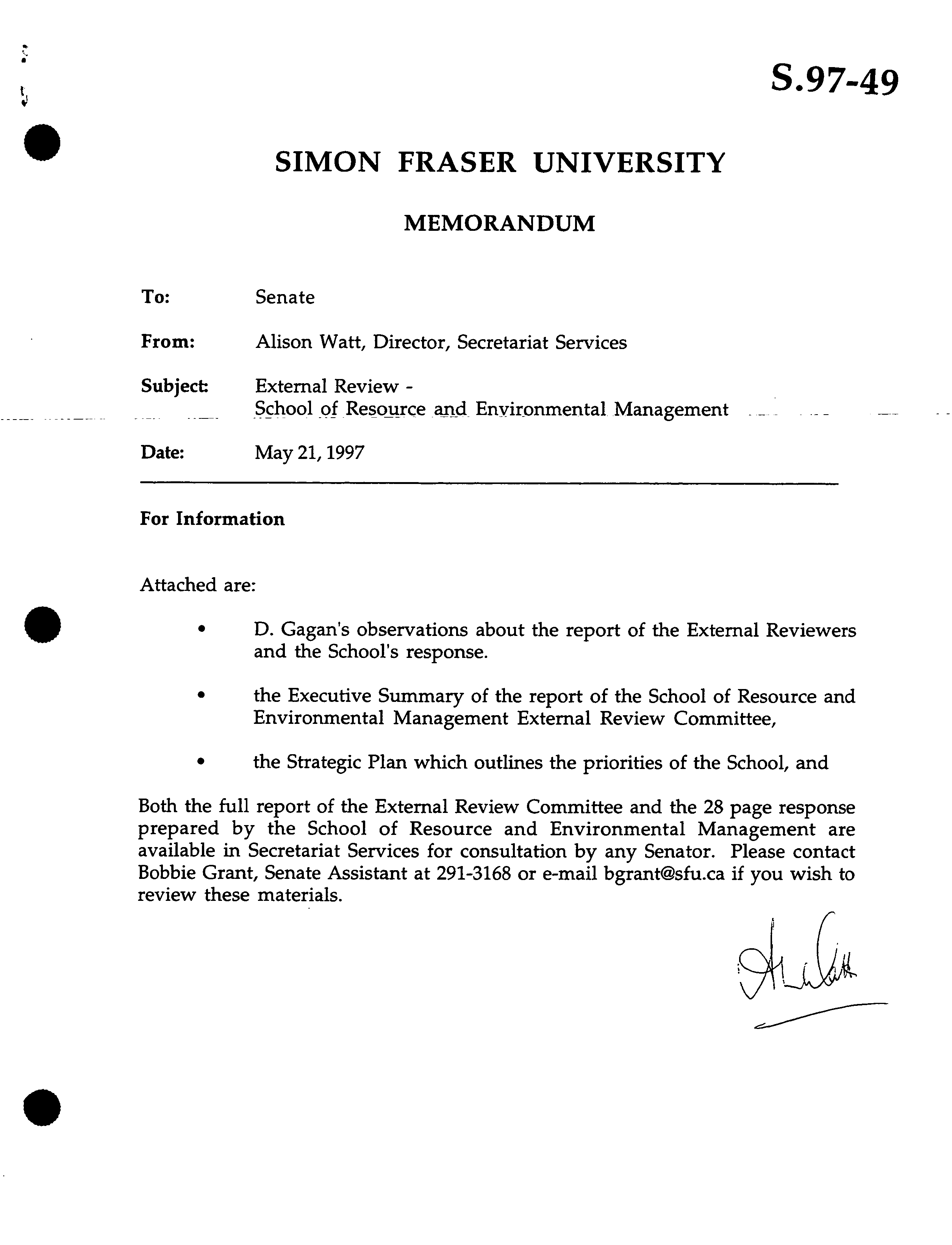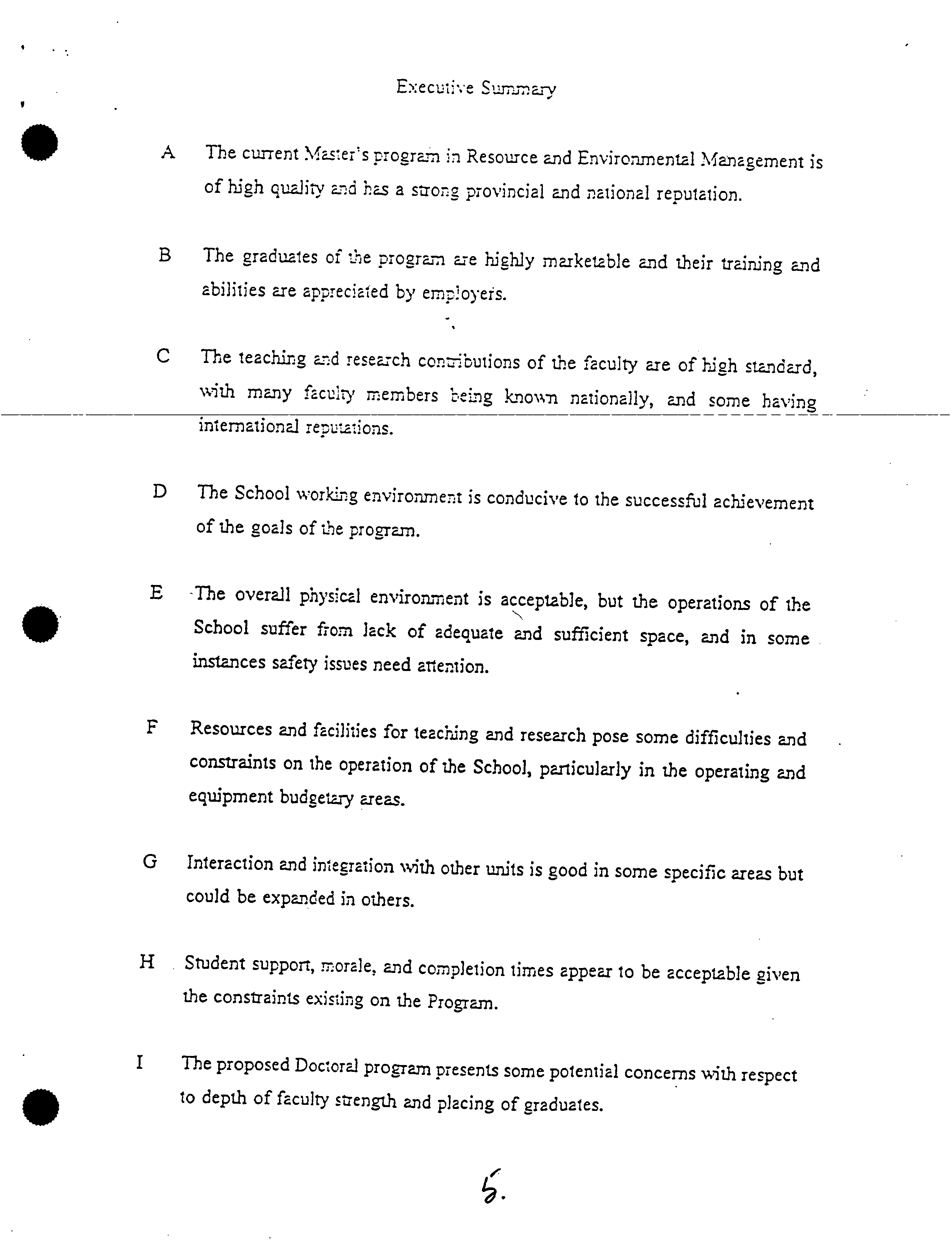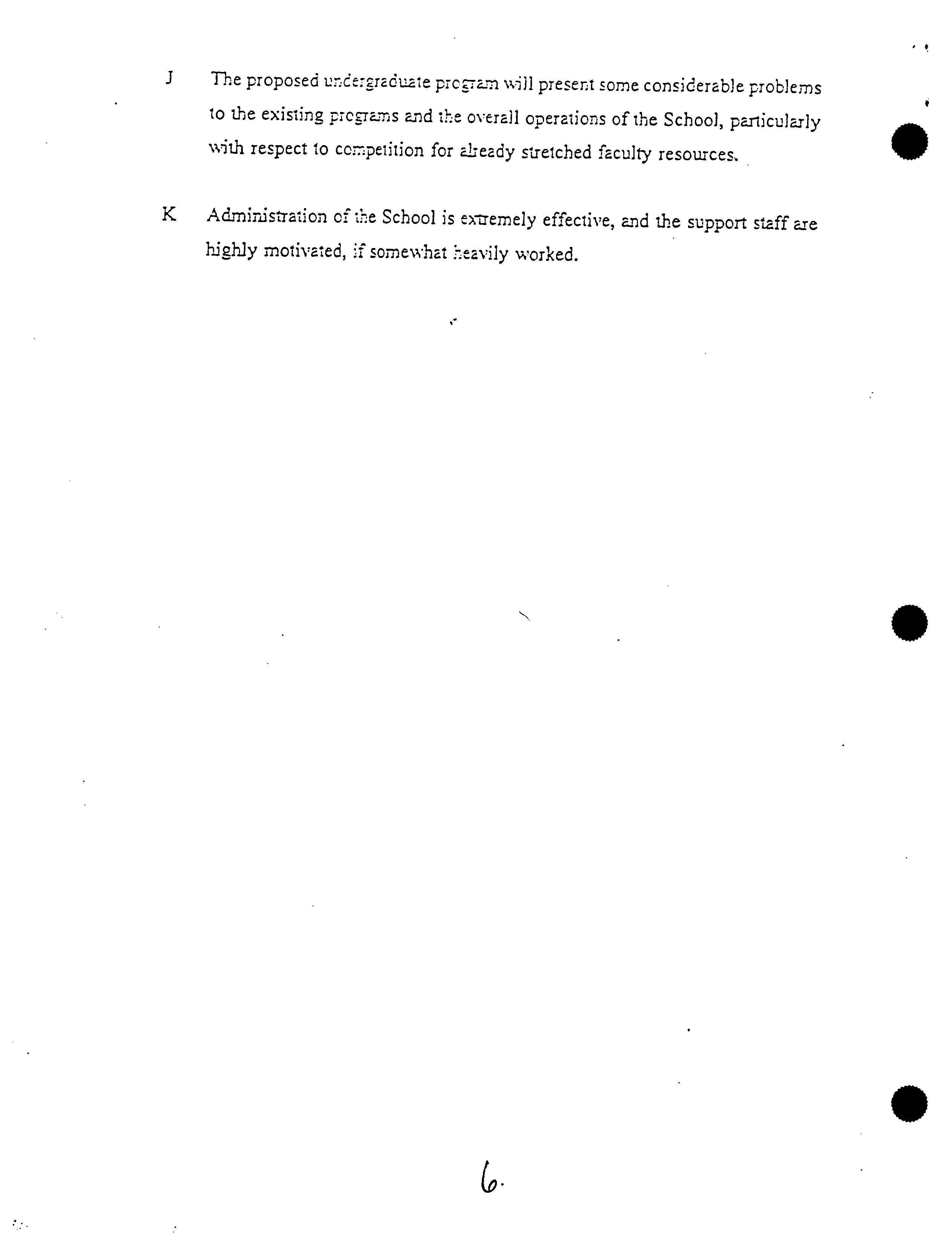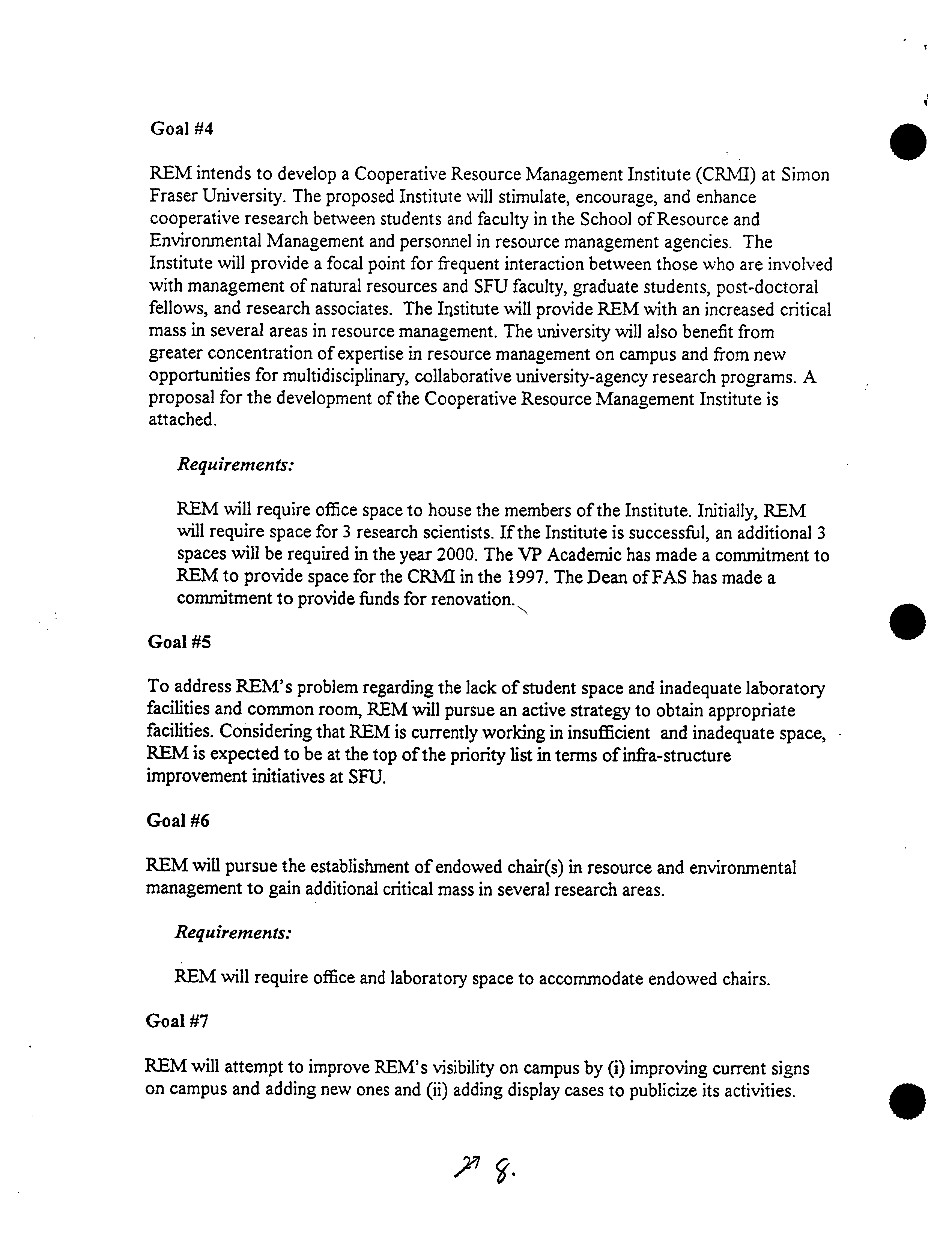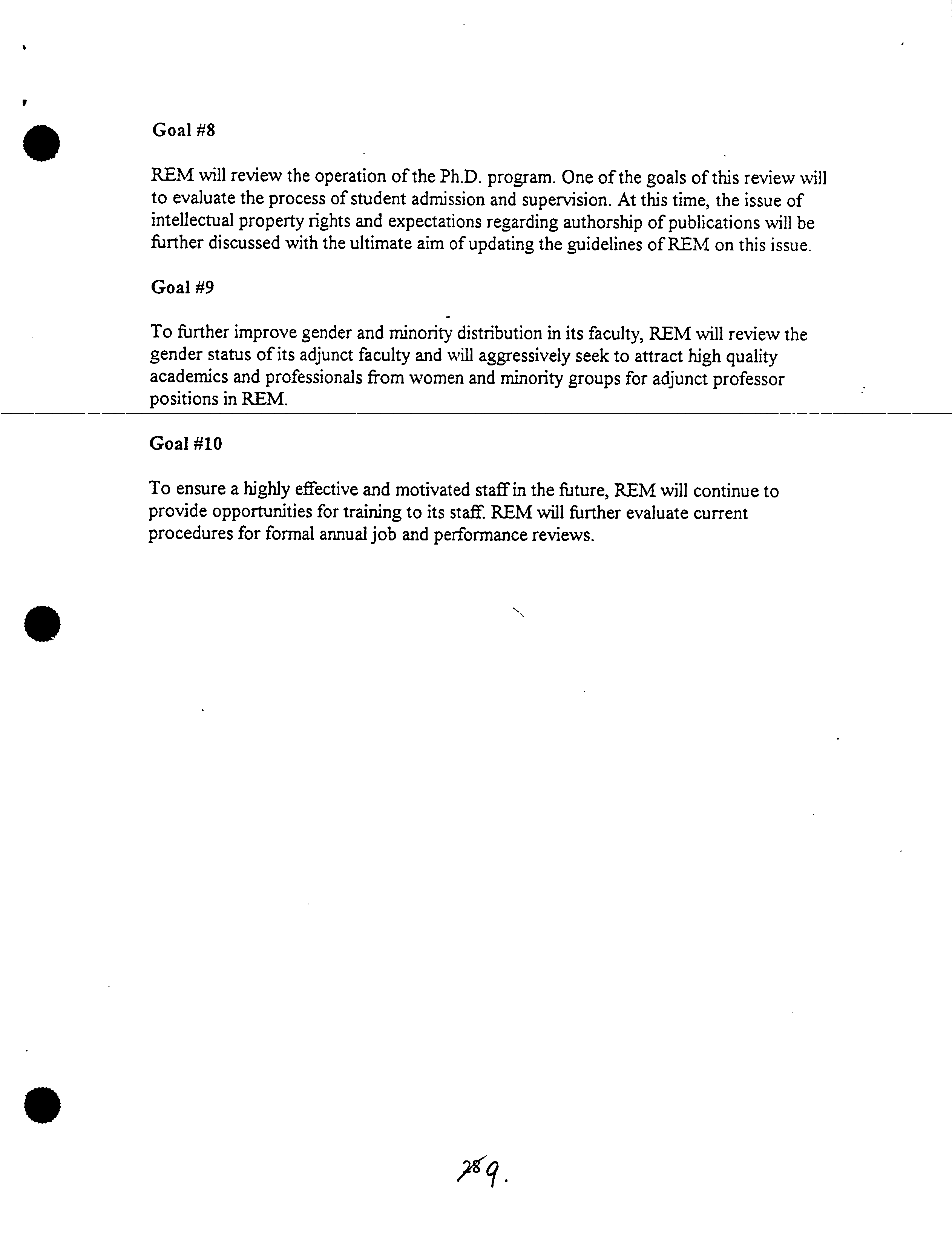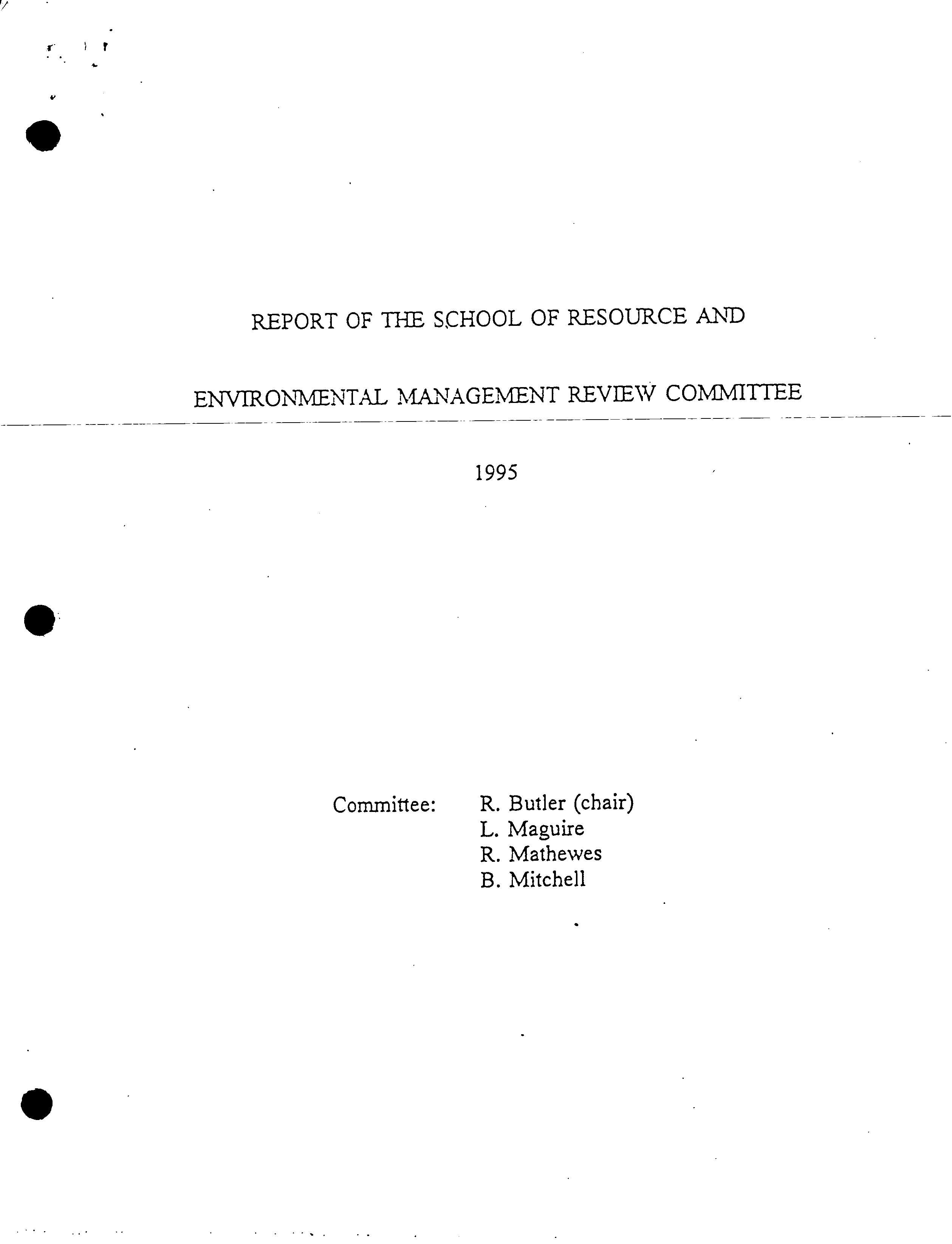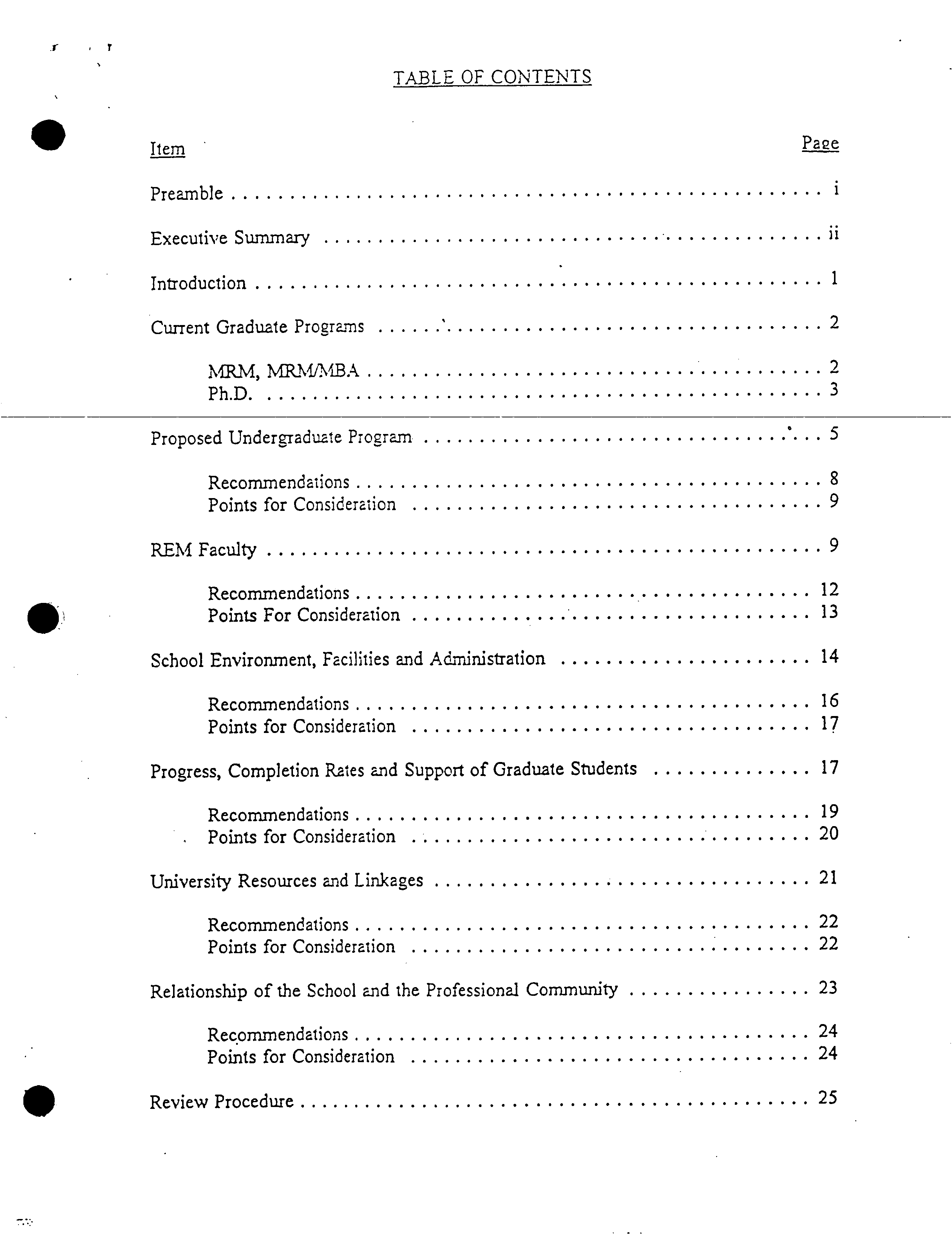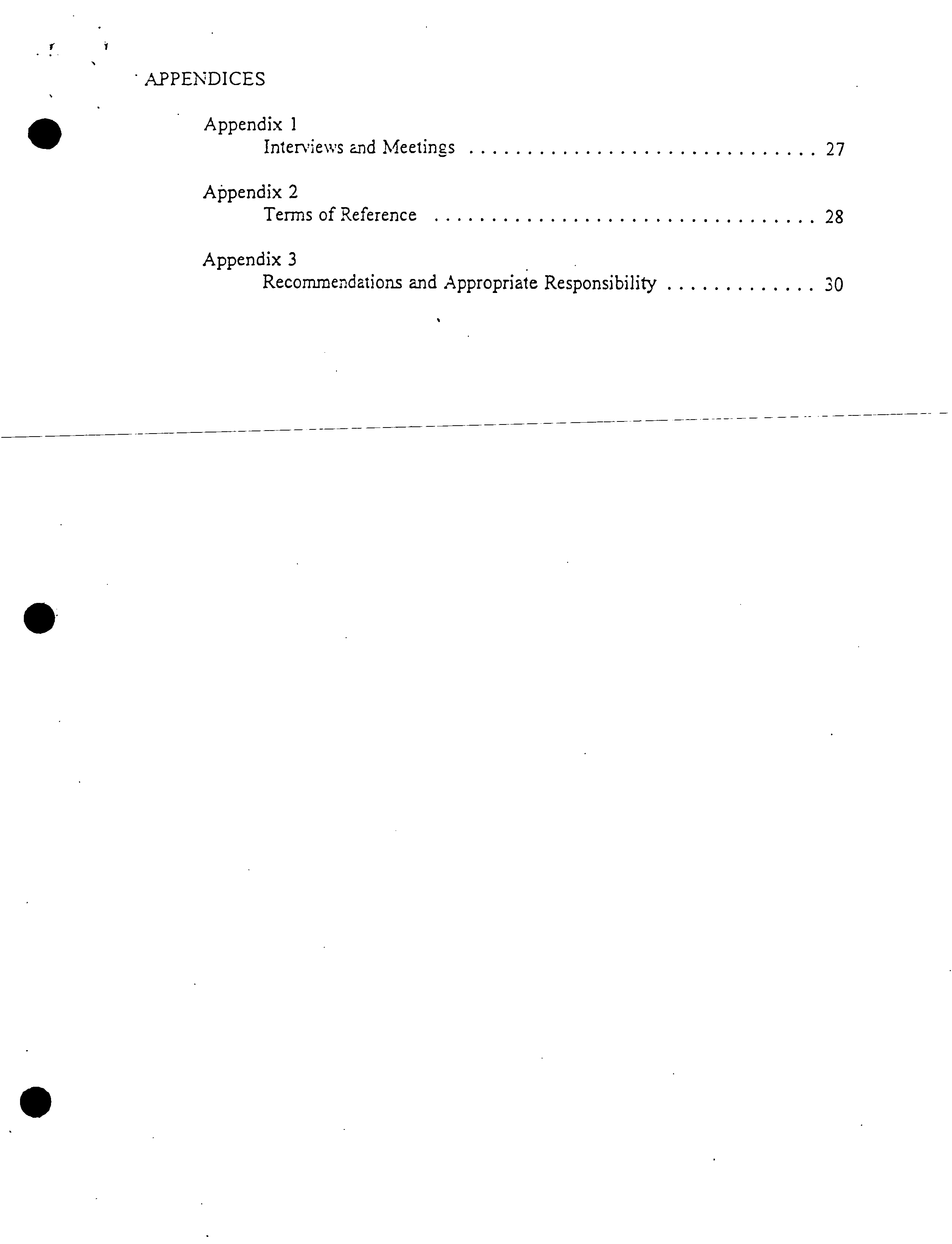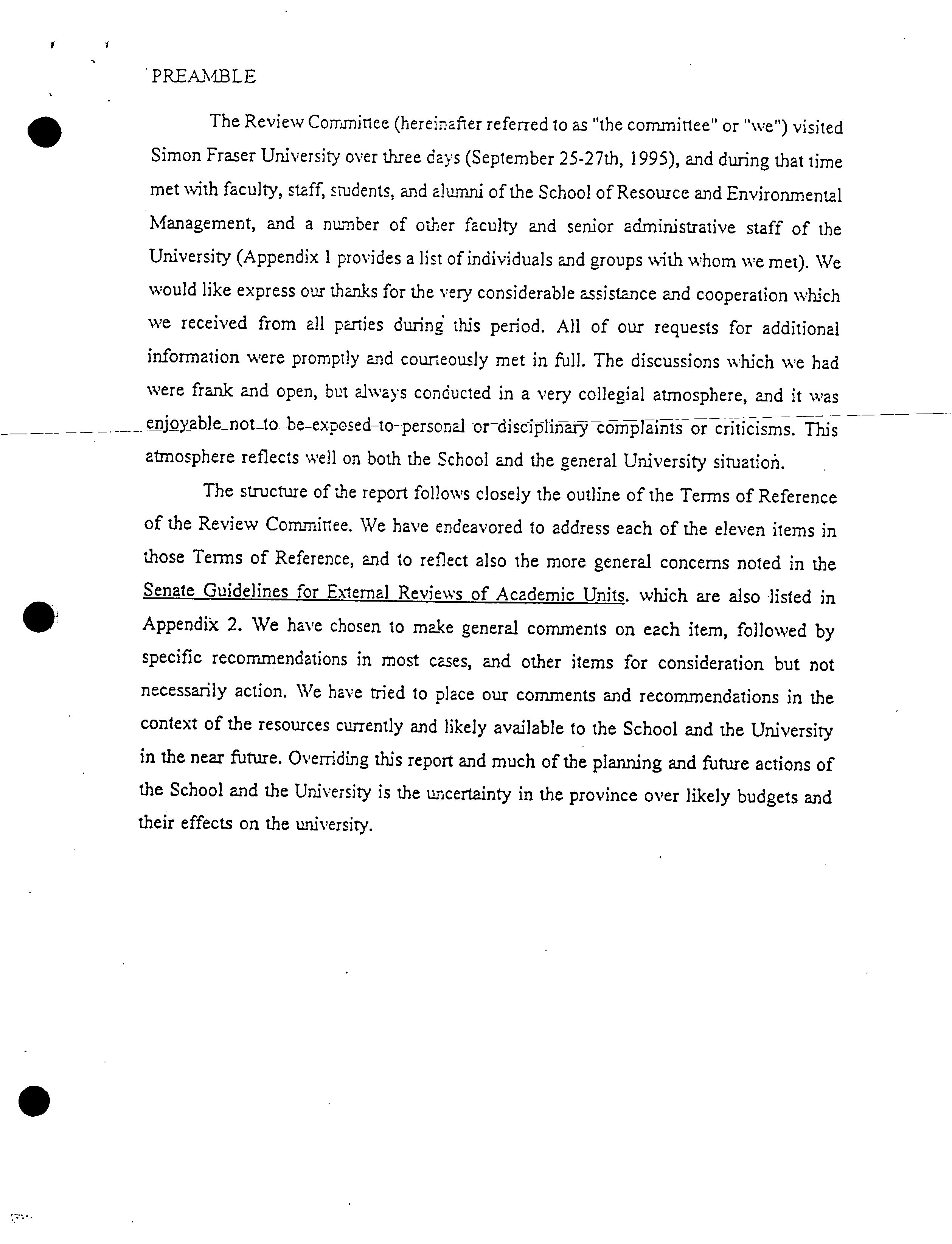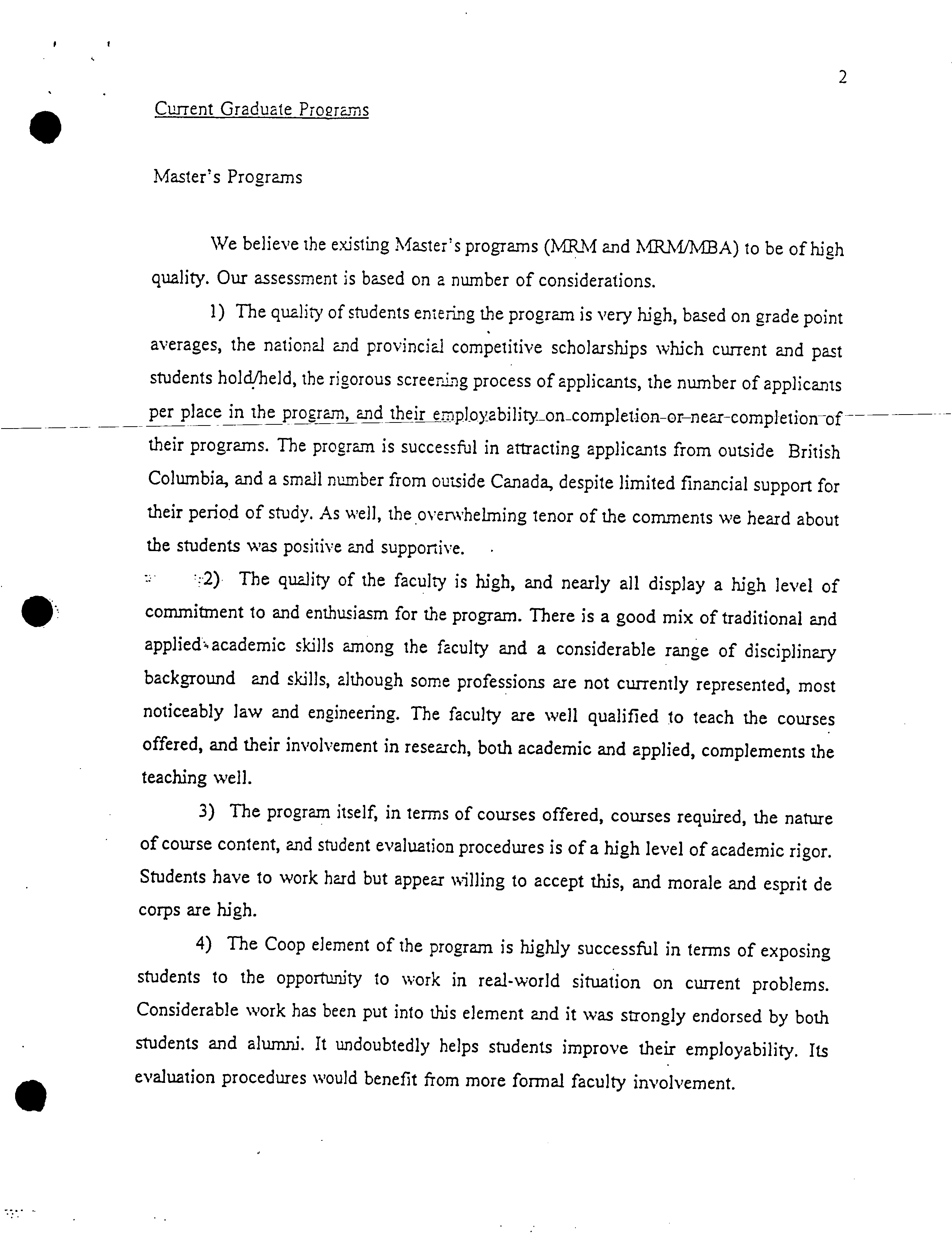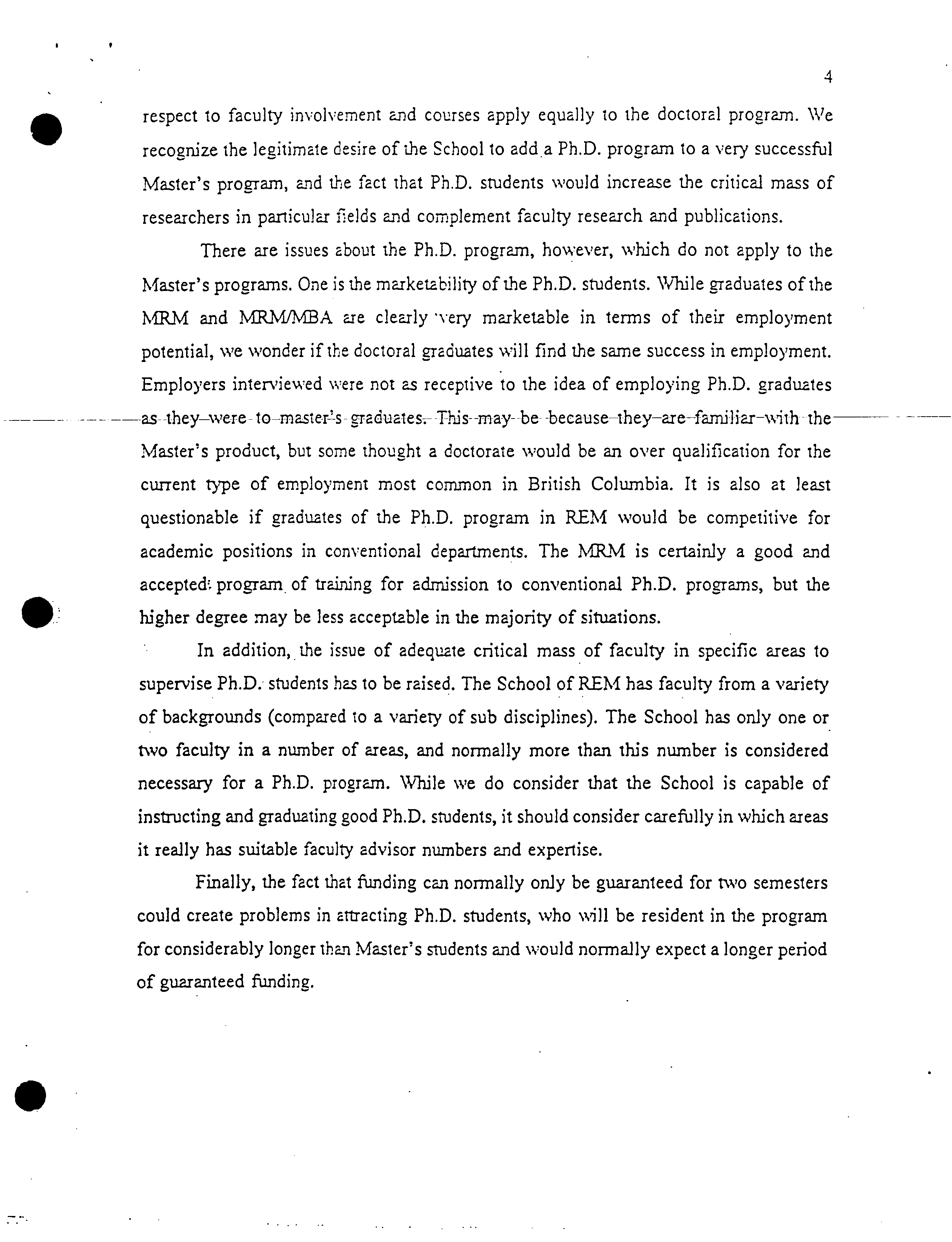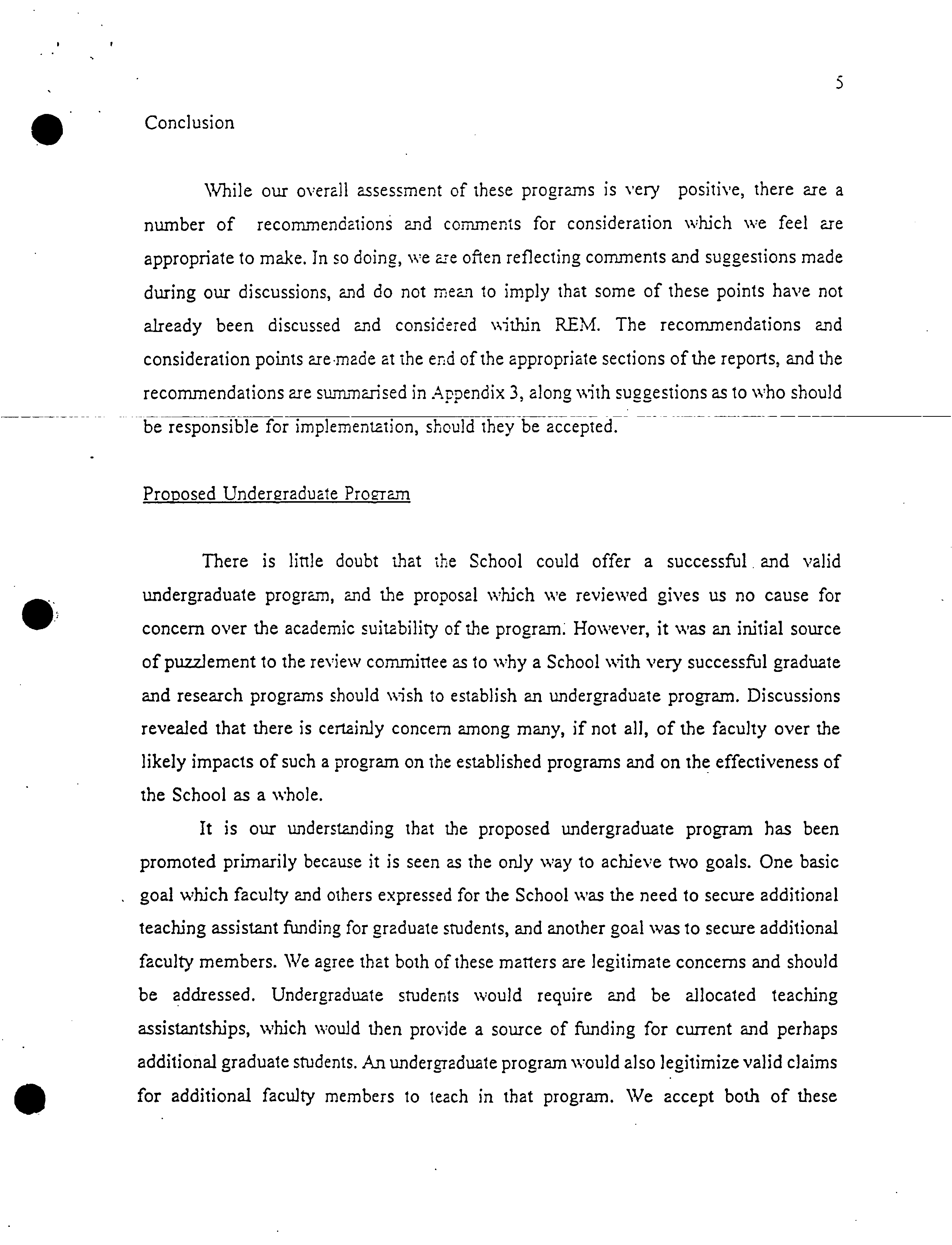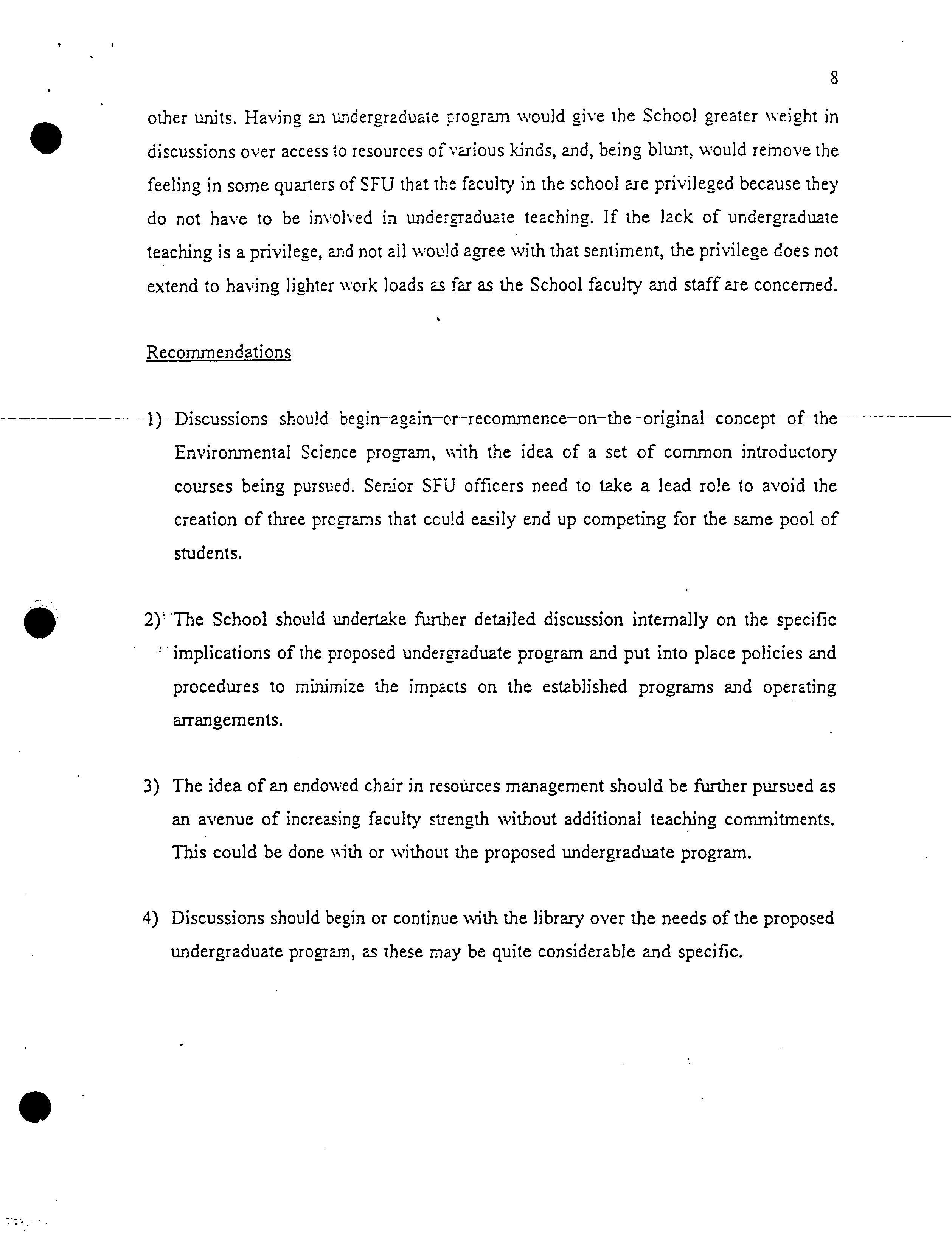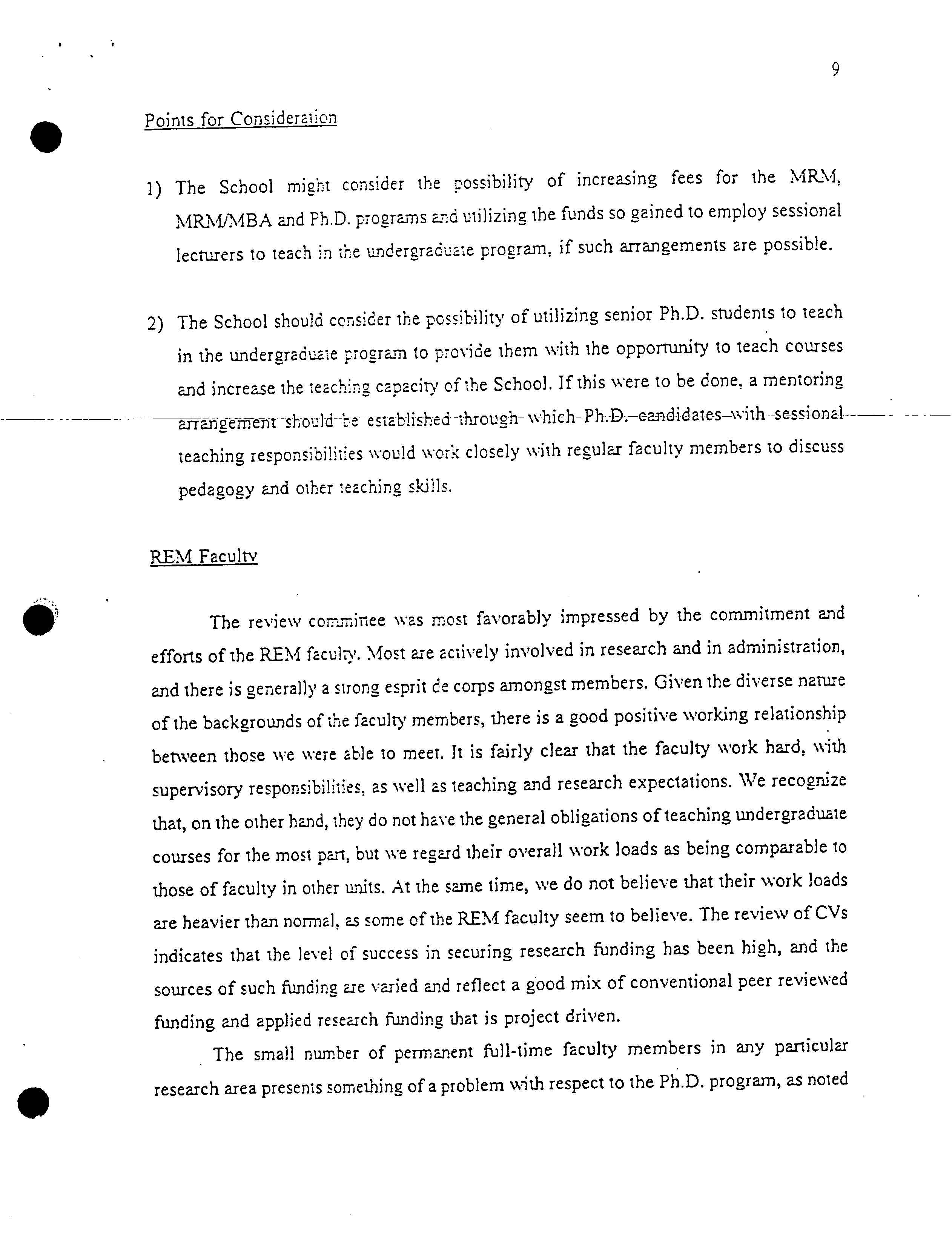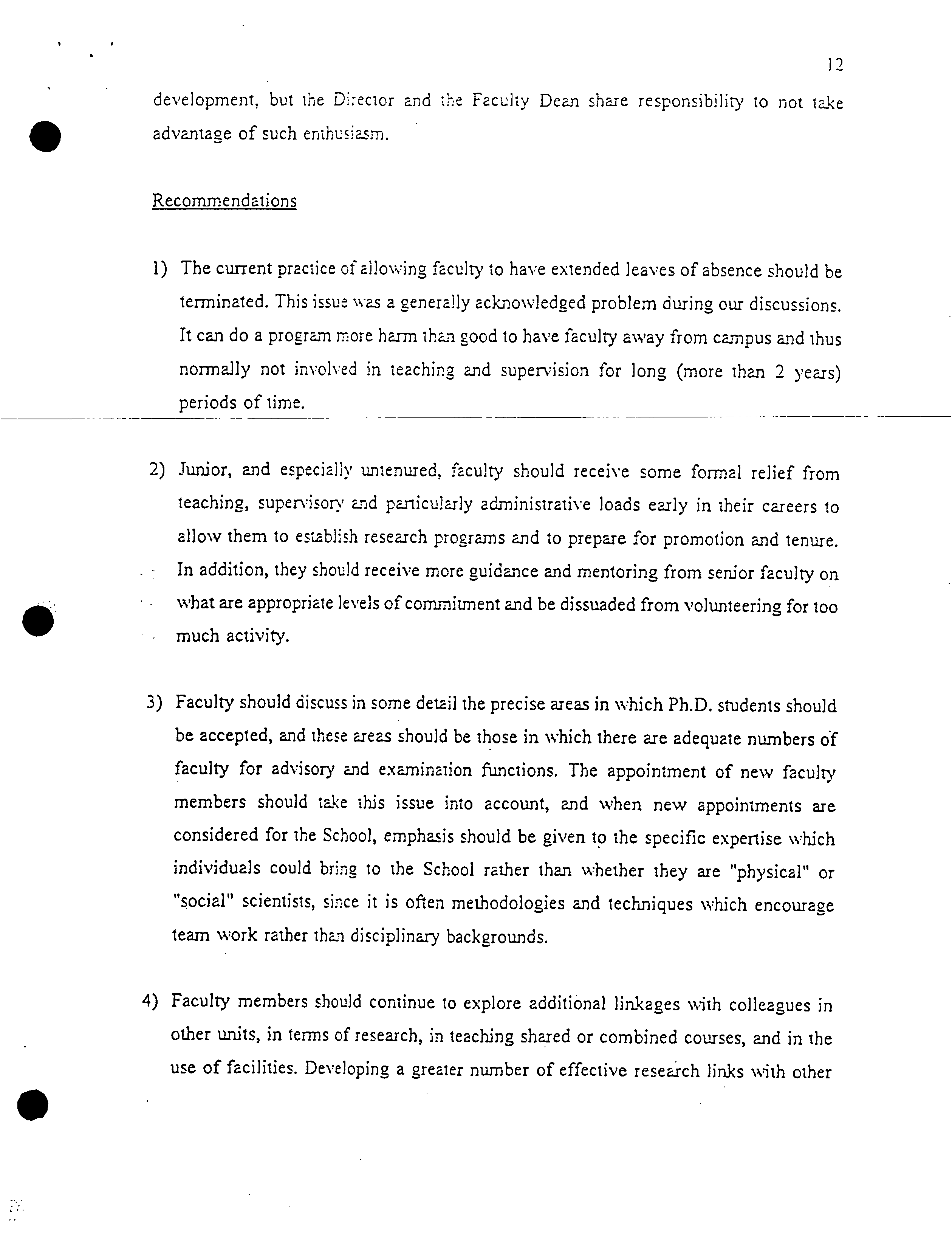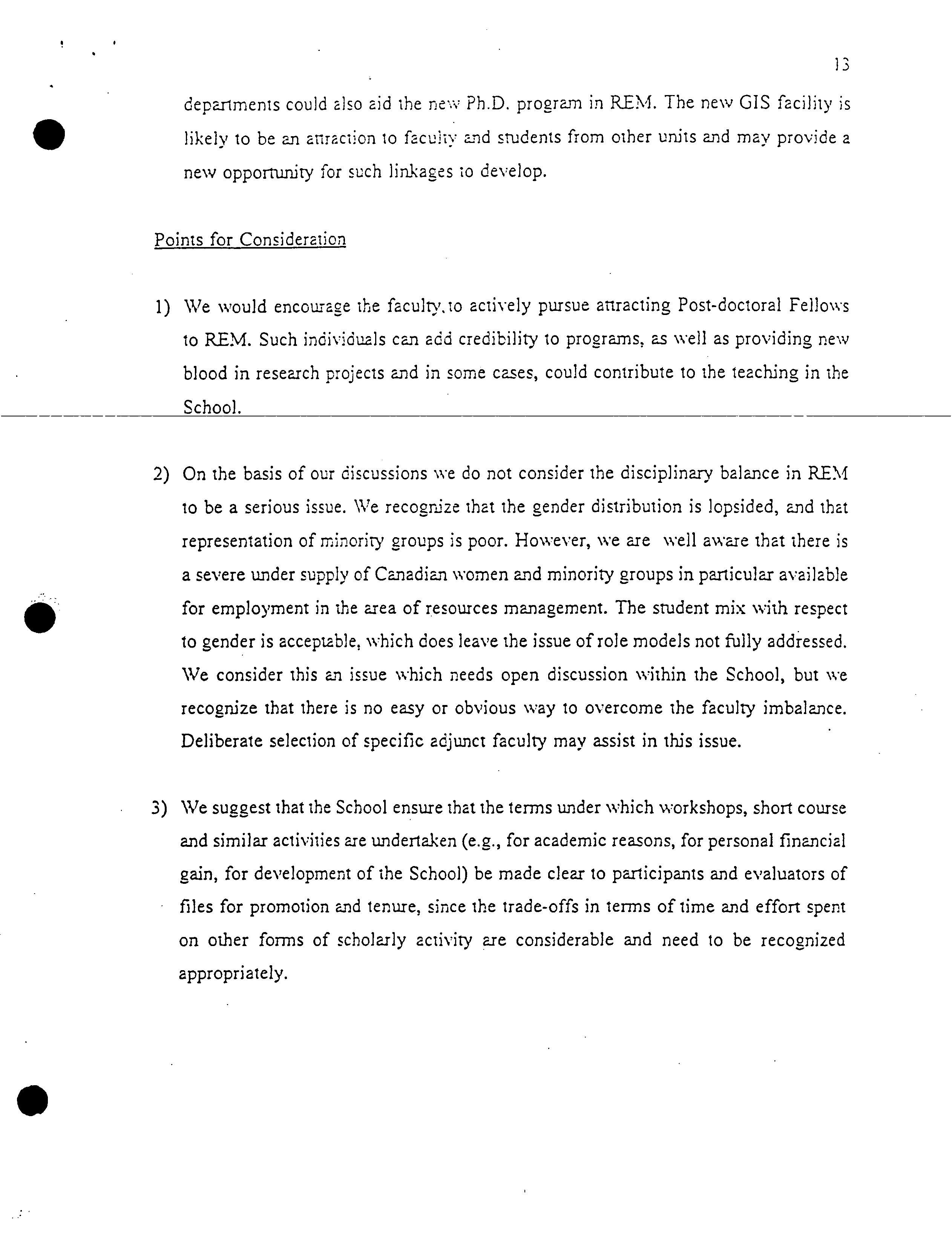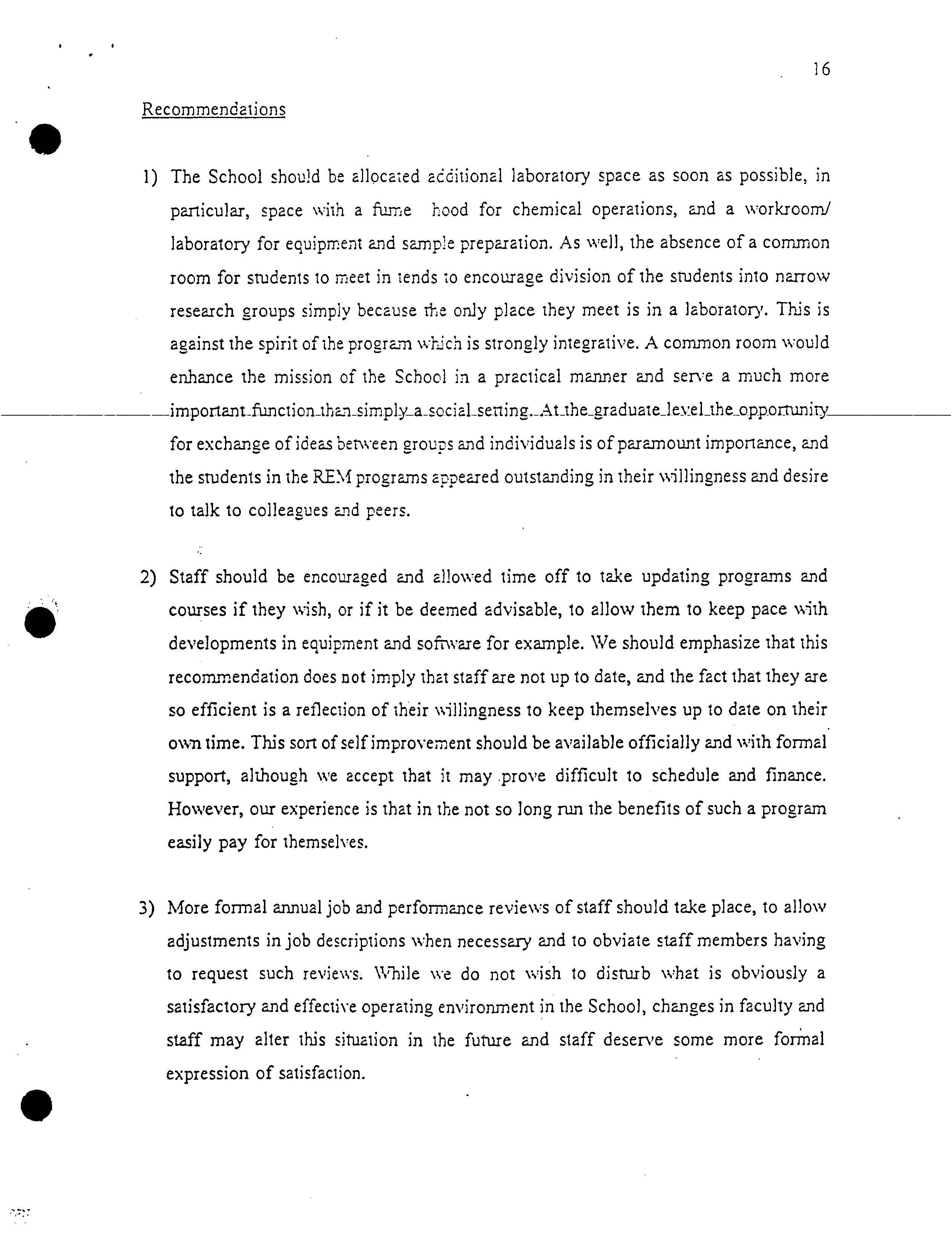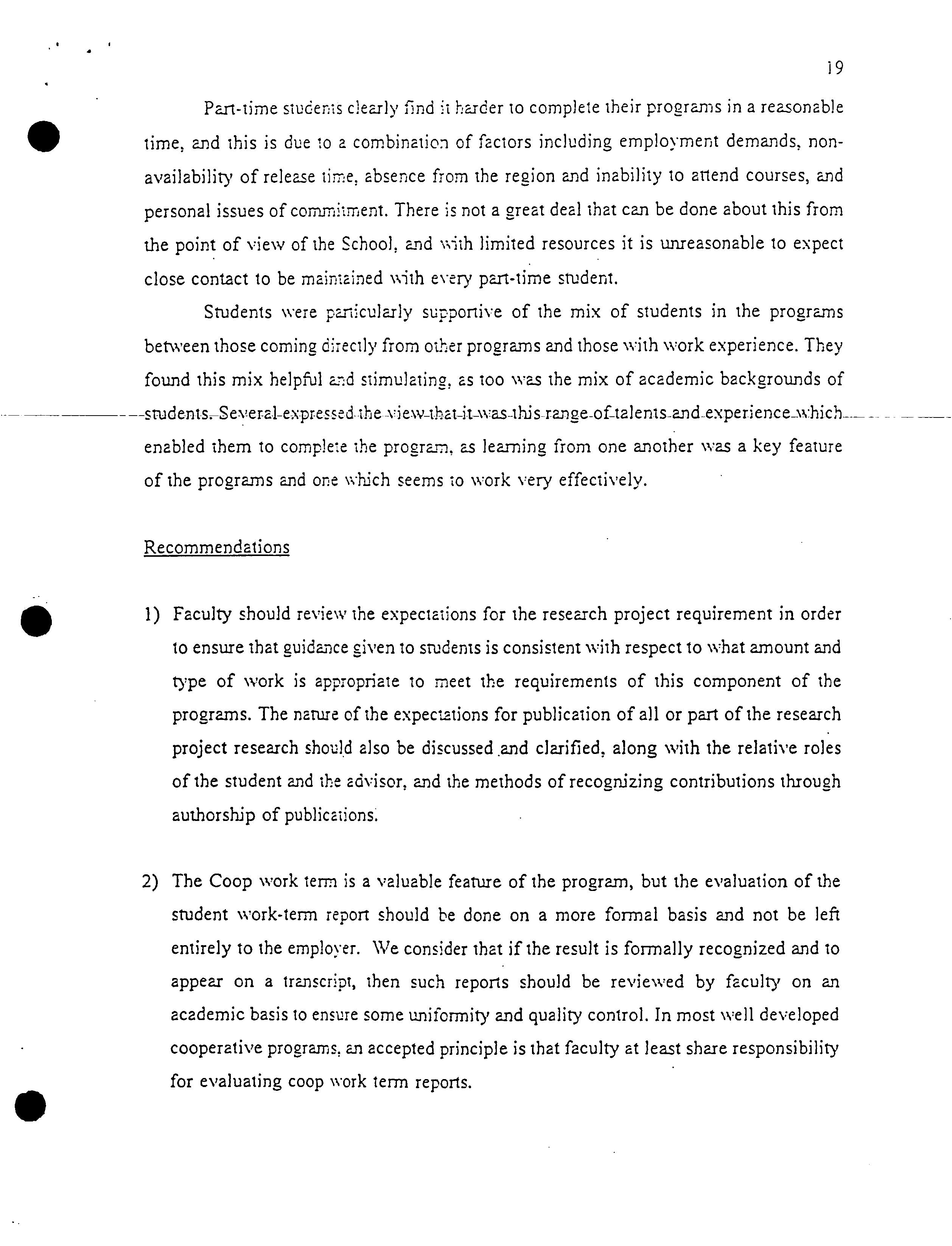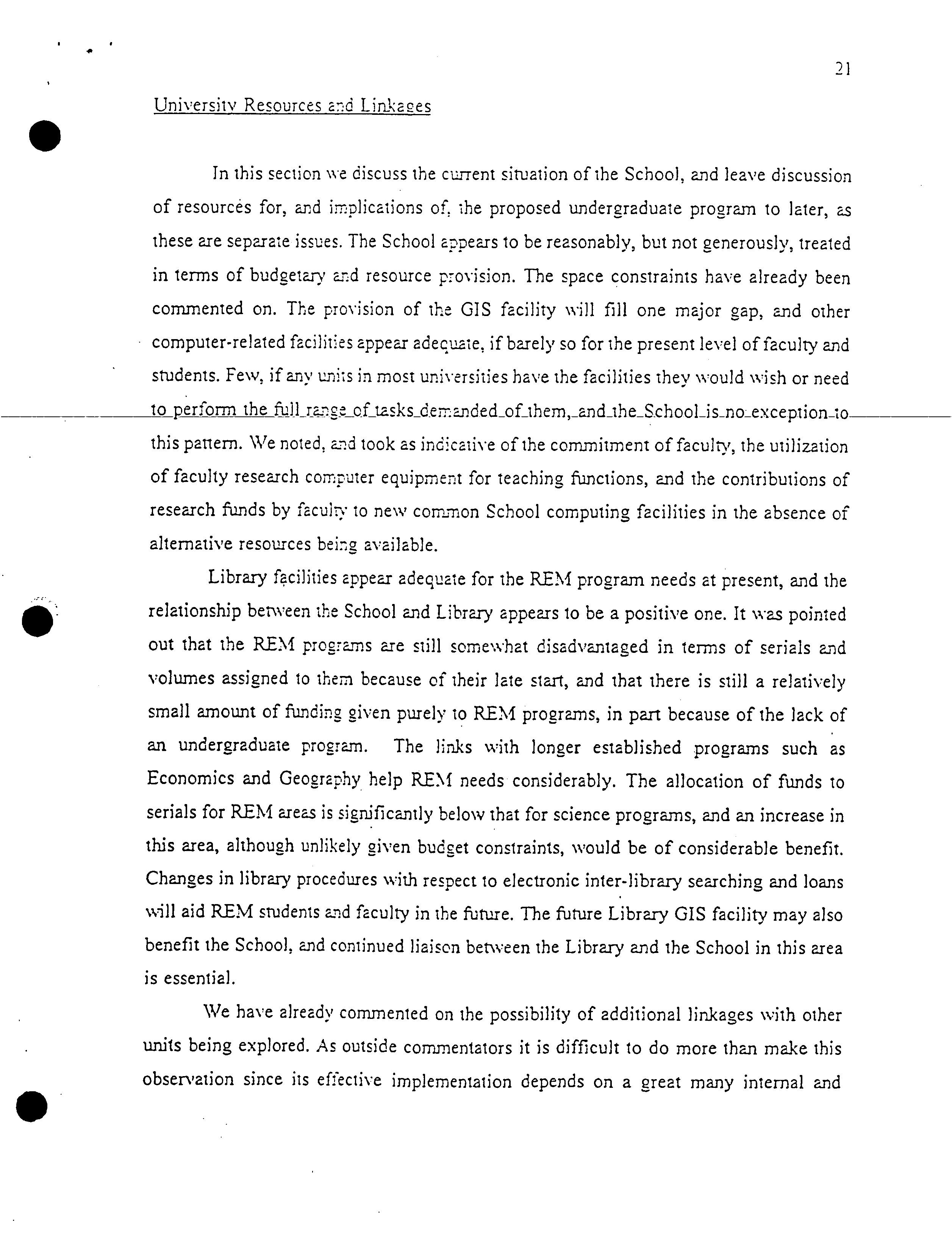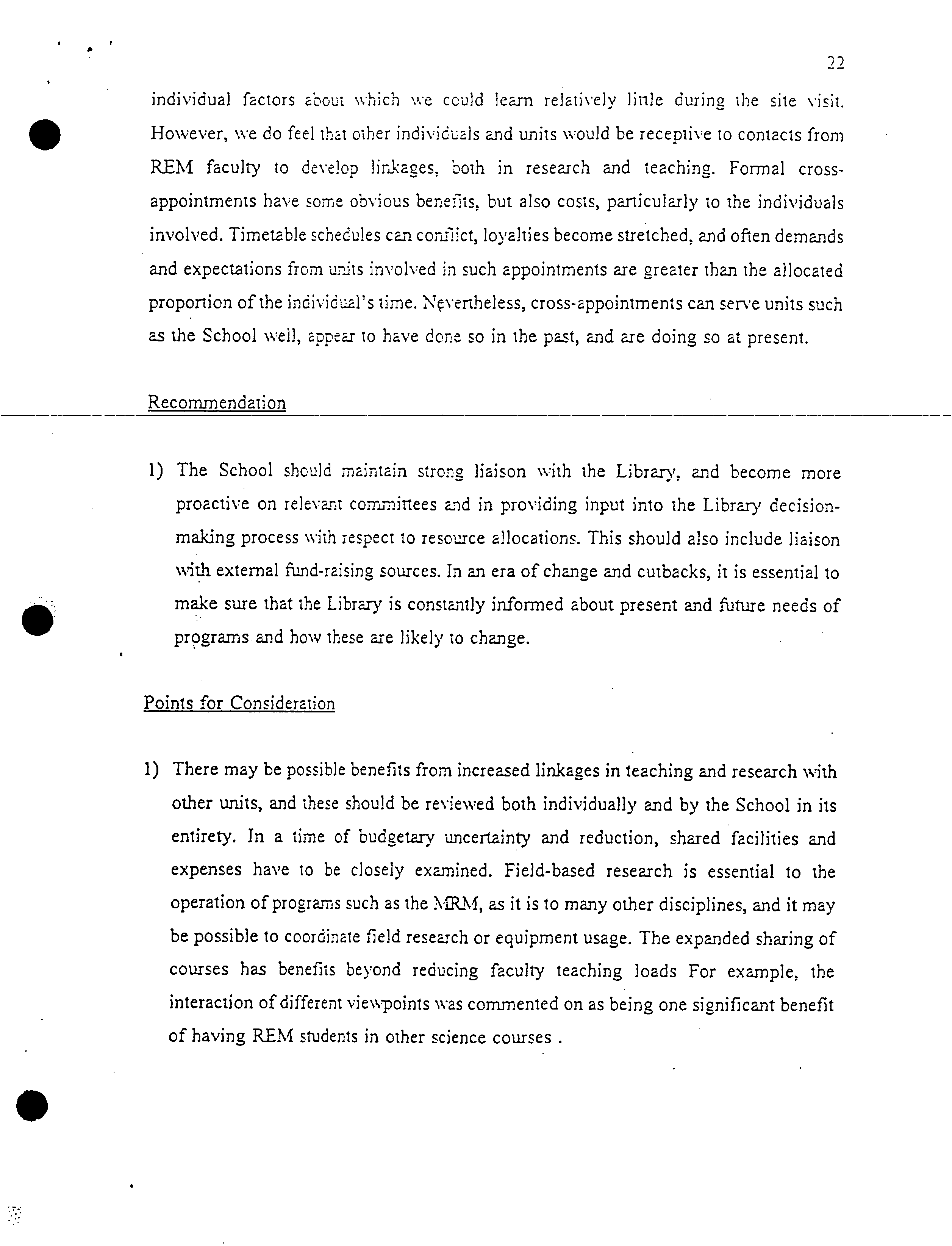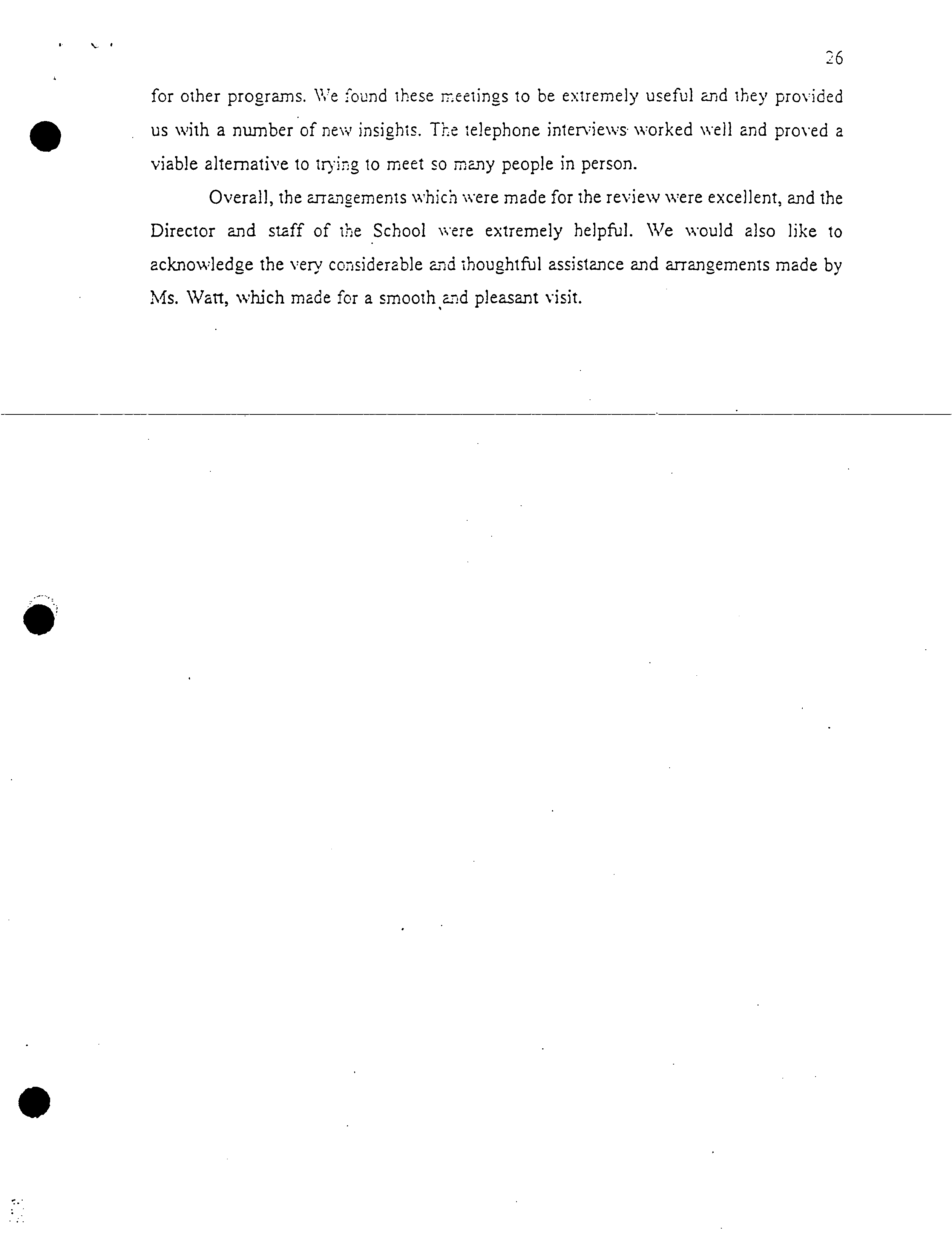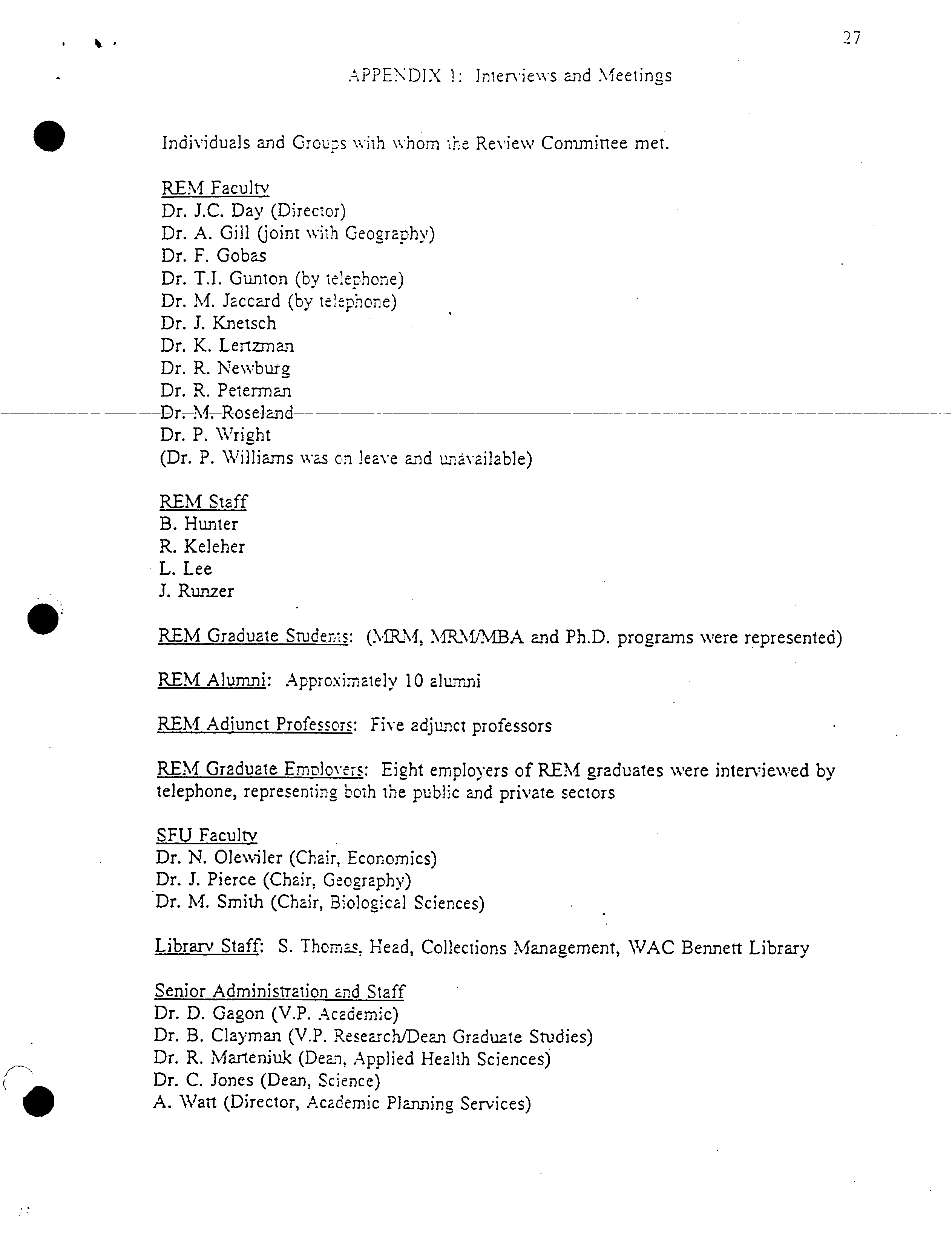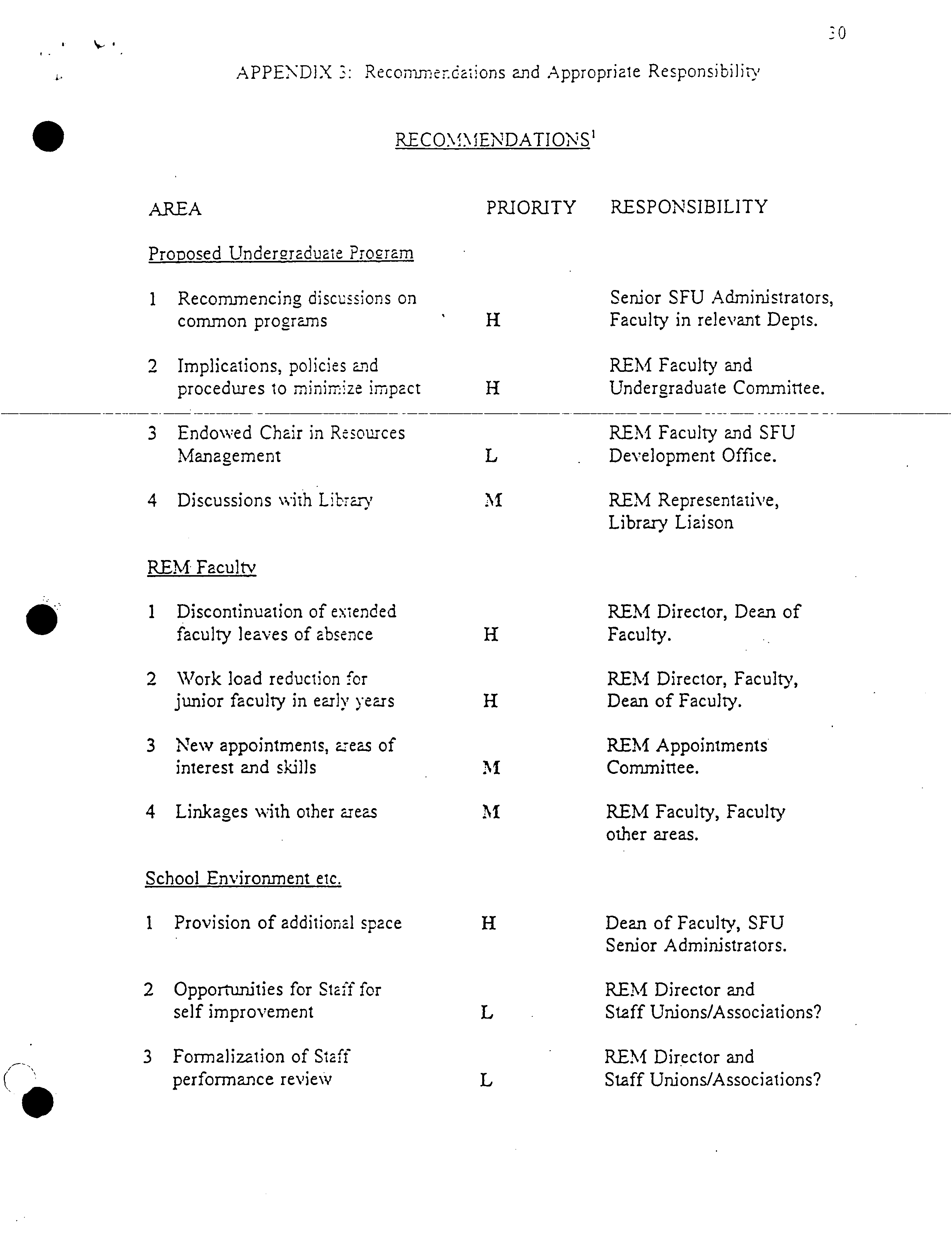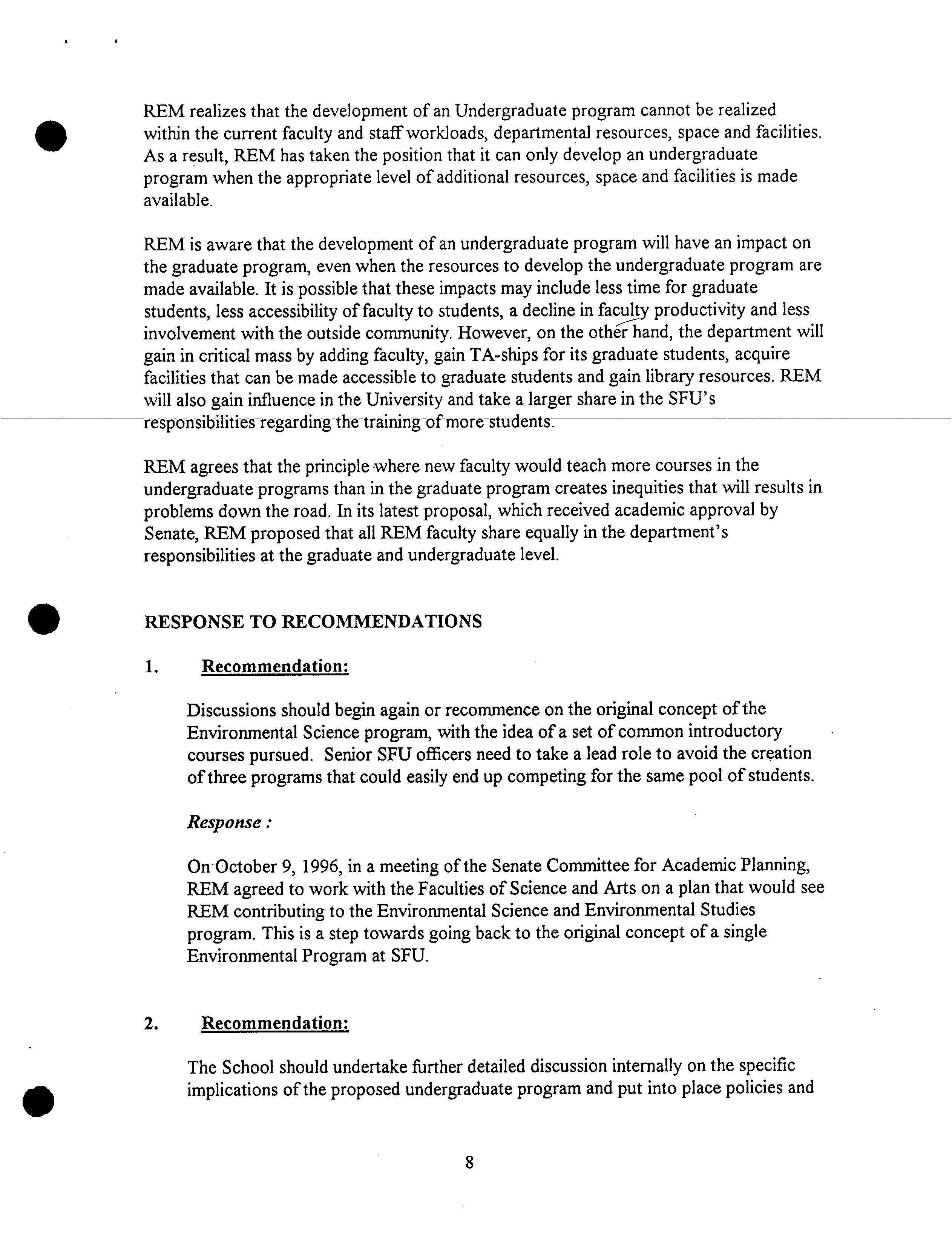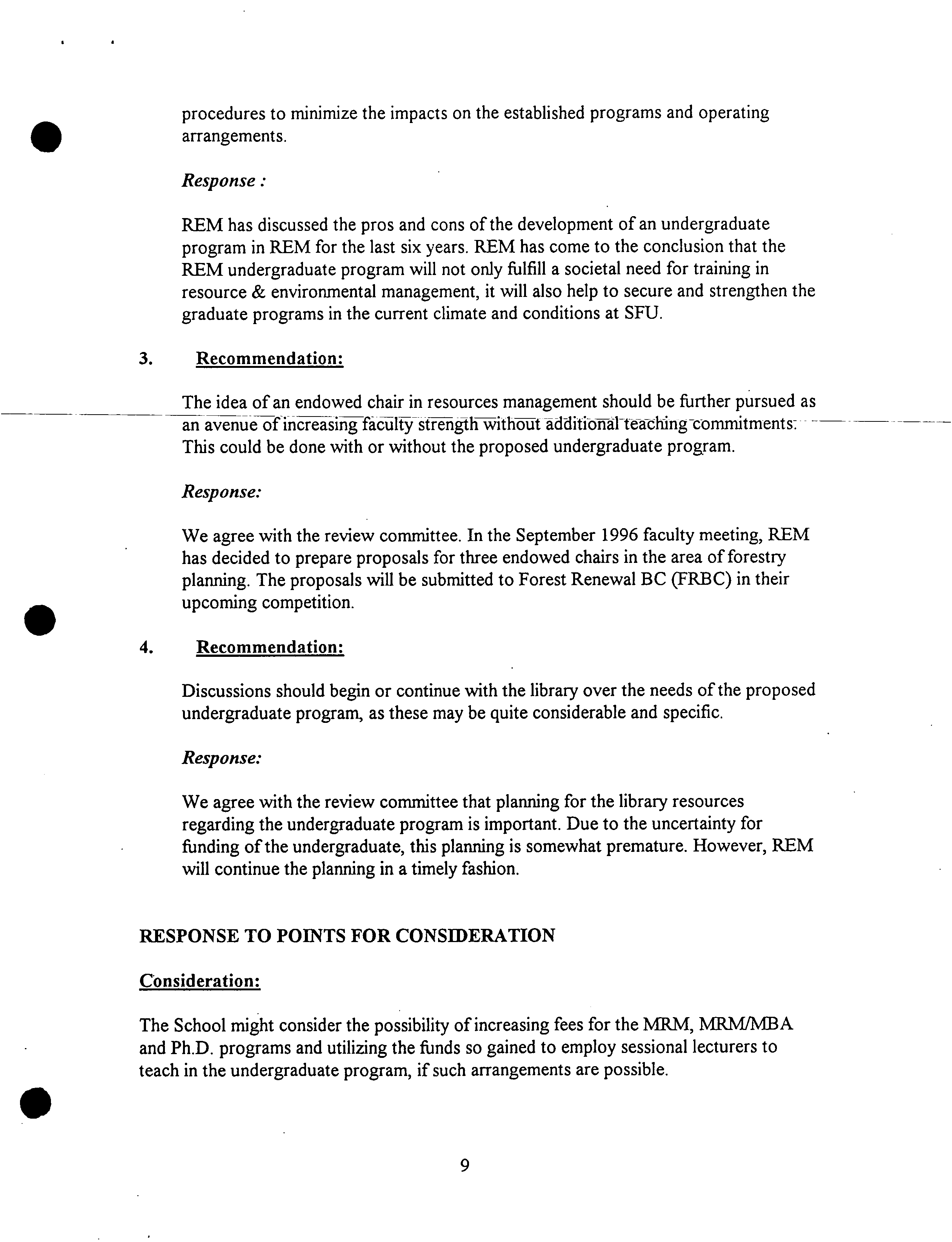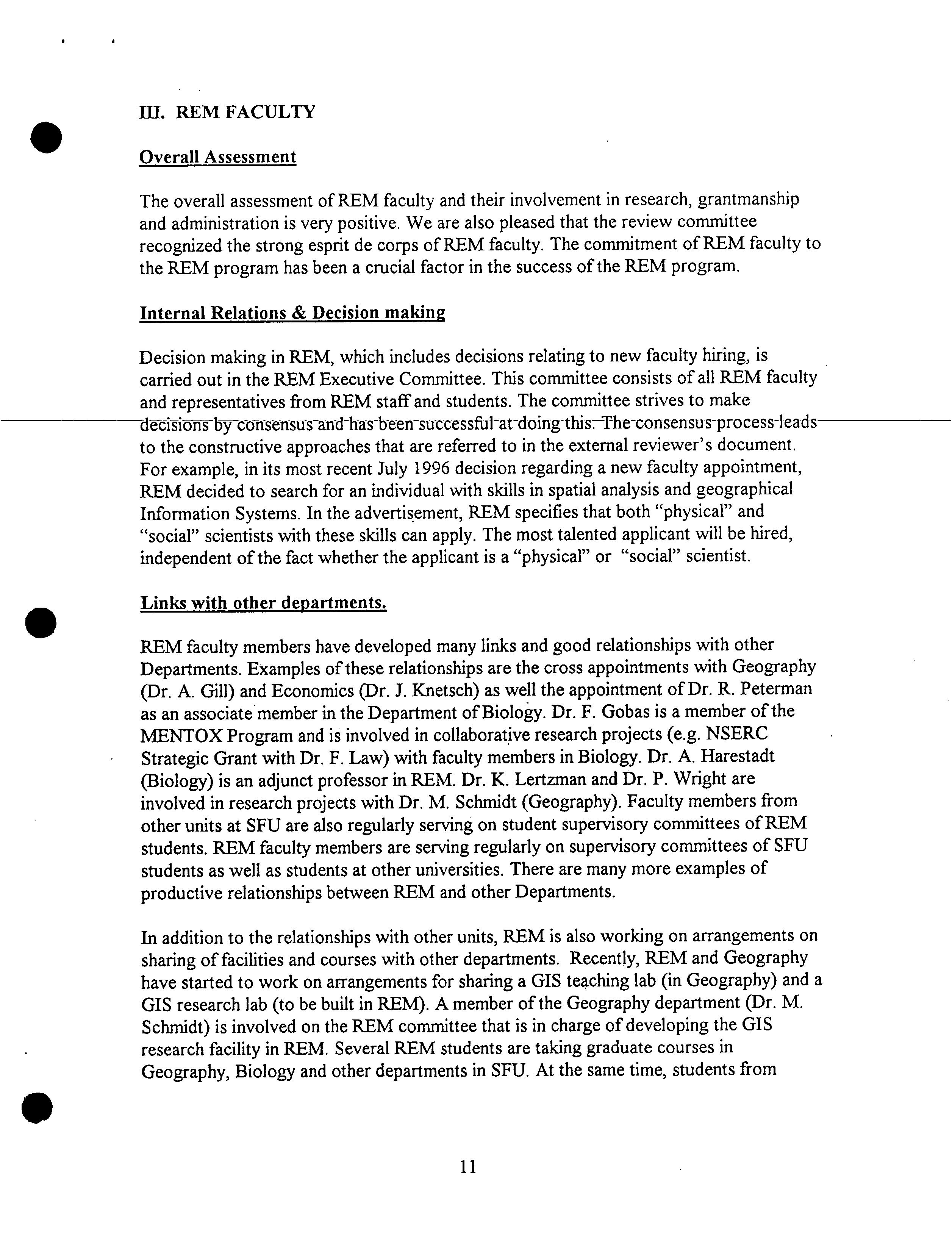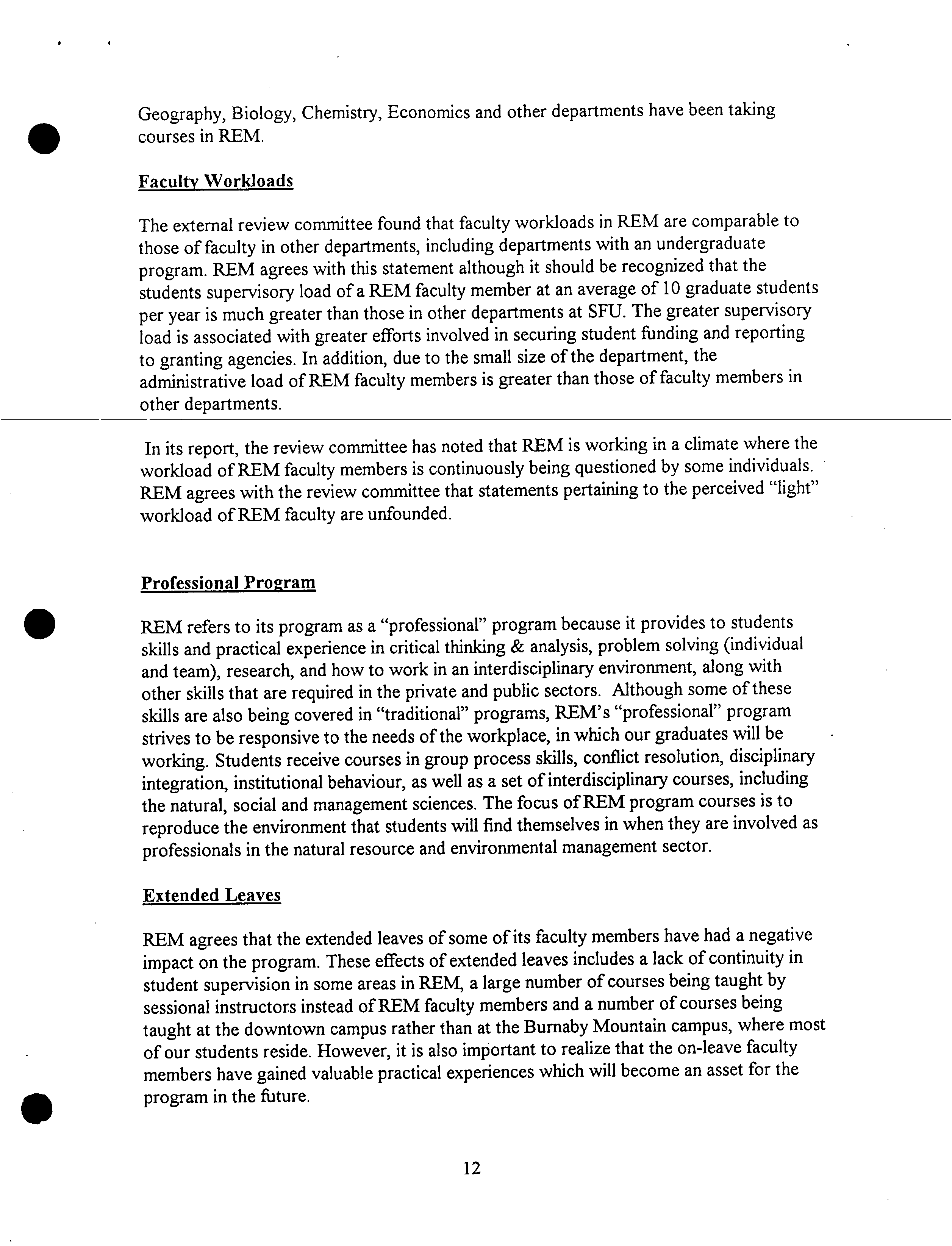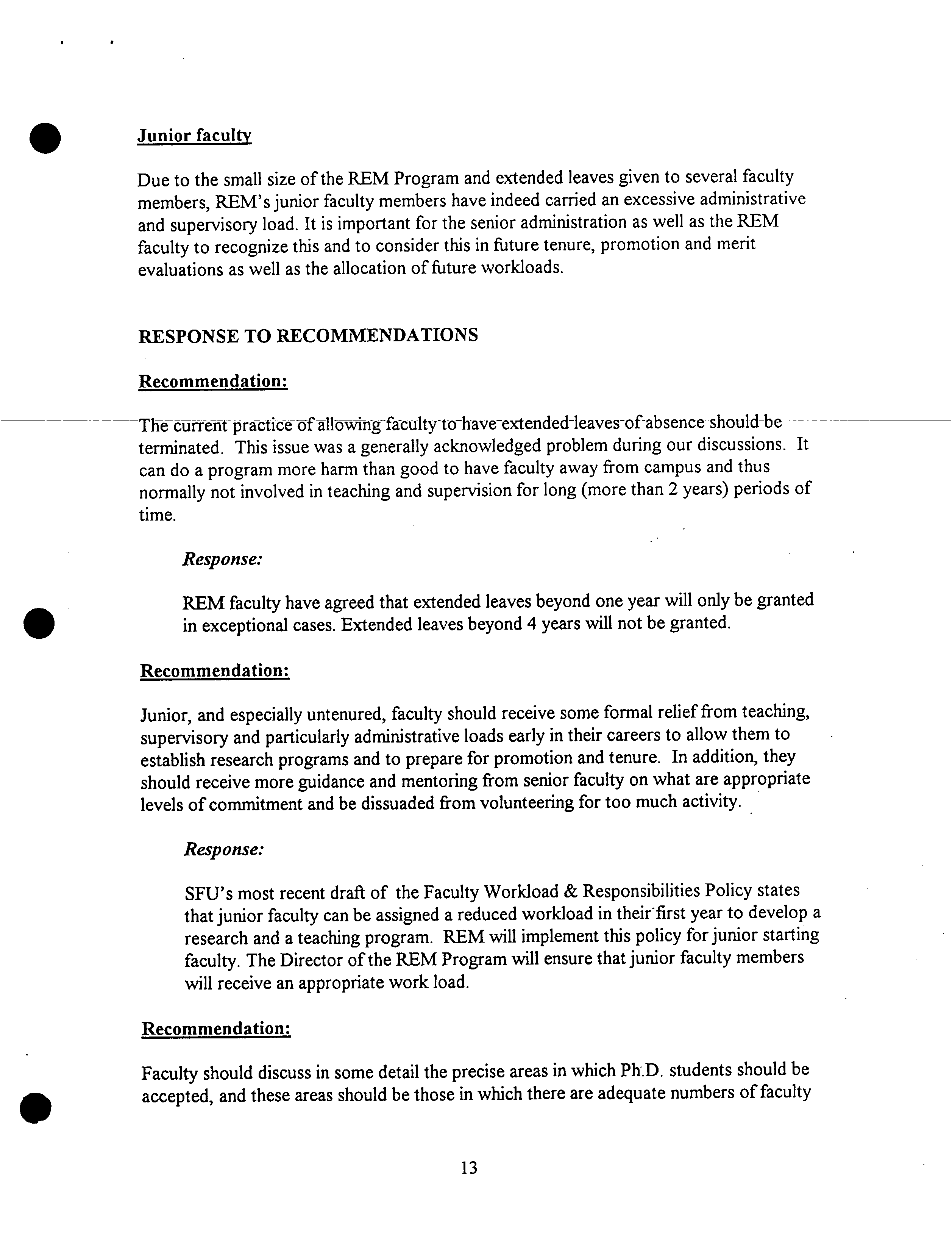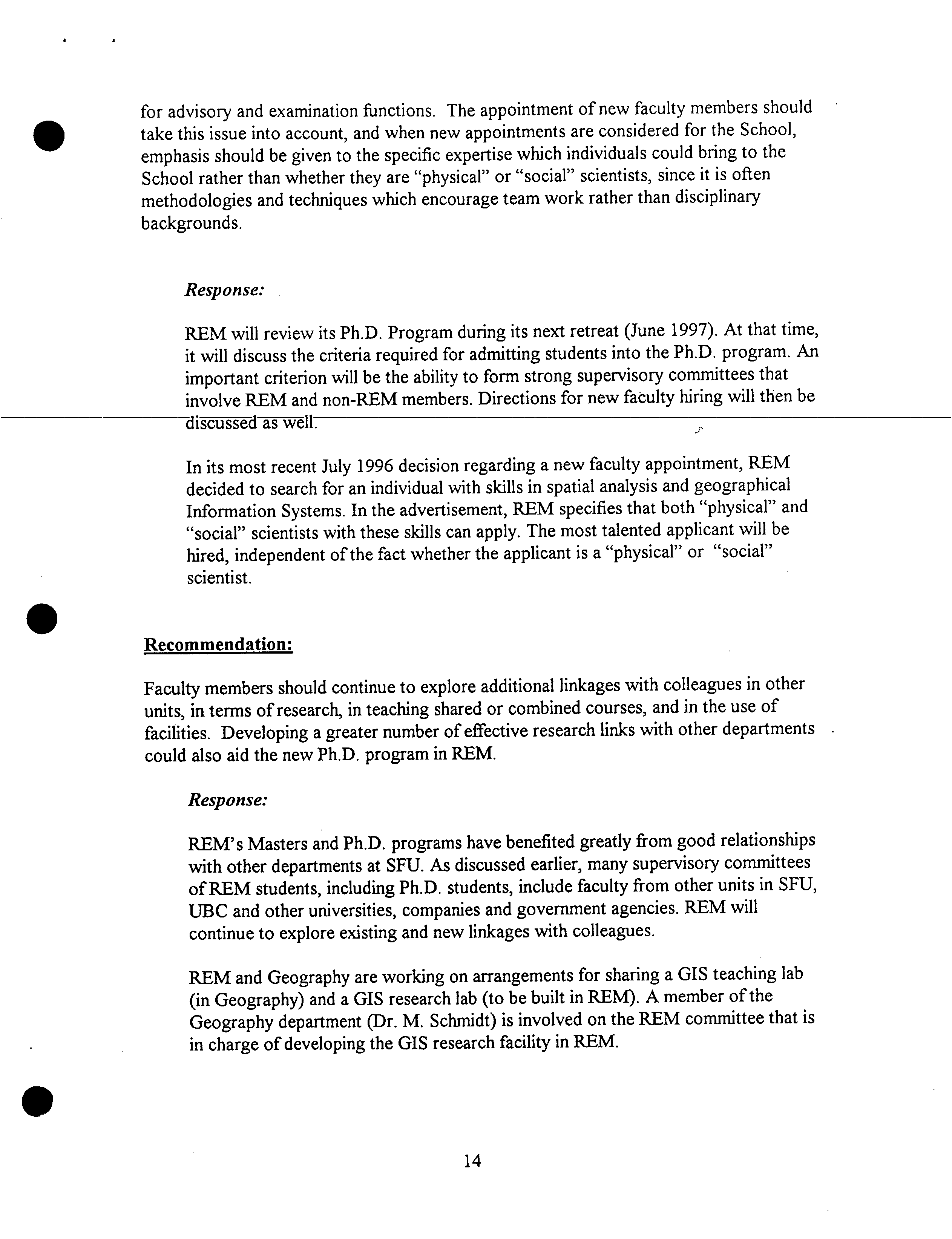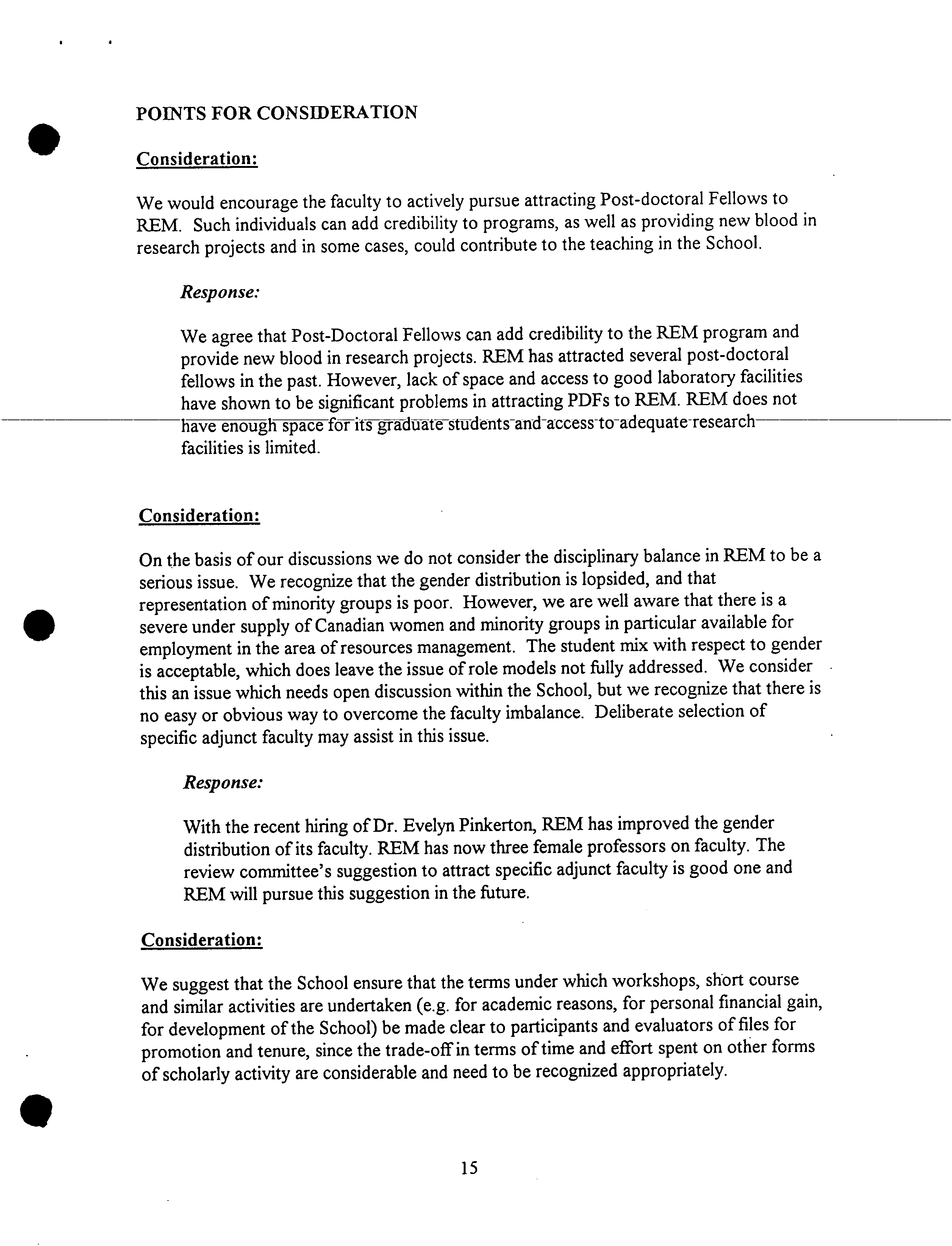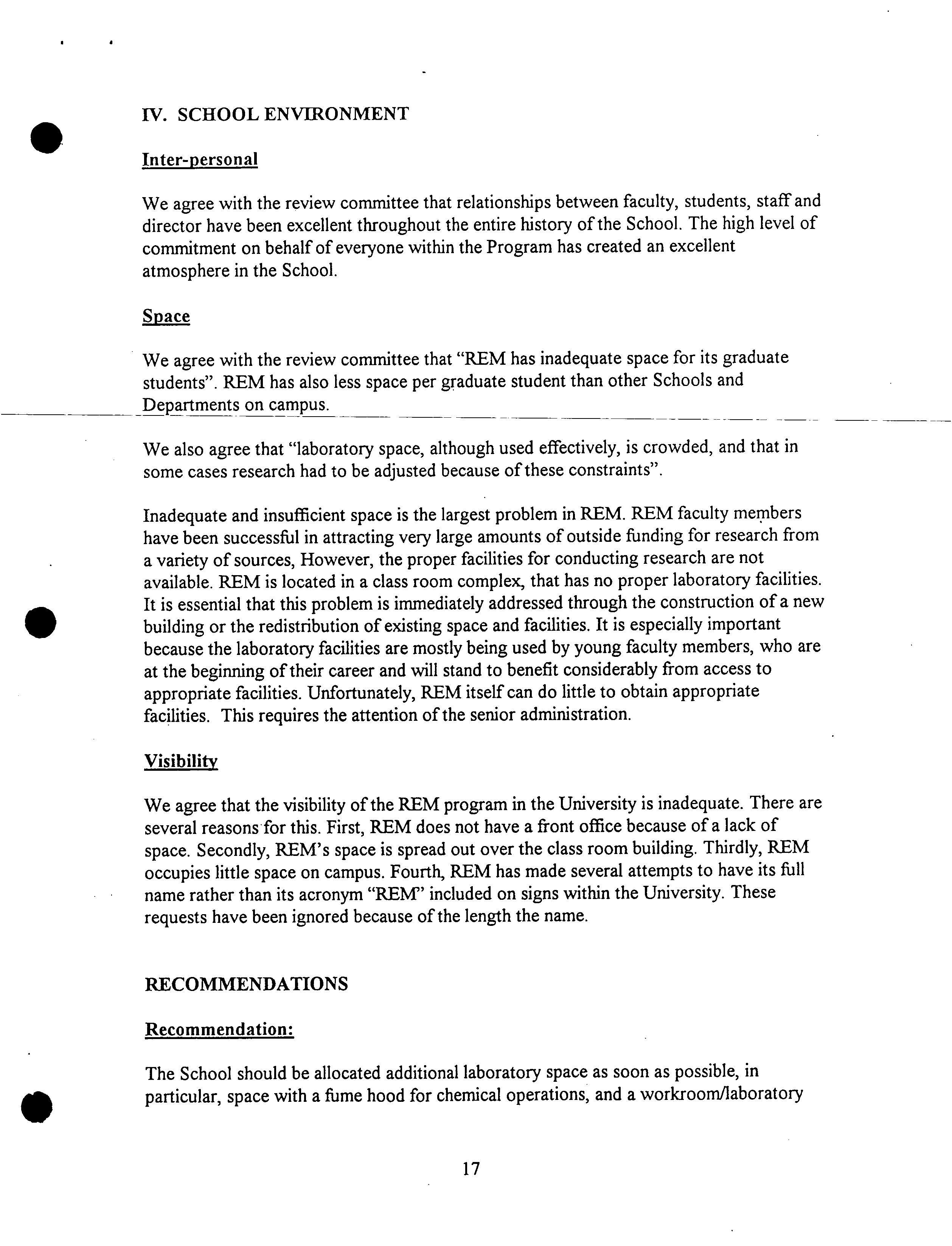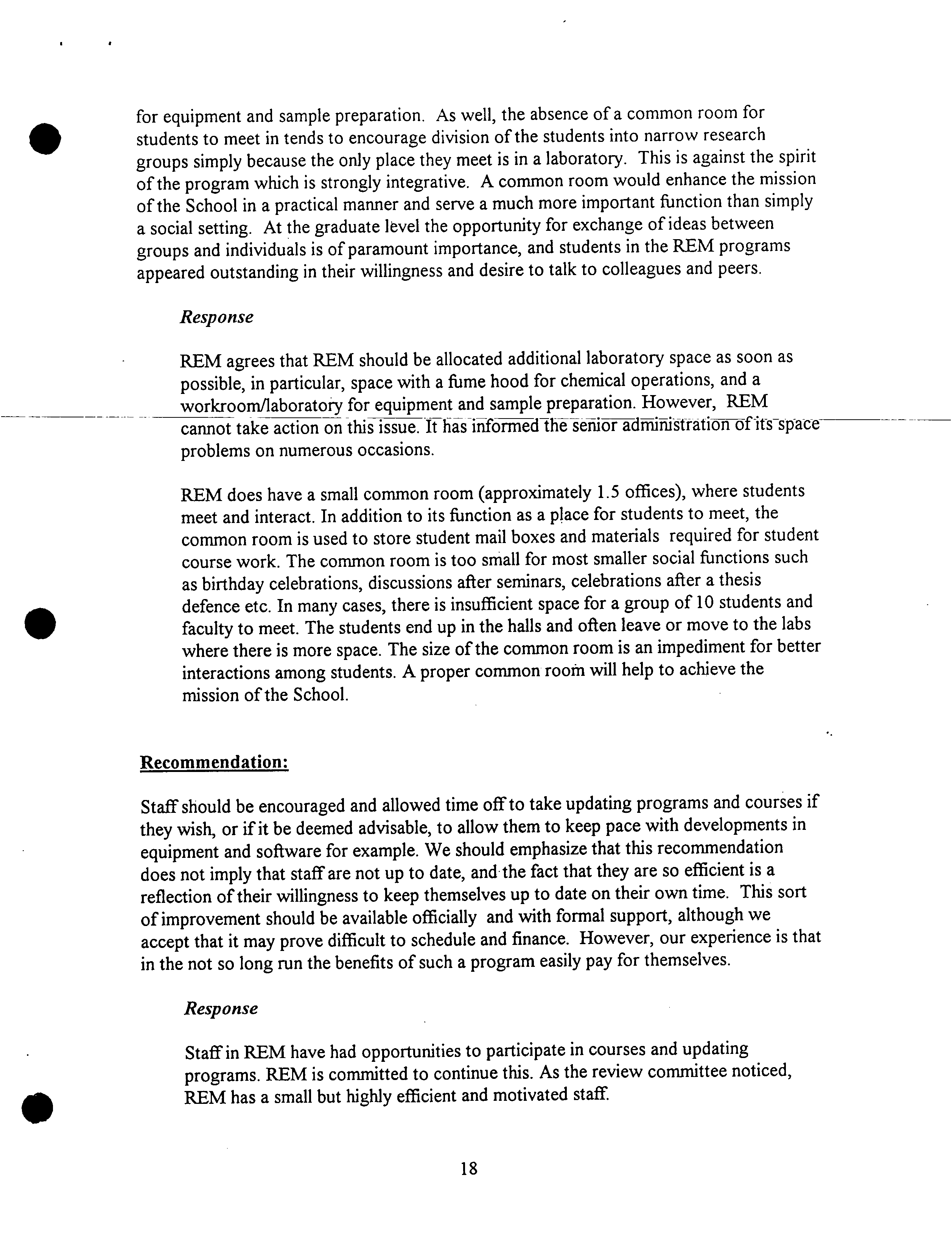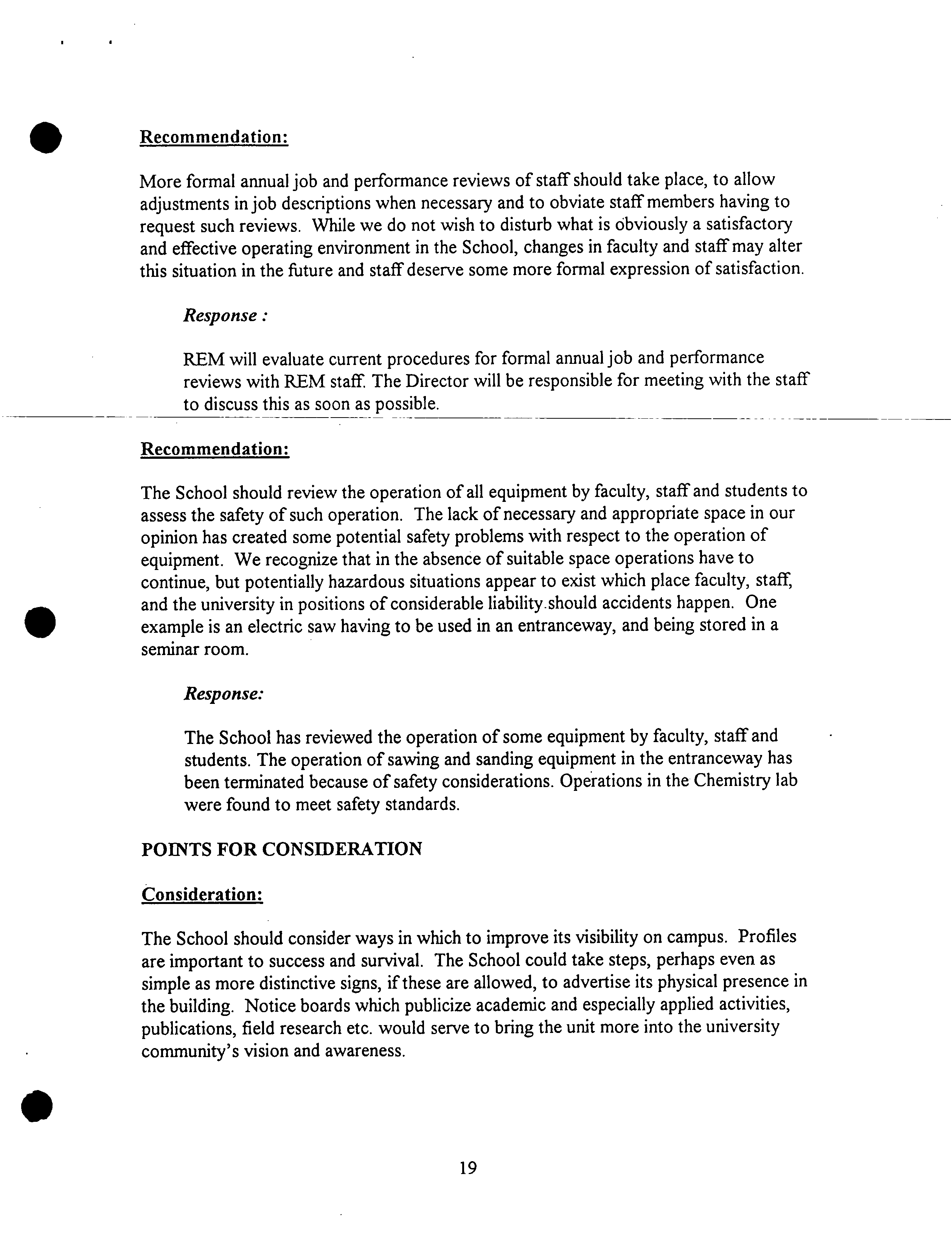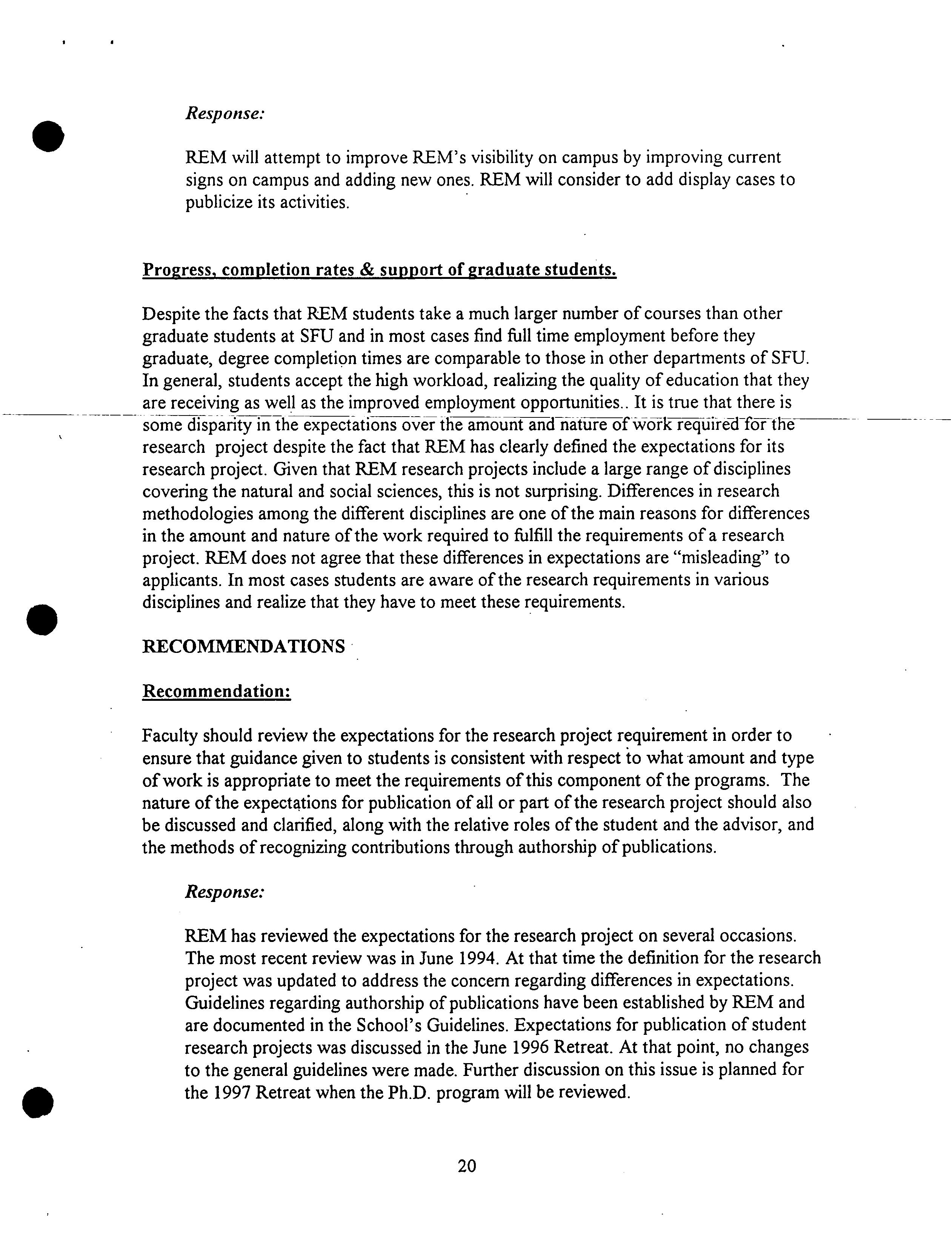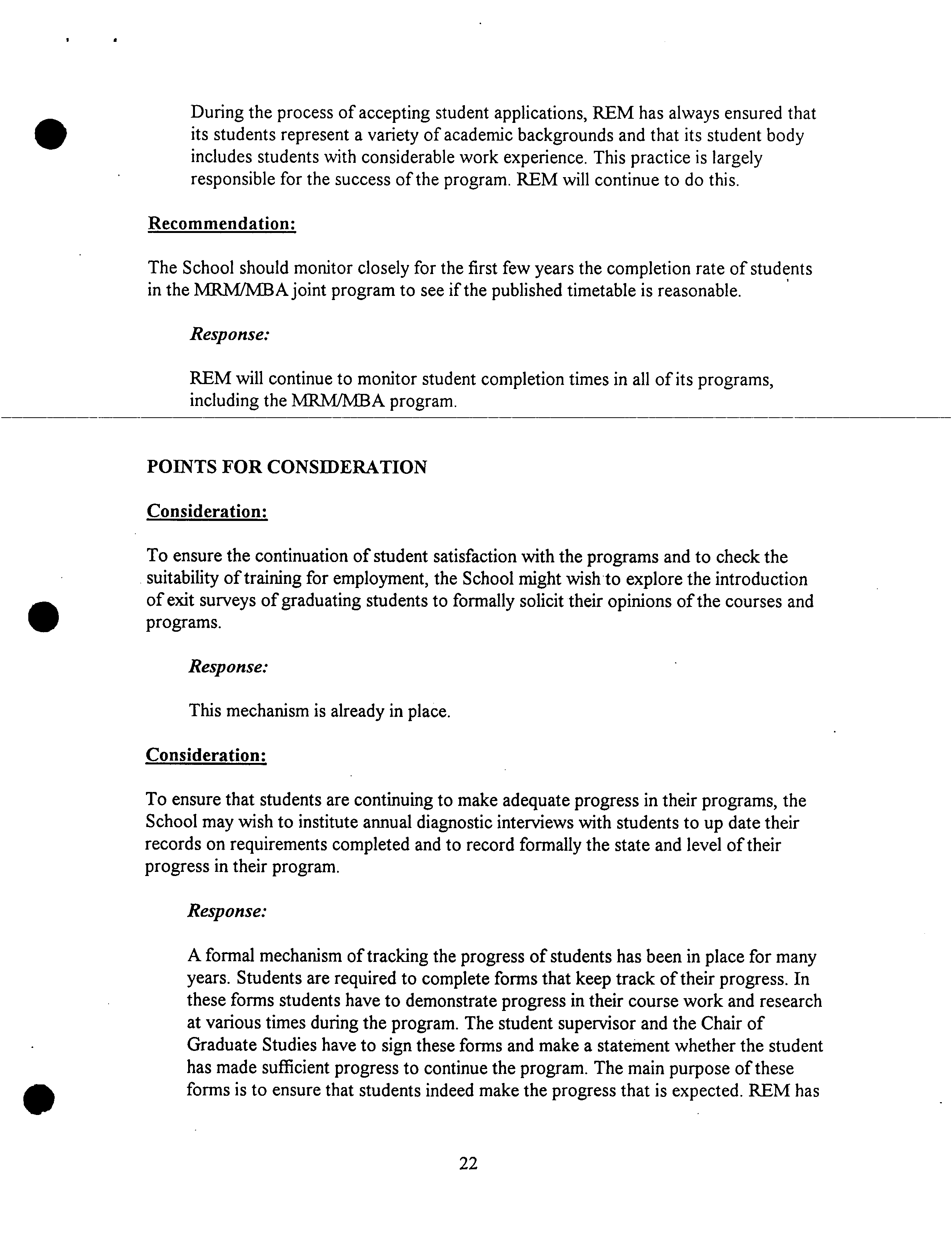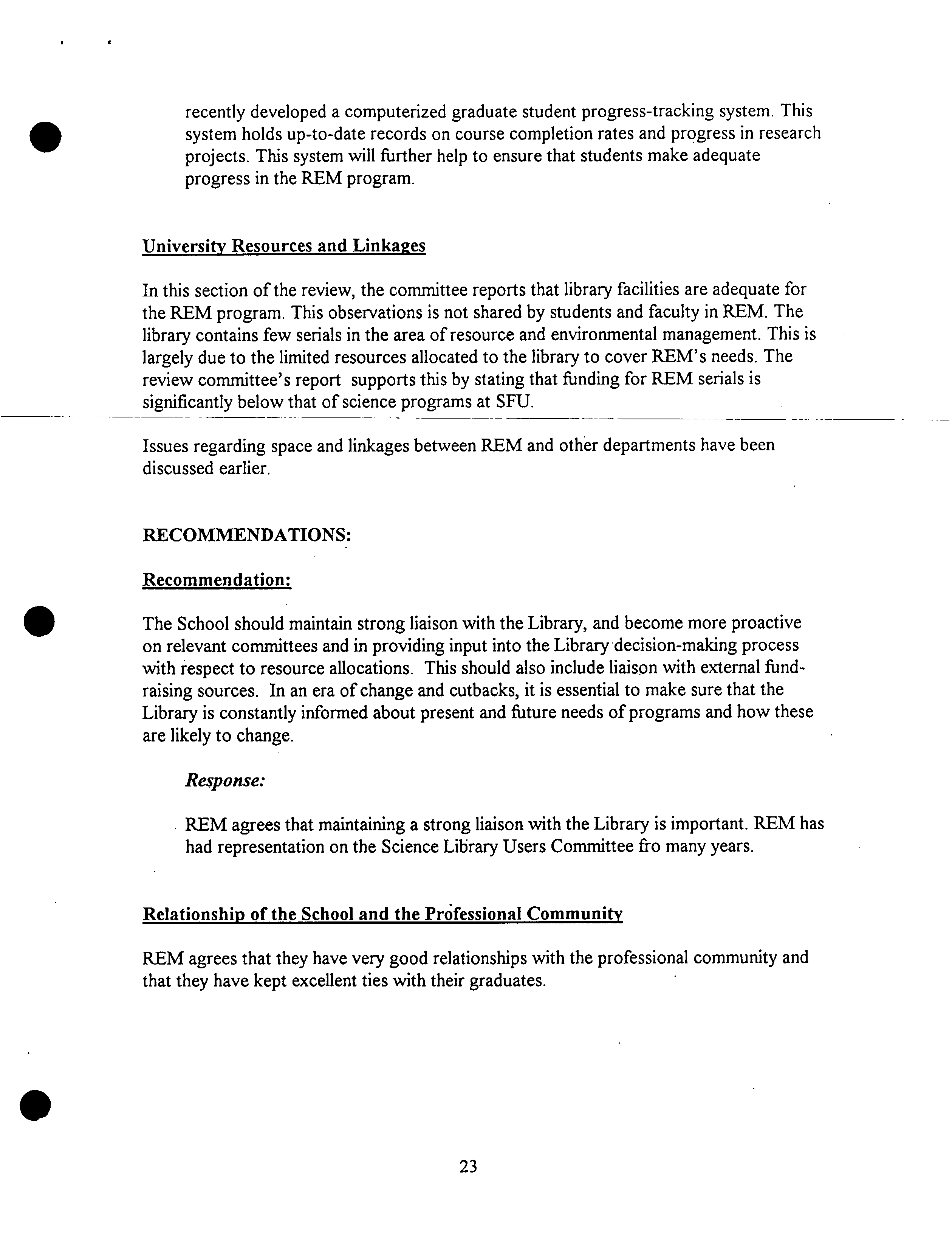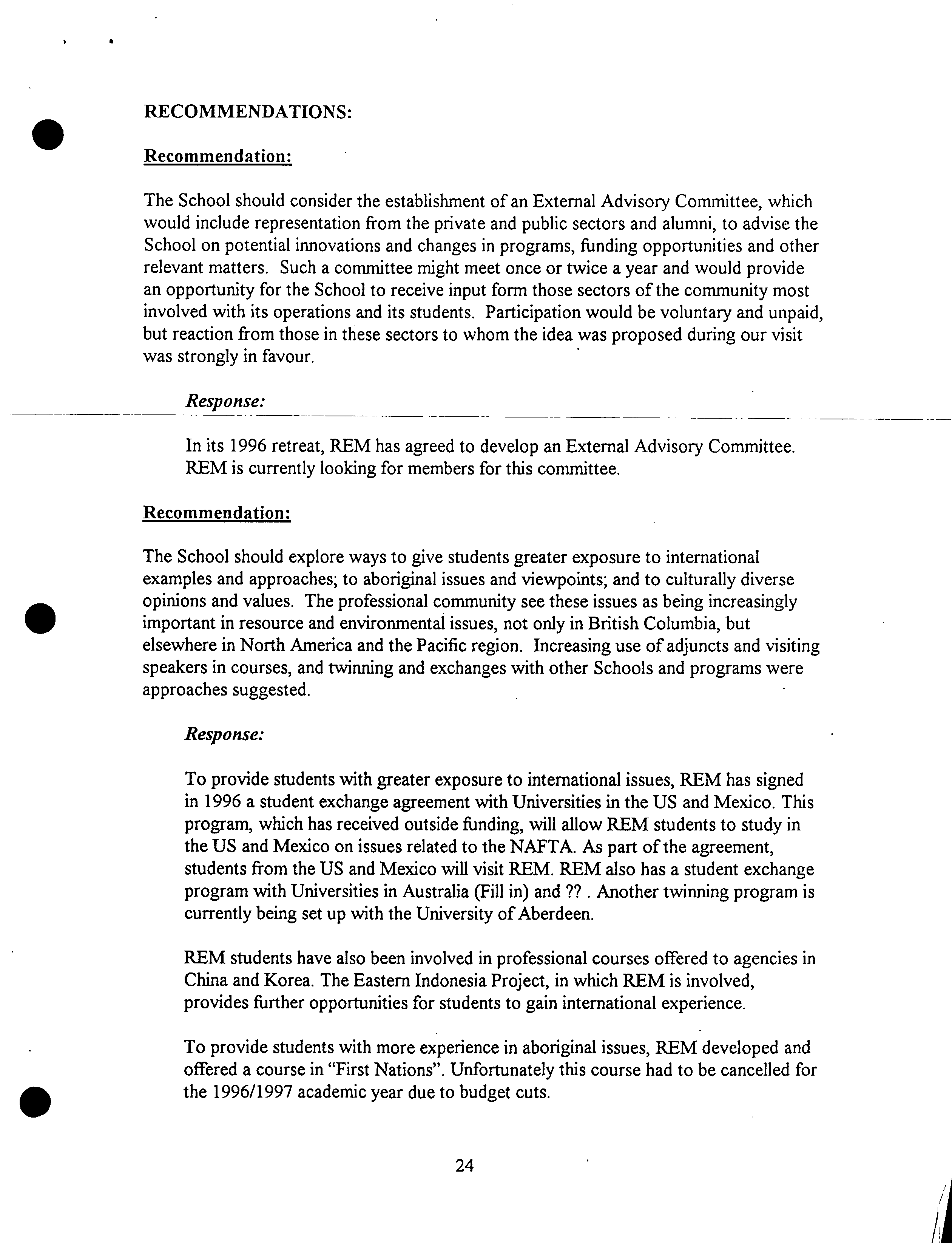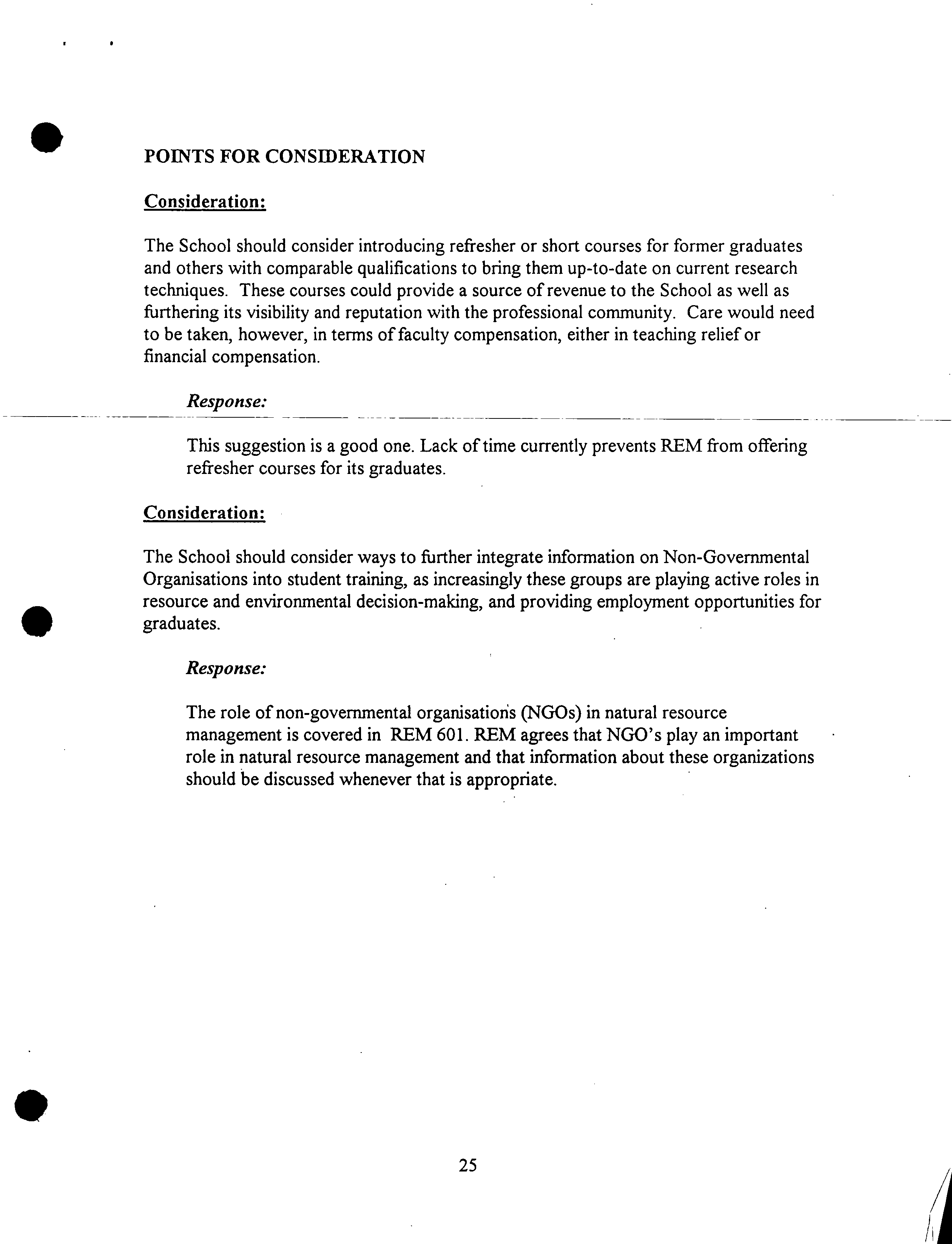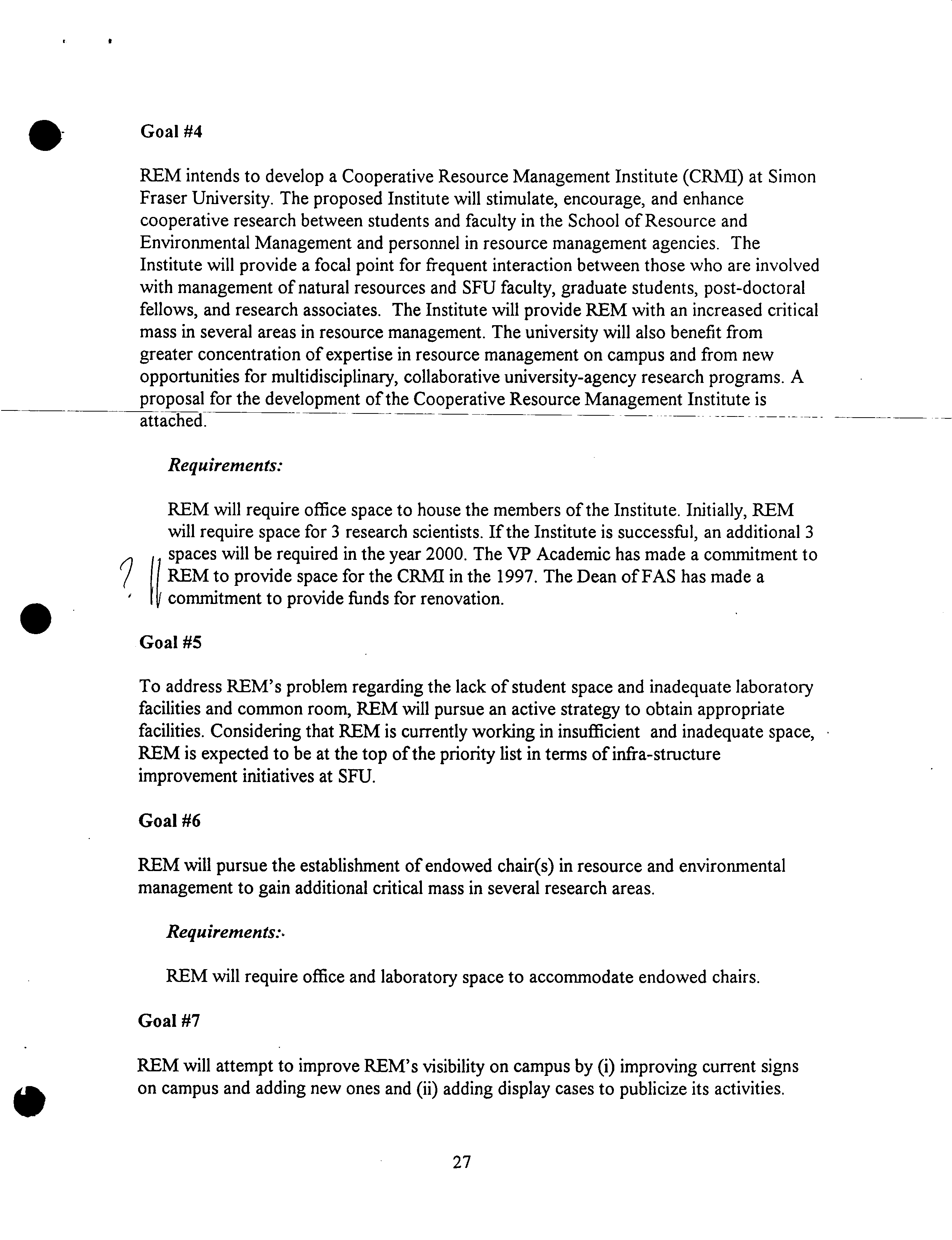S.97-49
.
?
SIMON FRASER UNIVERSITY
MEMORANDUM
To:
From:
Subject:
Date:
Senate
Alison Watt, Director, Secretariat Services
External Review -
School of Resource ad Environmental Management - -
May 21, 1997
For Information
Attached are:
•
?
D. Gagan's observations about the report of the External Reviewers
and the School's response.
the Executive Summary of the report of the School of Resource and
Environmental Management External Review Committee,
•
?
the Strategic Plan which outlines the priorities of the School, and
Both the full report of the External Review Committee and the 28 page response
prepared by the School of Resource and Environmental Management are
available in Secretariat Services for consultation by any Senator. Please contact
Bobbie Grant, Senate Assistant at 291-3168 or e-mail bgrant@sfu.ca
if you wish to
review these materials.
0
SCAP 97 - 26,
SIMON FRASER UNIVERSITY
Office of the Vice-President, Academic ?
Memorandum
To: Senate Committee on Academic ?
From:
David Gagan
L6'I
4ia.-_
Planning ?
Vice-President, Academic
Re: External Review and Response:
?
Date: ?
April 8, 1997
School of Resource and Environmental
Management
I have now reviewed the report of the external review committee for the School of Resource and
Environmental Management and the School's response. Here are my observations.
The External Review
(a)
Generally, the external assessment of the School was very favorable. In particular,
the reviewers cited the School's highly marketable MRM graduates, student
completion rates, student support, administration, co-operative master's program,
GIS initiative, and highly qualified faculty, as evidence of the School's well-deserved
national reputation.
(b)
The reviewers nevertheless identified three areas of immediate concern. In their
view, space, especially adequate, safe laboratory space, is the School's most serious
liability. This problem is closely followed, however, by budgetary shortfalls, and in
particular, equipment budgets.
(c)
The external assessors identified several areas in which the School should seek to
improve performance. They recommend the creation of an External Advisory
Council. They advise the faculty to become more involved with co-op work term
evaluations. They recommend that students be given more curriculum exposure to
international and aboriginal issues. And the reviewers encourage the School to seek
greater interaction with other SFU academic units.
(d)
Finally, the external assessors flagged two program issues which appear to warrant
special attention. First, the reviewers expressed concern about the doctoral program,
especially the marketability of the program's graduates, the ability of REM's faculty
complement to provide adequate supervisory breadth and depth, and the tenuous
support packages for doctoral students. They recommend a more specialized doctoral
program with limited areas of concentration.
Second, the reviewers addressed the "high degree of uncertainty" surrounding the
prospects for launching an undergraduate degree program in resource and
environmental management given the current fiscal climate and the inevitable
competition with other programs. The assessors argued that this "seems
counterproductive in almost every aspect", and expressed a preference for
?
40
"cooperation rather than competition." (p.6).
2-
2.
The School's Response
In addressing the assessors' comments, the School of Resource and Environmental
Management has accepted many of the reviewers' recommendations and suggestions and
has either taken affirmative action or, as the result of planning retreats, incorporated its
response into a formal set of strategic objectives. Most of these reactions require no
further elaboration here; but a few deserve to be highlighted. First, the School does not
agree that it lacks the "critical mass" to sustain a broadly-defined doctoral program.
Secondly, the School continues to believe that if /when resources become available it
should pursue its independent undergraduate program in environmental studies both as
an end in itself and as a way to enlarge its critical mass of human and fiscal resources for
• ?
other purposes. Third, the School insists that it must have a dedicated Co-op Program
Co-ordinator in view of the administrative demands of this large program. Finally, the
school argues that without additional, appropriate space, not only the School's
productivity, but its very identity, are in jeopardy.
3.
Comments
(a)
In view of the government's moratorium, for the foreseeable future, on new capital
projects in the post-secondary system, it is unlikely that the School of REM's space
requirements will be addressed through new construction anytime soon. Funding
may become available, however, for the rationalization of existing physical plant
usage through a variety of new initiatives. In that event, REM should be assigned a
high priority for refurbished or reassigned space adequate for its needs.
(b)
Given the likelihood that the fiscal climate in which Simon Fraser University must
operate over the next three to five years will continue to deteriorate (or at least not
improve), it is essential that the Faculty of Applied Sciences' planning processes
address the distribution of the faculty's resources relative to the responsibilities
assigned to its constituent schools, and to the outcomes that this investment sustains.
For their part, the external reviewers appear to believe that REM is best served by
concentrating its limited resources on its highly successful MRM program. I agree
with this conclusion. The prospects for implementing another undergraduate
environmental studies program that requires additional faculty positions and
operating budgets are virtually nil. Providing adequate support for the School's
doctoral students would seem to be a difficult problem. In these circumstances the
School, in my view at least, should co-operate as fully as possible in one or both of
the other undergraduate environmental studies programs, but otherwise focus on its
graduate training and research agendas, including limiting the scope of its doctoral
program, and enhancing its co-op program.
C. ?
Frank Gobas
. ?
Dean Marteniuk
John Stubbs
/pjs
scap/REMextresp/2206
SIMON FRASER UNIVERSITY
?
Office of the Registrar ?
MEMORANDUM
To: ?
SCAP members
From: ?
Alison Watt, Secretary, SCAP
Subject:
?
External Review - School of Resource & Environmental Management
Date: ?
April 30, 1997
Attached is the review of the School of Resource and Environmental Management,
and the School's response.
For your information, the members of the External Review Committee were:
Dr. Richard (Dick) Butler (Committee Chair)
Department of Geography, Tourism
and Outdoor Recreation
University of Western Ontario
Dr. Lynn Maguire (member)
Director, Professional Studies
School of the Environment,
Duke University,
Durham, NC
Dr. Bruce Mitchell (member)
Department of Geography
University of Waterloo
Dr. Rolf Mathewes (Internal member)
Department of Biological Sciences
SFU
.
0
OR]
Executive Sun'marv
A The current asers program in Resource and Environmental Management is
of high quality and has a song provincial and national reputation.
B ?
The graduates of the program are hi
g
hly marketable and their training and
abilities are ap
p
reciated by em!oyes.
C
?
The leaching and research con-ibuiions of the faculty are of hi
g
h standard,
with
many faculty members being knmwim nationally, and some having
-- ?
international reutations.
D The School working environment is conducive to the successful achievement
of the goals of the program.
?
B
?
The overall physical environment is acceptable, but the operations of the
1°
?
School suffer from lack of adequate and sufficient space, and in some
instances safety issues need attention.
F Resources and facilities for teaching and research pose some difficulties and
constraints on the operation of the School, particularly in the operating and
equipment budgetary areas.
?
G
?
Interaction and integration
with
other units is good in some specific areas but
could be expanded in others.
?
H
?
Student support, morale, and completion times appear to be acceptable given
?
the constraints existing on the Program.
I
?
?
The proposed Doctoral P
rogra
m
p
resents some potential concerns with respect
?
to depth of faculty s
t
rength and placing of graduates.
The proposed u e2rzdu2ie prcrarn will present some considerable problems
to the existing prcgrams and the overall operations of the School, particularly
with respect to competition
for
aiseady stretched faculty resources.
K
?
Administration of t}e School is eemely effective, and the support staff are
highly motivated,
is
omewhat eavily worked.
N
?
r
114
V. STRATEGIC PLAN
Programs:
Goal #1
REM's first and foremost priority is to maintain its graduate programs (i.e. the Masters in
Resource Management, Ph.D. in resource management, MRM/MBA programs) at the
current level of enrollment (at an average of 80 FTE) and to further improve the quality of
the graduate programs. ?
-
Requirements:
To achieve this goal, REM does not require an increase in funding or staffing.
However, REM does require an addition of student office space and adequate
laboratory facilities to create a working and research environment for students and
facilities that is comparable to those in other departments at SFU.
Goal #2
REM will be seeking an active role in environmental education at the undergraduate level
at SFU. REM is prepared to implement an undergraduate program in REM or to provide
• ?
courses in support of the Environmental Science and Environmental Studies Programs
subject to the availability of funding to cover all costs associated with the increase in its
responsibilities. Due to its experience at the graduate level, its excellent relationships with
the professional community and its success in placing students in full-time positions in the
resource and environmental area, REM believes that it is uniquely positioned in SFU to
contribute to undergraduate education in the environmental area.
Requirements:
Requirements for the establishment of an undergraduate program in Resource and
Environmental Management has been documented in the BREM proposal, that
received academic approval by Senate in April 1996 (check date).
Goal #3
REM intends to further expand its Co-op program and improve the quality of the Co-op
experience by providing formal evaluations of student work terms.
Requirements:
Considering that REM has the largest graduate Co-op program at SRi, REM will
require part-time funding for a Co-op coordinator to meet its goal of offering an
expanded and higher quality Co-op program.
X q.
Goal #4
REM intends to develop a Cooperative Resource Management Institute (CBI'vfl) at Simon
Fraser University. The proposed Institute will stimulate, encourage, and enhance
cooperative research between students and faculty in the School of Resource and
Environmental Management and personnel in resource management agencies. The
Institute will provide a focal point for frequent interaction between those who are involved
with management of natural resources and SFU faculty, graduate students, post-doctoral
fellows, and research associates. The Institute will provide REM with an increased critical
mass in several areas in resource management. The university will also benefit from
greater concentration of expertise in resource management on campus and from new
opportunities for multidisciplinary, collaborative university-agency research programs. A
proposal for the development of the Cooperative Resource Management Institute is
attached.
Requirements:
REM will require office space to house the members of the Institute. Initially, REM
will require space for 3 research scientists. If the Institute is successful, an additional 3
spaces will be required in the year 2000. The VP Academic has made a commitment to
REM to provide space for the CRMI in the 1997. The Dean of FAS has made a
commitment to provide finds for renovation.
Goal #5
To address REM's problem regarding the lack of student space and inadequate laboratory
facilities and common room, REM will pursue an active strategy to obtain appropriate
facilities. Considering that REM is currently working in insufficient and inadequate space,
REM is expected to be at the top of the priority list in terms of infra-structure
improvement initiatives at SFU.
Goal #6
REM will pursue the establishment of endowed chair(s) in resource and environmental
management to gain additional critical mass in several research areas.
Requirements:
REM will require office and laboratory space to accommodate endowed chairs.
Goal
#7
REM will attempt to improve REM's visibility on campus by (i) improving current signs
on campus and adding new ones and (ii) adding display cases to publicize its activities.
.
Goal #8
REM will review the operation of the Ph.D. program. One of the goals of this review will
to evaluate the process of student admission and supervision. At this time, the issue of
intellectual property rights and expectations regarding authorship of publications will be
further discussed with the ultimate aim of updating the guidelines of REM on this issue.
Goal #9
To further improve gender and minority distribution in its faculty, REM will review the
gender status of its adjunct faculty and will aggressively seek to attract high quality
academics and professionals from women and minority groups for adjunct professor
positions in REM.
Goal #10
To ensure a highly effective and motivated staff in the future, REM will continue to
provide opportunities for training to its staff. REM will further evaluate current
procedures for formal annual job and performance reviews.
.
?
N
L
Environmental Management ?
School of Resource and
SIMON FRASER UNIVERSITY
(FAX: (604) 291-4968 Web Page: http:www.rem.sfu.ca)
Date:
March 13, 1997
To: David Gagan , Vice-President
Academic
From: Frank Gobas, Director ?
Phone: ?
291-3074
Subject:
External Review School otRes.ourceand Environmental-Management
The School of Resource and Environmental Management is now able to respond to the
Report of the External Review Committee. For your convenience I have attached both a
copy of the committee report as well as the school's response to the the committee report.
I trust you find the response in order.
Alish Watt, Director, Secretariat Services
Ron Martenuik, Dean, Applied Science
Ir
?
r
rg
REPORT OF THE SCHOOL OF RESOURCE AND
ENVIRONMENTAL MANAGEMENT REVIEW COMMTITEE
1995
Committee:
?
R. Butler (chair)
L. Maguire
R. Mathewes
B. Mitchell
is
T
TABLE OF CONTENTS
.
?
hrn
Preamble....................................................
Executive Summary
?
.............................................
ii
Introduction ?
..................................................
1
Current Graduate Programs ........................................2
..
2
Ph.D..................................................
Proposed Undergraduate
Program
.
.................................... 5
Recommendations .........................................8
Points for Consideration
?
....................................9
REMFaculty .................................................9
Recommendations........................................12
Points For Consideration ....................................13
School Environment, Facilities and Administration ......................14
Recommendations ........................................16
Points for Consideration ...................................17
Progress, Completion Rates and Support of Graduate Students ..............17
Recommendations........................................19
Points for Consideration .....................................20
University Resources and Linkages .................................21
Recommendations ........................................22
Points for Consideration ...................................22
Relationship of the School and the Professional Community ................23
Recommendations ........................................24
Points for Consideration ...................................24
0
?
Review Procedure .............................................25
r
APPENDICES
. ?
Appendix I
Interviews and Meetings ..............................27
Appendix 2
Terms of Reference ?
.................................28
Appendix 3
Recommendations and Appropriate Responsibility .............
30
.
PREAMBLE
The Review Committee (hereinafter referred to as "the committee" or "we") visited
Simon Fraser University over three days (September 25-27th,
1995),
and during that time
met with faculty, staff, sndents, and alumni of the School of Resource and Environmental
Management, and a number of other faculty and senior administrative staff of the
University (Appendix 1 provides a list of individuals and groups with whom we met). We
would like express our thanks for the very considerable assistance and cooperation which
we received from all parties durin
g
' this period. All of our requests for additional
information were promptly and courteously met in full. The discussions which we had
were frank and open, but ahvays conducted in a very collegial atmosphere, and it was
- - -- -
?
able_not_lo_be_exosed—to-perso al
or
—
?
This
atmosphere reflects well on both the School and the general University situation.
The structure of the report follows closely the outline of the Terms of Reference
of the Review Committee. We have endeavored to address each of the eleven items in
those Terms of Reference, and to reflect also the more general concerns noted in the
Senate Guidelines for External Reviews of Academic Units. which are also listed in
Appendik 2. We have chosen to make general comments on each item, followed by
specific recommendations in most cases, and other items for consideration but not
necessarily action. We have tried to place our comments and recommendations in the
context of the resources currently and likely available to the School and the University
in the near future. Overriding this report and much of the planning and future actions of
the School and the University is the uncertainty in the province over likely budgets and
their effects on the university.
0
I
?
I
Executive
Summary
A ?
The current Masters program in Resource and Environmental Management is
of high quality and has a strong provincial and national reputation.
B ?
The graduates of the program are highly marketable and their training and
abilities are appreciated by employets.
C ?
The teaching and research contributions of the faculty are of high standard,
with many faculty members being known nationally, and some having
in
?
UlregL^
D ?
The School working environment is conducive to the successful achievement
of the goals of the program.
E The overall physical environment is acceptable, but the operations of the
School suffer from lack of adequate and sufficient space, and in some
instances safety issues need attention.
F Resources and facilities for teaching and research pose some difficulties and
constraints on the operation of the School, particularly in the operating and
equipment budgetary areas.
G ?
Interaction and integration with other units is good in some specific areas but
could be expanded in others.
H
?
Student support, morale, and completion times appear to be acceptable given
the constraints existing on the Program.
I ?
The proposed Doctoral program presents some potential concerns with respect
to depth of faculty strength and placing of graduates.
J ?
The proposed undergraduie program will present some considerable problems
. ?
to the existing programs and the overall operations of the School, particularly
with respect to competition for already stretched faculty resources.
K
?
Administration of the School is extremely effective, and the support staff are
highly motivated, if somewhat heavily worked.
0
0. ?
ThTRODUCTION
The Review Committee talked with all full-time faculty members of the School
present on campus (together and individually), two faculty members (Gunton and Jacard)
not on campus (through telephone conversations), all full-time members of staff of the
School, currently registered students in the MRM, MRMJMBA, and Ph.D. programs,
alumni of the programs, adjunct professors, employers of graduates of the programs (in
person and through telephone interviews), chairs of Biological Sciences, Economics and
- -Geograph-y--Deans-of-A-ppl
.
ied--Sc'ience,-Science,-and-Graduate--St-ij-djes;- andreeitatj
of the Library and the senior administration of the University. We also had access to a
large amount
,
of information on programs, faculty activities, or
g anization and
administration of the School, University operations, and students.
In general, the responses and com.ments which we were given displayed a great
deal of consistency and agreement, and there were very few dissenting opinions to the
•I
majority consensus on most points. It is clear that there is a generally high opinion of the
NMI program throughout the University and the professional community with -whom we
had contact. Within the School there is justifiable pride in the graduate programs and the
activities of faculty, staff and students. There are, however, in both the School and the
University at large,
concerns
and lack of agreement about the high degree of uncertainty
which the future holds, particularly with respect to financial matters and new programs.
It appears impossible to separate these two items, since the proposed undergraduate
program and subsequent changes which will take place in the graduate programs of the
School are clearly driven primarily by the anticipated financial readjustments which are
likely to have to be made. We are not entirely convinced that there has been as full a
discussion and evaluation of the implications of some of these changes as may be
necessary, particularly as some of the changes are likely to be irreversible.
0
2
I
Current Graduate Pr02rams
Master's Programs
We believe the existing Master's programs (MRM and MRM/MBA) to be of high
quality. Our assessment is based on a number of considerations.
1) The quality of students entering the program is very high, based on grade point
averages, the national and provincial competitive scholarships which current and past
students hold/held, the rigorous screening process of applicants, the number of applicants
per place in the program,andjheployability_oflcomplejjofl_or_near_compiejj0fl0f__
their programs. The program is successful in attracting applicants from outside British
Columbia, and a small number from outside Canada, despite limited financial support for
their period of study. As well, the overwhelming tenor of the comments we heard about
the students was positive and supportive.
::
.
2). The quality of the faculty is high, and nearly all display a high level of
commitment to and enthusiasm for the program. There is a good mix of traditional and
applied-,
-academic skills among the faculty and a considerable range of disciplinary
background and skills, although some professions are not currently represented, most
noticeably law and engineering. The faculty are well qualified to teach the courses
offered, and their involvement in research, both academic and applied, complements the
teaching well.
3)
The program itself, in terms of courses offered, courses required, the nature
of course content, and student evaluation procedures is of a high level of academic rigor.
Students have to work hard but appear willing to accept this, and morale and esprit de
corps are high.
4)
The Coop element of the program is highly successful in terms of exposing
students to the opportunity to work in real-world situation on current problems.
Considerable work has been put into this element and it was strongly endorsed by both
students and alumni. It undoubtedly helps students improve their employability. Its
4s
evaluation procedures would benefit from more formal faculty involvement.
-
? f
We strongly support the anem
p
ts to incorporate training in Geographic Information
Systems into the
programs.
In this day and age it is difficult to envisa
g e any pro g
ram in
resources and environmental management which does not include what has become a
crucial tool of analysis in research and planning. We recognize the potential duplication
of facilities with other departments,- particularly Geography, but are convinced that
demand for access to such facilities will more than justify the provision of facilities in
each unit. Our experience in other 'institutions leads us to believe that many other
departments and units will ultimately want and need access to such facilities in the future.
The marketability of the graduating students is commendably high, although this
-presents-one-m•inor-problem -which--relates-to-students--often-t dng-jobs-before-f]na1
completion of their program, particularly their research project, and then taking a
considerable time to comolete this component once they are in the work force. There is
no easy solution to this, beyond maintaining close contact with the student and
encouraging employers to pressure them to complete any outstanding requirements.
Related to this is the fact that many students do not publish material from their research
project once they have left the school, a point of concern to some faculty in as much as
publications are necessary for securing additional research funding. The need to review
the expectations for the research project and associated publications is discussed in a later
section.
In short, we consider the MRM (MRMIMBA) to be of very high quality, with a
unique structure and approach. The visibility of the program in British Columbia is
extremely high, and most of the graduates enter employment in the province.
We
feel
that one might expect greater numbers of international applications if the program is to
claim international status,particularly in view of the welcome absence of a foreign student
fee differential.
Ph.D. Program
We have chosen to comment on the Ph.D. program in this section since there are
already students in this pro
g
ram. The comments made about the Master's programs with
I ?
I
4
• respect to faculty involvement and courses apply equally to the doctoral program. We
recognize the legitimate desire of the School to add,a Ph.D. program to a very successful
Master's program, and the fact that Ph.D. students would increase the critical mass of
researchers in particular fields and complement faculty research and publications.
There are issues about the Ph.D. program, however, which do not apply to the
Master's programs. One is the marketability of the Ph.D. students. While graduates of the
N4M and MRM/MBA are clearly 'very marketable in terms of their employment
potential, we wonder if the doctoral graduates will find the same success in employment.
Employers interviewed were not as receptive to the idea of employing Ph.D. graduates
- - - ----as--they—we-r-e- to—master-
7
s graduates. -This--may--be- -because--they—axe—familiar—with -the
Master's product, but some thought a doctorate would be an over qualification for the
current type of employment most common in British Columbia. It is also at least
questionable if gradu.ates of the Ph.D. program in REM would be competitive for
academic positions in conventional departments. The MRM is certainly a good and
accepted
:
program
,
of training for admission to conventional Ph.D. programs, but the
higher degree may be less acceptable in the majority of situations.
In addition, ,
the issue of adequate critical mass of faculty in specific areas to
supervise Ph.D; students has to be raised. The School of REM has faculty from a variety
of backgrounds (compared to a variety of sub disciplines). The School has only one or
two faculty in a number of areas, and normally more than this number is considered
necessary for a Ph.D. program. While we do consider that the School is capable of
instructing and graduating good Ph.D. students, it should consider carefully in which areas
it really has suitable faculty advisor numbers and expertise.
Finally, the fact that funding can normally only be guaranteed for two semesters
could create problems in attracting Ph.D. students, who will be resident in the program
for considerably longer than Master's students and would normally expect a longer period
of guaranteed funding.
. ?
Conclusion
While our overall assessment of these programs is very positive, there are a
number of recommendations and comments for consideration which we feel are
appropriate to make. In so doing, we are often reflecting comments and suggestions made
during our discussions, and do not mean to imply that some of these points have not
already been discussed and considered \;thin REM. The recommendations and
consideration points are made at the end of the appropriate sections of the reports, and the
recommendations are summarised in Appendix 3, along with suggestions as to who should
be responsible for implementation, should they be accepted.
Protosed Under2raduate ProErarn
There is little doubt that the School could offer a successful and valid
• undergraduate program, and the proposal which we reviewed gives us no cause for
concern over the academic suitability of the program. However, it was an initial source
of puzzlement to the review committee as to why a School with very successful graduate
and research programs should wish to establish an undergraduate program. Discussions
revealed that there is certainly concern among many, if not all, of the faculty over the
likely impacts of such a program on the established programs and on the effectiveness of
the School as a whole.
It is our understanding that the proposed undergraduate program has been
promoted primarily because it is seen as the only way to achieve two goals. One basic
goal which faculty and others expressed for the School was the need to secure additional
teaching assistant funding for graduate students, and another goal was to secure additional
faculty members. We agree that both of these matters are legitimate concerns and should
be addressed. Undergraduate students would require and be allocated teaching
assistantships, which would then provide a source of funding for current and perhaps
additional graduate students. An underraduate program would also legitimize valid claims
40 ?
for additional faculty members to leach in that program. We accept both of these
• premises, although we would add the cautionary note that in such times as these with
threatened budgets, there is no guarantee that adequate numbers of either leaching
assistantships or new faculty members would be forthcoming, even if the undergraduate
students arrived. We are not entirely convinced that all alternative avenues of securing
additional funds and faculty have been fully explored. We suggest below a number of
possibilities which could be explored, although we do so knowing that some of these have
already been considered and in somecases shelved because of lack of resources and/or
time.
We reviewed the proposed undergraduate program, and discussed this, and the
-- -__related_programs4nSc-ie-nceand-Geogr-aphy-wit-h--r-epresentatives-from-these-units;---T-he---
original concept for the Environmental Science undergraduate program of a common set
of introductory courses and three streams in REM, Geography and Science still seems a
sound one. The fact that agreement or consensus could not be reached, has resulted in the
three elements going separate ways and introducing three different programs with few
common courses, which seems counterproductive in almost every aspect. This seems an
issue which may need intervention by senior administrators to ensure that there is
cooperation rather than competition ber.veen these programs once they are operating.
As noted above, the School, assuming it gains the additional faculty and teaching
assistants it would need, is capable of offering an undergraduate program in
Environmental Studies from its own perspective, and we would assume that such a
program would attract acceptable numbers of applicants, in part because of the reputation
of the MRM. The employability of graduates of such a program is likely to be high,
although many employers with whom we spoke made it clear that they would not view
such graduates as managers, as they do the graduates of the MRM programs. The
implications for the graduate programs and the School's overall operations could be
severe, however, and we are not convinced that these have been resolved to everyone's
satisfaction. One of the strengths of the MRM and MR2\014BA is the great accessibility
of faculty to students, and this would inevitably change once faculty were involved with
undergraduate courses. A decline in faculty productivity in terms of research publications
0
?
and involvement with the outside community could also be expected to take place. This
7
• is not just because faculty \ll be teaching undergraduate classes, but more because of the
necessity of meeting \iLh additional students, as well as preparing new courses, arranging
additional coop placements and all the other administrative work which goes with an
undergraduate program.
We would note also that the principle that new faculty would teach more in the
undergraduate program (2 courses) than the graduate programs (1 course), while existing
faculty would teach more in
the
graduate program (2 courses) than undergraduate (1
course), is unlikely to be very acceptable to new faculty once they are established in the
School. This proposed allocation of work load is almost guaranteed to create dissension
- ------and -schi sms-amon g-exi s-i
i n g -and-new-f? cul ty-
.There-al so seems-lirtlejustification
an allocation based on equity or efficiency considerations. We believe such a proposal is
unwise and not defensible.
The undergraduate program would also place considerable strain on staff and the
Director, with respect to a great deal more administrative work, including much greater
coordination and cooperation with other departments and units than is necessary at
•' present.
With
current work loads it is difficult. to envisage
.,
a reasonably sized
undergraduate program being handled by the existing staff, unless some other elements
of their duties were transferred elsewhere, for example, to faculty, which again would
impact negatively on the graduate programs. Finally, as noted elsewhere, additional space
is a critical factor, since an undergraduate program and additional faculty and teaching
assistants could not be housed in the existing space of the school. There is also no space
for any undergraduate laboratory teaching currently available in the School.
We are not saying that an undergraduate program should not be offered, but we
are not convinced that all of the implications have, been fully discussed and satisfactory
arrangements made. It generally proves easier, and is much more common, for units to
go from an undergraduate program to graduate ones. We appreciate why this is not the
situation in this case, and also that there is pressure in various forms on the School to
establish an undergraduate program. "They must have an undergraduate program to carry
their share of the freight" was one expression heard in our discussions. An undergraduate
0 ?
program might also provide opportunities for developing additional or stronger links with
8
• other units. Having an undergraduaterogram would give the School greater weight in
discussions over access to resources of various kinds, and, being blunt, would remove the
feeling in some quarters of SFU that the faculty in the school are privileged because they
do not have to be involved in under?aduate teaching. If the lack of undergraduate
teaching is a privilege, and not all \voud agree with that sentiment, the privilege does not
extend to having lighter work loads as far as the School faculty and
staff
are concerned.
Recommendations
- - -l-)—Discussions-shou]d --begin-again-or--recomnence-on-the-originaFconcept-of-the-
Environmental Science program, with the idea of a set of common introductory
courses being pursued. Senior SFU officers need to take a lead role to avoid the
creation of three programs that could easily end up competing for the same pool of
students.
2)
The School should undertake further detailed discussion internally on the specific
implications of the proposed undergraduate program and put into place policies and
procedures to minimize the impacts on the established programs and operating
arrangements.
3)
The idea of an endowed chair in resources management should be further pursued as
an avenue of increasing faculty strength without additional teaching commitments.
This could be done with or without the proposed undergraduate program.
4)
Discussions should begin or continue with the library over the needs of the proposed
undergraduate program, as these may be quite considerable and specific.
0
?
0 ?
Points for Consideraiic'n
) The School might consider the possibility of increasing fees for the MR-M.
MR.MJMBA and Ph.D. programs and utilizing the funds so gained to employ sessional
lecturers to teach in the undergraduate program, if such arrangements are possible.
2) The School should consider the possibility of utilizing senior Ph.D. students to teach
in the undergraduate program to provide them with the opportunity to teach courses
and increase the teaching ca
p
acity of the School. If this were to be done, a mentoring
?
-- - -
?
aeet -shoul-dbestablished -throuh- which_-P-h-D;_c-andidate-s_\
V
ith_s
e
ssioflal
- -- - -
teaching responsibilities would work closely with regular faculty members to discuss
pedagogy and other teaching skills.
REM Faculty
The review commitlee was most favorably impressed by the commitment and
efforts of the REM faculty. Most are actively involved in research and in administration,
and there is generally a strong esprit de corps amongst members. Given the diverse nature
of the backgrounds of the faculty members, there is a good positive working relationship
between those we were able to meet. It is fairly clear that the faculty work hard, with
supervisory responsibilities, as well as teaching and research expectations. We recognize
that, on the other hand, they do not have the general obligations of teaching undergraduate
courses for the most part, but we regard their overall work loads as being comparable to
those of faculty in other units. At the same time, we do not believe that their work loads
are heavier than normal, as some of the REM faculty seem to believe. The review of CVs
indicates that the level of success in securing research funding has been high, and the
sources of such funding are varied and reflect a good mix of conventional peer reviewed
funding and applied research funding that is project driven.
The small number of permanent full-time faculty members in any particular
research area presents something of a problem with respect to the Ph.D. program, as noted
IIi]
below, and to a ]esser degree to ih Master's pro2rams. We are conizant of the
discussion of upcomin g
replacement and new appointments, and some differin
g
opinions
about the nature of such appointments, and whether they should be "physical' or "social'
scientists. It is our opinion that it would be more appropriate and serve the needs of the
School better to consider the abilities and research talents and approaches of potential new
appointments, and the expeise and sdil which they could bring to the pro
g
rams, rather
than make such appointments on the.casis of disciplinary backgrounds.
There are some well established and productive links between REM faculty and
colleagues in other departments and faculties, most noticeably in the physical sciences,
ndbxough
that all possible links have been established that could have been, although we
acknowledge that it is easier to make such a comment than to illustrate how the links
could be developed. In the final analysis, such links depend very much on the
personalities involved, as \Vell as upon timing, budgetary arrangements and administrative
attitudes. However, sharing of facilities and sharing of courses can produce benefits to all
parties involved, and the nature of REM programs means inevitably that some overlap of
material occurs in a number of areas. In the present economic climate every unit and
program needs to develop all of the friends and collaborative links that it can, and REM
is no exception.
We consider the range of publication outlets which have been used to disseminate
the research of faculty and students to be very good, and think it highly appropriate in
a School such as this that there is a wide variety of publication formats. In the School
there is a great range of different types of research, and a mix of "pure" and "applied"
research is not only inevitable but also required. This breadth matches the mission
statement of the School and its role in providing a "professional" as well as an "academic"
program. (However, we still are unclear what SFU or REM mean by "professional" when
referring to programs). We assume, and would urge that appropriate recognition of such
activities be given at times of consideration for promotion and tenure of faculty, since it
is now becoming normal practice at many institutions to give a wider interpretation to
what is accepted as "scholarly activity". The offering of Professional Workshops, for
example, is one way cf disseminating research and scholarship which is highly
complementary to a professional program. The creativity and scholarship involved in such
an activity can be considerable and allow for good student involvement and participation
with clear benefits.
The addition of the Centre for Tourism Policy and Research has
g
iven REM an
added direction for research and teaching, and one that should yield good dividends in
terms of research funding potential, employment and coop placement for students. The
Korean project is one example of this. There is a need to clarify the precise role of the
Centre within the School, and the relative importance which it should play in terms of
---_—svudent--r-esearch inlerest
We view the practice of allowing some faculty to take extended leaves away from
the School as not serving the best interests of the School. While faculty in such a program
as REM are often going to be in great demand by the public and private sectors, we, and
many we spoke with, consider extended leaves to be damaging to the operations of the
School. It is misleading to students who enter the program expecting to work with such
faculty, only to find them on leave throughout their program. The practice inevitably
weakens the overall effectiveness of the program, however competent the short-term
replacements. It also places increased work on the remaining regular full-time faculty with
respect to administrative and other duties which cannot be undertaken by short-term or
part-lime replacements.
\Vhile all faculty are involved in programs and administration, it is perhaps
inevitable that all loads are not equal. This in itself need not be significant, as different
people perform at different levels and in different ways. However, it is common practice
in many units to allow junior faculty some relief early in their careers in order for them
to develop their research programs and to prepared for promotion and tenure applications.
This is difficult in a small unit, and does not appear to have been formally attempted in
REM to date, with the result that some junior faculty appear to have excessive loads in
administrative and advisory areas. It is not uncommon to find junior faculty with high
energy and commitment levels who take on too much for the good of their own career
1^1
12
development, but the Di:ector and the Faculty Dean share responsibility to not take
0
?
advantage of such enthusiasm.
Recommendations
1)
The current practice of allowing faculty to have extended leaves of absence should be
terminated. This issue was a generally acknowledged problem during our discussions.
It can do a program more harm than good to have faculty away from campus and thus
normally not involved in leachin
g
and supervision for long (more than 2 years)
periods of lime.
2)
Junior, and especially untenured, faculty should receive some formal relief from
teaching, supervisory and particularly administrative loads early in their careers to
allow them to establish research programs and to prepare for promotion and tenure.
- In addition, they should receive more guidance and mentoring from senior faculty on
what are appropriate levels of conimiunent and be dissuaded
from
volunteering for too
• much activity.
3)
Faculty should discuss in some detail the precise areas in which Ph.D. students should
be accepted, and these areas should be those in which there are adequate numbers of
faculty for advisory and examination functions. The appointment of new faculty
members should take this issue into account, and when new appointments are
considered for the School, emphasis should be given to the specific expertise which
individuals could bring to the School rather than whether they are "physical" or
"social" scientists, since it is often methodologies and techniques which encourage
team work rather than disciplinary backgrounds.
4)
Faculty members should continue to explore additional linkages with colleagues in
other units, in terms of research, in teaching shared or combined courses, and in the
use of facilities. Developing a greater number of effective research links with other
departments could also aid the new Ph.D. program in REM. The new GIS facility is
likely to be an anraction to facui and students from other units and ma
y
provide a
new
opportunity for such linkages to develop.
Points for Consideration
1)
We
would encourage the facu]ty.to actively pursue attracting Post-doctoral Fellows
to REM. Such individuals can add credibility to programs, as well as providing new
blood in research projects and in some cases, could contribute to the teaching in the
2)
On the basis of our discussions we do not consider the disciplinar
y
balance in REM
to be a serious issue. We recognize that the gender distribution is lopsided, and that
representation of minority groups is poor. However, we are well aware that there is
a severe under supply of Canadian women and minority groups in particular available
for employment in the area of resources management. The student mix with respect
to gender is acceptable, which does leave the issue of role models not fully addressed.
We consider this an issue which needs open discussion within the School, but we
recognize that there is no easy or obvious way to overcome the faculty imbalance.
Deliberate selection of specific adjunct faculty may assist in this issue.
3)
We suggest that the School ensure that the terms under which workshops, short course
and similar activities are undertaken (e.g., for academic reasons, for personal financial
gain, for development of the School) be made clear to participants and evaluators of
files for promotion and tenure, since the trade-offs in terms of time and effort spent
on other forms of scholarly activity are considerable and need to be recognized
appropriately.
14
School Environment. Facilities and Administration
.
We were favorably im
p
ressed with the working environment of the School (we
have taken this topic to include items 5, 9, and part of 10 of the terms of reference
contained in Appendix 2, since these
F-*, , l
relate to one another). There was a very positive
attitude of collegiality within the School. and a strong feeling of identity and commitment
throughout the faculty, staff and students whom we met, and this was also evident from
the comments of alumni. This aimoshere undoubtedly contributes to the success of the
program and is the result of many factors, including the leadership shown by the Director.
wisely and with faculty approval and appreciation. There is an encouraging sense of
collegiality about the o
p
erations of the School, although there is some feeling that more
detailed discussions need to be held on the proposed under
—
g
raduate program and its
implications for the overall operatioh of the School.
The administration of the School was generally widely praised and there was a
strong sense of satisfaction with the way in which the current Director has provided
leadership. The commitment and approachability of the Director was commented on
positively by faculty, staff and students, and similarly by employers and alumni. His
efforts over the years explain to a considerable degree the success and reputation of the
programs in REM.
The staff of the School seem highly productive and contribute in a major way to
the success of the programs, and their efforts seem appreciated by faculty and students,
a situation which does not always occur. This may partly explain why job satisfaction
appeared to be high among staff. While the School may appear to have an above average
staff to faculty/student ratio, the nature of the School and its operations make this ratio
appropriate, in the opinion of the review committee. Admission procedures are rigorous
and involve a considerable amount of staff work, and the nature of many of the courses
and the applied nature of the program itself involve staff in many resulting tasks that
might not be present in a more conventional unit.
We stron
g
ly support the princle that it is important for opportunities be made
available to allow individuals to build on their skills and desire for self-improvement. We
think it necessary to allow staff the o
p
portunity to update their skills and to engage in
self-improvement, although this can be very difficult in a small unit. Such steps can
increase productivity, which can be vital where small numbers of staff are involved. It is
also necessary, even in a small and colle
g
ial unit, to ensuie that expectations and
performance match, and may be appcpriate to ensure this on a more formal basis than
is the case at present. We address these points in recommendations below.
Space is clearly a significant problem and \;lI have to be addressed before an
ergradate-progr--is-int-rodueed--T-he-Sc-hool-has-i-nadequate-spac-e-for-its-gr-ade-aie
students, approximately half of the apPropriate space on a per capita basis (according to
SFU guidelines). Laboratory space, although used effectively, is crowded, and in some
cases research has had to be adjusted because of these constraints. We recognize that
space shortages are all too common in most university situations, but it is clear that in
some cases even funded research is being compromised or limited because of problems
such as cross-contamination and insufficient facilities. Obviously small units cannot
provide all the facilities that the faculty might desire, and the School does rent space and
facilities from other units, but
for
such a productive and research intensive unit it needs
more adequate specialized space. Under current conditions, the lack of sufficient and
adequate space for sample preparation and similar necessary research support work raises
concerns over safety and liability issues, and in our view these need serious consideration
and action. If the proposed undergraduate program results in the School gaining additional
faculty and graduate students as teaching assistants, then more office space will also be
essential.
Although there is a strong sense of community in the School, as we have noted
previously, to visitors and other members of the University communit
y,
the School is
almost physically invisible. Particularly if the School expands its operations with an
undergraduate program, it would be beneficial to make its physical presence felt within
the building and the University at large. Otherwise some of the distinctiveness and
0
?
community spirit may be lost.
ral
Recommendations
1)
The School should be allocated additional laboratory space as soon as possible, in
particular, space with a fume hood
for
chemical operations, and a workroom!
laboratory for equipment and sample preparation. As well, the absence of a common
room for students to meet in tends o encourage division of the students into narrow
research groups simply because the only place they meet is in a laboratory. This is
against the spirit of the program which is strongly integrative. A common room would
enhance the mission of the School in a practical manner and serve a much more
_importantnctionthansirnpLy_asociaLseuing.Auhe_graduateJeve1_theopporfliniiy
for exchange of ideas between groups and individuals is of paramount importance, and
the students in the REM programs a
pp
eared outstanding in their \\llingness
and desire
to talk to colleagues and peers.
2)
Staff should be encouraged and allowed time off to take updating programs and
courses if they wish, or if it be deemed advisable, to allow them to keep pace with
developments in equipment and sofrvare for example. We should emphasize that this
recommendation does not imply that staff are not up to date, and the fact that they are
so efficient is a reflection of their willingness to keep themselves up to date on their
own time. This sort of self improvement should be available officially and with formal
support, although we accept that it may prove difficult to schedule and finance.
However, our experience is that in the not so long run the benefits of such a program
easily pay for themselves.
3)
More formal annual job and performance reviews of staff should take place, to allow
adjustments in job descriptions when necessary and to obviate staff members having
to request such reviews. \Vhile we do not wish to disturb what is obviously a
satisfactory and effective operating environment in the School, changes in faculty and
staff may alter this situation in the future and staff deserve some more formal
expression of satisfaction.
0
17
4) The School should review the operation of all equipment by faculty, staff and students
to assess the safet y
of such operation. The Jack of necessary and appropriate space in
our opinion has created some potential safety problems with respect to the operation
of equipment. We recognize that in the absence of suitable space operations have to
continue, but potentially hazardous situations appear to exist which place facult
y
, staff,
and the university in
p
ositions of considerable liability should accidents happen. One
example is an electric saw having to be used in an entranceway, and being stored in
a seminar room.
Points-for-eonsideraiion
I) The School should consider ways in which to improve its visibility on campus.
Profiles are important to success and survival. The School could take steps, perhaps
even as simple as more distinctive signs, if these are allowed, to advertise its physical
presence in the building. Notice boards which publicize academic and especially
applied activities, publications, field research etc. would serve to bring the unit more
into the university community's vision and awareness.
2) If possible, it would assist staff and probably faculty, if budgets could be clarified as
early as possible, to allow lon
g
er times for purchase of equipment and related
materials. At the same time, we recognize the importance of adaptability and
flexibility at this time of budgetary uncertainty and the ability to respond quickly to
financial opportunities which may appear.
Pro
g
ress. Comoletion Rates and Suoort of Graduate Students
The rate of completion of students in the program initially appeared to be
somewhat slow. However, on comparing completion rates of full lime students in the
REM programs \Vlth the averages for other programs at the university, we find that this
is not the case, and despite having a heavy course load, the completion rates by students
wi
in the MRM are satisfactor
y
. The dro
p
out rate or non-completions is also close
10,
or
slightly less than, the university avera
g
e, and thus is not a cause for serious concern. We
did note that it would appear that the employability of the students is a factor which
accounts for some of the students not completing their program, as some have taken jobs
on completing their course requirements but before they have completed and submined
their research project. Jn one sense, therefore, the success of the program is creating
problems of non-completion, as noted earlier. This may be resolved to some extent by
reviewing the nature of the research
p
roject requirement.
The requirement of a research project, in place of a thesis, reflects the heavy
-- course_component_ofihe_programs,_and_we_understand_that_the projectisJntended iobe
?
- -
less demanding than a thesis. However, there appears to be considerable vaation among
faculty in their expectations over the amount and nature of work required for this
component. Some faculty appear to consider the project to be equivalent to a thesis and
spoke in this vein. This is misleading to applicants and would make the M.sier's
programs much closer to three year programs than two year ones for students who were
required to make this level of research effort. There is also some variation in faculty
expectations over publication of results of the research project, and some apparent
confusion over authorship and intellectual property rights of these type of multiple-
authored publications.
The Master's programs are heavy in terms of course requirements, even
considering that a research project instead of a thesis is required, and yet there was no
serious questioning of this work load by either current students or alumni. All agreed that
it was a challenging proaram, yet all seemed to find the load acceptable. All agreed that
the preparation which the programs provided was of very high quality, and there were few
suggestions for change or improvement. The inclusion of GIS training has already been
addressed. There was the feeling that the joint MRM/MBA program would be even more
difficult to complete and that the time scale may prove very difficult to adhere to. The
only successful graduate to date differed in this interpretation, however, he was also
recognized as particularly outstanding by both faculty and students.
.
Part-time students dearly find it harder to complete their programs in a reasonable
lime, and this is due to a combination of factors including employment demands, non-
availability of release time, absence
from
the region and inability to attend courses, and
personal issues of commitment. There is not a great deal that can be done about this from
the point of view of the School, and \th limited resources it is unreasonable to expect
close contact to be maintained \\lh
every part-time student.
Students were pariiculazly supportive of the mix of students in the programs
bel-veen those coming directly from other programs and those with work experience. They
found this mix helpful and stimulatin g
, as too was the mix of academic backgrounds of
-
enabled them to complete the program, as leing from one another was a key feature
of the programs and one which seems to work very effectively.
Recommendations
1)
Faculty should review the expectations for the research project requirement in order
to ensure that guidance given to students is consistent with respect to what amount and
type of work is appropriate to meet the requirements of this component of the
programs. The nature of the expectations for publication of all or part of the research
project research should also be discussed
.
and clarified, along with the relative roles
of the student and the advisor, and the methods of recognizing contributions through
authorship of publications.
2)
The Coop work term is a valuable feature of the program, but the evaluation of the
student work-term report should he done on a more formal basis and not be left
entirely to the employer. We consider that if the result is formally recognized and to
appear on a transcript, then such reports should be reviewed by faculty on an
academic basis to ensure some uniformity and quality control. In most well developed
cooperative programs, an accepted principle is that faculty at least share responsibility
.
?
for evaluating coop work term reports.
20
3)
Some consideration r.eeds to be given to clariing the issue of intellectual property
rights and expectiions with res
p
ect to authorship of publications. While some
statements on these matters are made in the Guidelines of the School, (pages 16, and
18-19) more details are necessary in our opinion. Recent publications from AUCC and
CAUT may be useful in this regard. Given the importance placed on publication of
graduate research by the School, this issue should be addressed as soon as possible.
4)
The School should continue to ensure a mix of both academic backgrounds of
incoming students and between those with work experience
?
hQsomingdirec1
from other academic programs.
5)
The School should monitor closel
y
for the first few years the completion rate of
students in the MR\t/vA joint program to see if the published timetable is
reasonable.
Points
for
Consideration
1)
To ensure the continuation of student satisfaction with the programs and to check the
suitability of training for employment, the School might wish to explore the
introduction of exit su'eys of graduating students to formally solicit their opinions
of the courses and programs.
2)
To ensure that students are continuing to make adequate progress in their programs,
the School may wish to institute .nnuai diagnostic interviews with students to up date
their records on requirements completed and to record formally the state and level of
their progress in their program.
a
21
University Resources and Linkages
In this section we discuss the current situation of the School, and leave discussion
of resources for, and im
p
lications of. the proposed undergraduate program to later, as
these are separate issues. The School a
pp ears to be reasonably, but not generously, treated
in terms of bud
g
etar y
and resource provision. The space constraints have already been
commented on. The provision of the GIS
facility
will fill one major gap, and other
computer-related facilities appear adequate, if barely so for the present level of faculty and
students. Few, if any units in most universities have the facilities they would wish or need
__ to perform the1lg_of_tsks_demanded_of_them,_and_the_School_isnoexception_to
this pattern. We noted, and took as indicative of the commitment of facul, the utilization
of faculty research com
p
uter equipment for teaching functions, and the contributions of
research funds by faculty to new coimn-on School computing facilities in the absence of
alternative resources being available.
Library facilities appear adequate for the REM program needs at present, and the
relationship between the School and Library appears to be a positive one. It was pointed
out that the REM programs are still somewhat disadvantaged in terms of serials and
volumes assigned to them because of their late start, and that there is still a relatively
small amount of funding given purel
y
to REM programs, in part because of the lack of
an undergraduate program. The links with longer established programs such as
Economics and Geography help REM needs considerably. The allocation of funds to
serials for REM areas is significantly below that for science programs, and an increase in
this area, although unlikely given budget constraints, would be of considerable benefit.
Changes in library procedures with respect to electronic inter-library searching and loans
will aid REM students and faculty in the future. The future Library GIS facility may also
benefit the School, and continued liaison between the Library and the School in this area
is essential.
We have already commented on the possibility of additional linkages with other
units being explored. As outside commentators it is difficult to do more than make this
.
?
observation since its effective implementation depends on a great many internal and
individual factors about which we could learn relatively little during the site visit.
0
However, we do feel that other individuals and units would be rece p
tive to contacts from
REM faculty to develo
p linkages, both in research and leaching. Formal cross-
appointments have some obvious ben-,
,
Ls,
but also costs, particularly to the individuals
involved. Timetable schedules can con1ict. loyalties become stretched, and often demands
and expectations from units involved in such appointments are greater than the allocated
proportion of the individual's time. Nvenheless, cross-appointments can serve units such
as the School well, a
p
pear to have done so in the past, and are doing so at present.
Recommendation
1) The School should maintain strong liaison with the Library, and become more
proactive on relevant comminees and in providing input into the Library decision-
making process with respect to resource allocations. This should also include liaison
with external fund-raising sources. In an
era
of change and cutbacks, it is essential to
make sure that the Library is constantly informed about present and future needs of
programs and how these are likely to change.
Points for Consideration
1) There may be possible benefits from increased linkages in teaching and research with
other units, and these should be reviewed both individually and by the School in its
entirety. In a time of budgetary uncertainty and reduction, shared facilities and
expenses have
10
be closely examined. Field-based research is essential to the
operation of programs such as the as it is to many other disciplines, and it may
be possible to coordinate field research or equipment usage. The expanded sharing of
courses has benefits beyond reducing faculty leaching loads For example, the
interaction of different viewpoints was commented on as being one significant benefit
of having REM students in other science courses
23
RelalionshiD of the School and the Professional Community
.
Our sampling of the professional community was limited to discussions in person
and by telephone
w
i
th
employers of the graduates of the school. On this evidence the
relationship of the school to the professional community is excellent. All with whom we
spoke praised the quality and training of the graduates of the School and the facult
y who
had taught them. The srudenis are perceived as being highly employable, ver
y
capable in
assuming managerial res p
onsibility, and able to fit in and work with a team. On several
occasions individuals conmented strongly and positively on the breadth of the background
--
complex environmental and resource issues. They were less concerned with whether
students could acquire professional cenification (e.g. as planners), although this may
change as regulations change.
The employers almost unanimously felt that the Masters level was the right one
for their needs. However, one must acknowledge some circular logic here as these
• individuals had employed Masters stu
dents because of their needs. They did
feel
that
undergraduates of such a program might be employable, but not as managers, and Ph.D.
less so. A variety of points were made by individuals, naturally reflecting their specific
interests. It was pointed out that it would be valuable for students to have primary
authorship in one or more publications by graduation to enable them to gain expert"
status, and thus support was given for the idea of publications resulting from the research
project. Others praised the courses taken, but some expressed the view that at the graduate
level it might be better to place more emphasis on research and less on course work.
A common suggestion was for an increase in international training, through
examples studied, through linkages, adjunct professors, in-field training and courses.
Another frequent suggestion was for increased exposure to and familiarity with aboriginal
issues as these are becoming increasingly important in resource and environmental areas.
All of these comments were made in a positive manner, often with a statement to
the effect that they were made to improve an already highly acceptable product. There is
24
no doubt that among the
p
rofessional community in British Columbia, the School and its
0 ?
programs have a very high reputation and a very good relationship
Recommendations
1)
The School should consider the establishment of an External Advisory Commitiee,
which would include representation from the private and public sectors and alumni,
to advise the School onpotential innovations and changes in programs, funding
opportunities and other relevant marers. Such a committee might meet once or rvice
a year and would provide an opponity for the School to receive inpL&omhose
sectors of the contnunity most involved with its operations and its students.
Participation would be voluntary and unpaid, but reaction from those in these sectors
to whom the idea was proposed during our visit was strongly in favour.
2)
The School should explore ways to give students greater exposure to international
examples and approaches; to aboriginal issues and viewpoints; and to culturally
diverse opinions and values. The professional community see these issues as being
increasingly important in resource and environmental issues, not only in British
Columbia, but elsewhere in North America and the Pacific region. Increasing use of
adjuncts and visiting speakers in courses, and twinning and exchanges with other
Schools and programs were approaches suggested.
Points for Consideration
1) The School should consider introducing refresher or short courses for former graduates
and others with comparable qualifications to bring them up-to-date on current
research and techniques. These courses could provide a source of revenue to the
School as well as furthering its visibility and reputation with the professional
community. Care would need to betaken, however, in terms of faculty compensation,
either in teaching relief or financial compensation.
25
2) The School should consider \vavs to
funher
inte g
rate information on Non-
Governmental Organizations into student training, as increasingly these groups are
playing active roles in resource and environmental decision-makin
g
, and providing
employment opportunities for graduates.
Review Procedure
In general we feel that the pattern and timetable followed for the review was
satisfactory. The timetbe was very full, and it seems unlikely that it could have been
_compressed_any_more._\Ce_con
?
-
to conduct the review together at one time. The exchan
g
e of ideas, impressions and
conclusions be'een the members of the commirtee was extremely useful. We make the
following comments and suggestions for consideration for future reviews.
It would be helpful for the external reviewers and the internal representative to
have a little time together, perhaps even half an hour, before they meet with anyone else.
• This would allow the group to compare initial reactions to the material which they have
received and to agree on the procedure they wish to follow. At the first meeting \\ith
senior administrators it would be useful to receive an indication as to what was to be
expected of the review conuinee at the final meeting with the same group.
It was very useful to meet the group of alumni, employers and adjunct
faculty. However, it may have been more useful to have been able to meet with aluntii
on their own, since they have the advantage of hindsight having gone throu
g h the
program. Similarly, it may have been useful to have met with Doctoral students separately
from Master's students, since some of their concerns are different. This was perhaps less
important for the REM programs at this point in time, but as numbers of Ph.D. increase,
then the two groups may have more distinct differences of opinions.
We considered the opportunity to meet with employers, both in person and through
telephone interviews, lobe particularly valuable, and something to be encouraged in other
reviews where appropriate. Given the applied nature of the REM pro
g
rams, marketability
of graduates is a major factor, and input from employers is perhaps more pertinent than
for other programs. We found these meetings to be extremely useful and they provided
us with a number of new insights. The telephone in1eriews worked well and proved a
viable alternative to trying to meet so many people in person.
Overall, the arran g ements which were made for the review were excellent, and the
Director and staff of the School were extremely helpful. We would also like to
acknowledge the very considerable and thoughtful assistance and arrangements made by
Ms. Watt, which made for a smooth and pleasant visit.
27
APPE<D1X 1: Interviews and Meetings
Individuals and Grou:s with whom he Review Committee met.
REM Faculty
Dr. J.C. Day (Director)
Dr. A. Gill (joint with Geography)
Dr. F. Gobas
Dr. T.I. Gunton (by i&ehone)
Dr. M. Jaccard (by teephone)
Dr. J. Knetsch
Dr. K. Lertzman
Dr. R. Newburg
Dr. R. Peierrnan
- ---Dm—M.—Rosei an d—
Dr. P. Wright
(Dr. P. Williams was on leave and unavailable)
REM
Staff
B. Hunter
R. Keleher
L. Lee
J.
Runzer
REM Graduate Students: (MRM, MR\LiMBA and Ph.D. programs were represented)
REM Alumni: Approximately 10 alumni
REM Adjunct Professors: Five adjunct professors
REM Graduate Emplo
y
ers: Eight emplo
y ers of REM graduates were interviewed by
telephone, representing both the public and private sectors
SFU Facultv
Dr. N. Olewiler (Chair. Economics)
Dr. J. Pierce (Chair, Geography)
Dr. M. Smith (Chair, Biological Sciences)
Libran' Staff: S. Thomas, Head, Collections Management, \VAC Bennett Library
Senior Administration and
Staff
Dr. D. Gagon (V-P. Academic)
Dr. B. Clayman (V.P. Research/Dean Graduate Studies)
Dr. R. Marteniuk (Dean. Applied Health Sciences)
Dr. C. Jones (Dean. Science)
A. Watt (Director, Academic Planning Services)
c..
28
.APPEN DIX 2: Terms of Reference
All academic
units*
are reviewed on a periodic basis, normally once every seven years.
The purposes of such reviews are to enable units to conduct their own assessments of their
sengths and weaknesses, to obtain the views of external experts in the field, and to
engage in planning for their own future. The review process is intended to ensure that:
a) The quality of the program is high and the unit has measures in place to ensure the
evaluation and revision of the teaching programs.
-____b)-_T-he_qualit
y
—of—facuw—re_searc_h—is—hh—and—facu]y_coFlabora
.
tjon_d-jn era ctjo
provides a stimulating academic environment.
c)
Department members participate in the administration of the unit and take an active
role in the dissemination of knowedge.
d)
The departmental environment is conducive to the attainment of the objectives of the
department.
*Departments, Faculties. Schools, Programs. Parallel procedures will be used for periodic
reviews of academic service units.
Source: Senate Guidelines for External Reviews of Academic Units, December 9,
1993.
.
30
APPENDIX 3: Recomrneráations
and Appropriate Responsibility
RECOMMENDATIONS'
AREA
PRIORITY
RESPONSIBILITY
ProDosed Under
g raduate Program
1
Recommencing discussions on
Senior SFU Administrators,
common programs
H
Faculty in relevant Depts.
2
Implications, policies and
REM Faculty and
procedures to minimize impact
H
Undergraduate Committee.
3
Endowed Chair in Resources
REM Faculty and SFU
Management
L
Development Office.
4
Discussions with Library
M
REM Representative,
Library Liaison
REM
Faculty
•
1
Discontinuation of extended
REM Director, Dean of
faculty leaves of absence
H
Faculty.
2
Work load reduction for
REM Director, Faculty,
junior faculty in early years
H
Dean of Faculty.
3
New
appointments, areas of
REM
Appointments
interest and skills
M
Committee.
4
Linkages with other areas
M
REM
Faculty, Faculty
other areas.
School Environment etc.
1
Provision of additional space
H
Dean of Faculty, SFU
Senior Administrators.
2
Opportunities for Staff for
REM
Director and
self improvement
L
Staff Unions/Associations?
3
Formalization of Staff
REM Director and
(
performance review
L
Staff Unions/Associations?
4 Safety issues of
?
REM Faculty and Staff,
equipment operation
?
H ?
SFU Safety Officer?
SFU Administration.
2 Increasing diversity in the
program
REM Faculty and Graduate
H
Committee. REM Students.
M
REM Graduate Committee.
REM Faculty and
M
Graduate Students.
REM Admissions
L
Committee.
REM Staff and
L
Graduate Committee.
M ?
REM
Representative to
Library, Library
liaison.
M
?
REM Faculty, alumni,
professional contacts.
REM Graduate Committee,
M ?
alumni, faculty in
other areas, groups
off campus.
.
?
Student Pro
g ress. Comc!etion etc.
1 Expectations of research project
report
2 Coop Work Period Evaluation
3
Clarification of Publications
and Authorship
4 Mix of experience
EflOfl2
students
5 Monitoring MRMAA
completion rates
Universit y
Resources and Linka2es
1 Library Liaison
o
?
School and Professional Community
1 External Advisory Committee
'Priority of Recommendations:
H = Highest Priority; M = Moderate Priority; L = Least Priority
We have based the allocation of priorities on a combination of considerations, including
degree of urgency, and whether the item involved is related to correcting problems,
improving the programs, or avoiding potential problems.
0
RESPONSE OF
?
THE SCHOOL OF RESOURCE & ENVIRONMENTAL MANAGEMENT
?
TO THE
?
EXTERNAL REPORT OF
?
THE SCHOOL OF RESOURCE & ENVIRONMENTAL MANAGEMENT
?
REVIEW COMMITTEE
PREAMBLE
ACKNOWLEDGMENTS
is
We would like to take this opportunity to thank the review committee for their through
and thoughtful work. REM believes that the findings in the report reflect a fair assessment
of our School's activities and performance. We also like to thank the students, staff,
alumni and senior administrators who were involved in the process.
0
LI
INTRODUCTION
.
The School of Resource& Environmental Management (REM) was visited by an external
review committee over a period of three days from September 25 to 27, 1995. The
committee consisted of Dr. R. Butler, Dr. L. Maguire, Dr. R. Mathewes and Dr. B.
Mitchell. As part of their review the committee visited with faculty, staf, students and
alumni of REM, as well as with members of the senior administration of the University.
The committee performed their duties in a highly professional, effective and thorough
manner. The committee produced a written review which was received by REM in January
of 1996. The report provides a detailed review of the School's activities and performance
as well as some constructive ideas and view points. The report was widely distributed in
REM, the faculty of Applied Sciences and Simon Fraser University. The findings of the
report were discussed in the School's Retreat, which was held in June 1996. The
- -- -
Retreat. This document summarizes the response of REM to the comments and
recommendations outlined in the Review Report. Following the format chosen by the
review committee, which is consistent with the original Terms of Reference and the more
general concerns noted in the Senate Guidelines for External Reviews of Academic Units,
this report will address the items that were discussed in the report. These items include:
I. Current Programs
0
?
H. REM
Faculty
Ill. School Environment
IV.
Strategic Plan
^]j
3
S
I. CURRENT GRADUATE PROGRAMS
Review Committee's Summary Statement:
"The current Master's program in Resource and Environmental
Management is of high quality and has a strong provincial and national
reputation."
"In short, we consider the MRIvI 'MR1v1/MBA) to be of very high quality,
with a unique structure and approach. The visibility of the program in
British Columbia is extremely high, and most of the graduates enter
employment in the Province."
The REM and REM/MBA Masters programs are the main programs in REM. Currently
they involve 83 FTEs or approximately 90% of our students.
1.
We agree that the quality of students entering the program is very high based on
grade-point average and the number of national and provincial scholarships that these
students hold. Part of the reason for the high quality of REM students is the large
demand for the program. For every accepted REM student, there are approximately 10
5 ?
student applications to the program. REM students come from all parts of Canada.
REM has also attracted some students from outside Canada. Foreign students
experience severe competition with Canadian students for access to positions in the
REM program. This has been the main reason that foreign student intake by REM has
traditionally been small.
REM is particularly proud of its ability to attract high quality students despite the
limited financial resources that SFU and REM can provide. This further illustrates the
high demand for the REM program.
2.
We agree with the reviewers that there is a high degree of commitment and enthusiasm
among REM faculty for the REM program. Considering the small size of the School
(i.e.
9.75
CFL) , there is a large range of disciplinary backgrounds among the faculty.
However, it is true that not all areas related resource & environmental management
are covered. Due to the departure of Dr. Michael M'Gonigle to the University of
Victoria, REM does no longer have law expertise in its faculty. However, REM
faculty has close contact with the environmental law profession. Practicing lawyers,
including Kate Smallwood (Dillon & Associates) and David Boyd (Sierra Legal
Defense), have been attracted to REM to act as sessional instructors in the
Environmental Law course (REM 646). Student response. regarding the Environmental
Law offerings in REM have been very positive. Although REM does not have a
professional engineer on its faculty, Dr. Frank Gobas is holding a Ph.D. in Chemical
4
Engineering & Applied Chemistry. His background and research provides students
with access to expertise of certain aspects of engineering. The expected hiring of a
faculty member in the area of spatial analysis and geographical information systems
will help to further broaden the range of backgrounds and skills of REM faculty
3.
We agree that the REM program is a very tough program for students. In fact the
number of academic credits required by REM (i.e. 73) is more than double that of
other masters programs. However, this level of academic rigor is required to educate
successful, well-rounded professionals in the area of resource management. The
students realize this and are prepared to accept the hard work. As a result, all our 187
graduates, with one exception (i.e. one student is deceased), are currently employed in
the natural resource sector, or are pursuing a Ph.D. degree.
4.
REM's Co-op program is indeed highly successful. REM's Co-op Program is the
- -
the development of new, non-existing positions in the hosting agency. Despite the
success of the REM Co-op Program and the large amount of work and resources that
have gone into the development of the Co-op program, REM has been unable to
attract any University funding for its Co-op program. Hence, REM does not have a
formal Co-op coordinator. REM faculty members and staff are doing the work in
terms of finding positions, preparing students, follow-up and work-term evaluations.
We agree with the review committee that the Co-op program could benefit from more
formal faculty involvement. As a result, we have implemented a policy where the
student reports of Co-op program are formally evaluated, discussed with the student
and marked. The evaluation will now be reported on the student transcript. Further
improvements to the Co-op program can be obtained by providing part-time resources
for a Co-op Coordinator. This person can take on the responsibilities for student
placement and supervise faculty evaluation of Co-op work terms.
5.
We agree with the reviewers about the importance of training opportunities for our
students in the area of Geographic Information Systems (GIS). This area had been
identified by REM as an area of primary importance. REM has been allocated a faculty
position in the area of GIS twice. In both cases, the positions were terminated due to
university wide budget cuts and a hiring freeze. Fortunately, REM has been given, for
the third time, the go-ahead to hire a faculty member in the area of spatial analysis and
GIS. This position is currently being advertised. In addition, REM has obtained
funding to develop a high-end research GIS laboratory. The new faculty position and
the new GIS lab will guarantee that our students receive up-to-date training in the
application of GIS to resource management problems and that students will be able to
apply current GIS technology in their research projects.
6.
The marketability of REM students is very high. Records of current employment for
all of REM's 187 graduates shows that 182 REM graduates are currently employed in
the natural resource sector, 4 students are currently enrolled in a Ph.D. program and 1
student is deceased. The high demand for REM students is frequently resulting in a
situation students accept positions in the job market before they have completed the
REM degree. This is one of the factors that is causing degree completion times to go
beyond the 2 year requirement. It is also causing delays in the publication of research
results and it has left REM faculty to carry much of the burden related to the reporting
of research results to granting agencies. However, this situation should not be
perceived as a problem. First, the students greatly value the excellent employment
opportunities that the REM program provides. Secondly, student completion times in
REM are comparable to those in other programs at SFU despite the fact that REM
students take many more courses than their fellow students in other programs.
Ph.D. Program
The review committee's evaluation about faculty involvement and courses in the Ph.D.
program is very positive
made regardgthMasters
Program.
The committee is questioning the marketability of
REM's
Ph.D. students based on the
response from certain employers. We do not believe that the marketability of our students
is a concern for the following reasons: First, in the current job market in the area of
resource & environmental management, students from the Ph.D. program will generate
their own employment opportunities. The experience of our Master students support this:
several master students have started their own businesses. Others have added new
expertise to existing companies and agencies. Secondly, the number of graduated Ph.D.
students in resource and environmental management will be small (approximately 3 per
year, compared to 27 Master students per year), while the demand for these highly skilled
individuals is large on a global level. It important to realize that many employment
opportunities for Canadian experts in resource and environmental management will lie
abroad. Currently, the private sector in the area of resource and environmental
management in BC is benefiting from tremendous opportunities in Asia and South
America, where there is insufficient expertise in the resource and environmental field while
the problems are very large. The availability of Canadian expert knowledge and
technology to foreign countries is becoming increasingly significant to the economy of BC
and Canada.
The review committee raises
REM's
critical mass as an issue of concern for its Ph.D.
program. It is true that REM faculty (9.75 CFL) is small. The addition of a new faculty
member in the near future will help to increase the critical mass, but even with the addition
of one new faculty member, it can be argued that there is insufficient critical mass to
support the Ph.D. program. We do not believe that this is the case. Regarding the
composition of Ph.D. supervisory committees, REM can rely on faculty members from the
larger SFU community, which includes the Faculties of Sciences, Arts and Business.
Currently, Ph.D. supervisory committees already include non-REM Faculty members. In
addition, Ph.D. supervisory committees are now drawn from faculty members from UBC,
the University of Victoria, any other possible Universities in Canada; due to the availability
Iii
of conference technology,. Also, REM Ph.D. supervisory committees can rely upon input
from government scientists and professionals in B.C. (e.g. the Institute for Ocean
Sciences, Pacific biological Station).
The issue of long term (e.g. four years) funding for Ph.D. students, while most grants and
other research contract rarely go beyond 3 years is indeed an issue of concern with respect
to the Ph.D. program. This issue is not unique to REM but applies to many Ph.D.
programs on Campus. However, REM faculty members have proven that they can obtain
sufficiently high levels of funding to provide students with adequate funding over an
extended period of time. Although this does not guarantee funding in the true sense of the
word, there is enough confidence among REM students and faculty that a limited number
of Ph.D., students can be adequately funded over the duration of the Ph.D. program.
Before being admitted to the Ph.D. program students are being informed about the level of
funding that they can expect in the Program.
Proposed Undergraduate Program
Although the review committee agrees that REM can offer a successful and valid
undergraduate program in resource and environmental management, it questions why
REM would be interested in offering such a program while it is performing so strongly at
the graduate level. This is a valid question. In its search for answers to this question, the
committee identified the need to secure additional faculty and teaching assistants.
Although the issues of attracting additional resources for the Masters Program have been
brought forward in REM faculty discussion as reasons for developing an undergraduate
program, they are not the main reasons. The development of the undergraduate program
was initiated in 1990 by Dr. J. Munroe, the Vice President Academic of SFU at the time,
in response to a government task force report that identified a lack of opportunities in the
Province for university based environmental education at the undergraduate level. REM,
on behalf of the FAS, as well the Faculties of Sciences and Arts were asked to develop
this undergraduate program. REM supported the development of this program based on a
number of reasons. First, (I) it met a need identified by the Province, (ii) the original
concept for the program was very good, (iii) it wanted to contribute to the University's
goal of establishing the undergraduate program and (iv) it was uniquely positioned to
develop a multidisciplinary environmental program because of its experience with the
REM Program. Despite the failure to develop a single interdisciplinary undergraduate
environmental program at SFU, REM is still supporting the development of an
undergraduate program in the area of resource and environmental management because of
(i) the demand for professionals in the large natural resource sector, and (ii) the lack of
"professional" training programs. Although there are several programs in the general
environmental area that have emerged in BC and at SFU, we believe that based on our
previous experience, we can offer a program that is (i) of high quality, (ii) provides
student with the right skill sets for the job market in the area of resource & environmental
management and (iii) has a philosophy and focus that is unique in BC.
.
7
REM realizes that the development of an Undergraduate program cannot be realized
within the current faculty and staff workloads, departmental resources, space and facilities.
As a result, REM has taken the position that it can only develop an undergraduate
program when the appropriate level of additional resources, space and facilities is made
available.
REM is aware that the development of an undergraduate program will have an impact on
the graduate program, even when the resources to develop the undergraduate program are
made available. It is possible that these impacts may include less time for graduate
students, less accessibility of faculty to students, a decline in faculty productivity and less
involvement with the outside community. However, on the othéTr hand, the department will
gain in critical mass by adding faculty, gain TA-ships for its graduate students, acquire
facilities that can be made accessible to graduate students and gain library resources. REM
Will also gain influence in the University and take a larger share in the SFU's
rspnsibilitisregarding-thetrainingof-morestudents.
REM agrees that the principle where new faculty would teach more courses in the
undergraduate programs than in the graduate program creates inequities that will results in
problems down the road. In its latest proposal, which received academic approval by
Senate, REM proposed that all REM faculty share equally in the department's
responsibilities at the graduate and undergraduate level.
0
?
RESPONSE TO RECOMMENDATIONS
1.
?
Recommendation:
Discussions should begin again or recommence on the original concept of the
Environmental Science program, with the idea of a set of common introductory
courses pursued. Senior SIFU officers need to take a lead role to avoid the creation
of three programs that could easily end up competing for the same pool of students.
Response:
On-October 9, 1996, in a meeting of the Senate Committee for Academic Planning,
REM agreed to work with the Faculties of Science and Arts on a plan that would see
REM contributing to the Environmental Science and Environmental Studies
program. This is a step towards going back to the original concept of a single
Environmental Program at SFU.
2. ?
Recommendation:
The School should undertake further detailed discussion internally on the specific
implications of the proposed undergraduate program and put into place policies and
procedures to minimize the impacts on the established programs and operating
Is
?
arrangements.
Response:
REM has discussed the pros and cons of the development of an undergraduate
program in REM for the last six years. REM has come to the conclusion that the
REM undergraduate program will not only fulfill a societal need for training in
resource & environmental management, it will also help to secure and strengthen the
graduate programs in the current climate and conditions at SFU.
3.
Recommendation:
The idea of an endowed chair in resources management should be further pursued as
an ?
dditiotteaingcommitments
This could be done with or without the proposed undergraduate program.
Response:
We agree with the review committee. In the September 1996 faculty meeting, REM
has decided to prepare proposals for three endowed chairs in the area of forestry
planning. The proposals will be submitted to Forest Renewal BC (FRBC) in their
upcoming competition.
4.
Recommendation:
Discussions should begin or continue with the library over the needs of the proposed
undergraduate program, as these may be quite considerable and specific.
Response:
We agree with the review committee that planning for the library resources
regarding the undergraduate program is important. Due to the uncertainty for
funding of the undergraduate, this planning is somewhat premature. However, REM
will continue the planning in a timely fashion.
RESPONSE TO POINTS FOR CONSIDERATION
Consideration:
The School might consider the possibility of increasing fees for the MRM, MRMIi4BA
and Ph.D. programs and utilizing the funds so gained to employ sessional lecturers to
teach in the undergraduate program, if such arrangements are possible.
0
Response:
Currently, Ministry regulations do not allow universities or university programs to
raise tuition fees. REM has considered the possibility of increasing fees for the
MRM, MIRMJMBA and Ph.D. programs in its June 1994 & June 1996 retreat. It
was then decided that raising tuition fees would not be beneficial for the program
and the students in the program. There are three reasons for this decision. First,
REM invests considerable time and resources to attract the very best students to its
program. An increase in tuition fees will provide an extra hurdle for these high
quality students and will make the program less competitive relative to programs at
other institutions. Secondly, an increase in tuition fees cannot be justified based on
greater than average earning power of REM graduates. There is no evidence to
indicate that REM graduates will be above average earners, as is the case for
graduates of the Business School. Thirdly, an increase in tuition fees cannot be
justified in
space and facilities for REM students are below the university average and there are
no signs that space and facilities will become available in the near future.
Consideration:
The School should consider the possibility of utilizing senior Ph.D. students to teach in the
undergraduate program to provide them with the opportunity to teach courses and
increase the teaching capacity of the School. If this were to be done, a mentoring
arrangement should be established through which Ph.D. candidates with sessional teaching
responsibilities would work closely with regular faculty members to discuss pedagogy and
other teaching skills.
Response
The idea of involving Ph.D. students in teaching at the undergraduate level has
considerable merit. However, involving Ph.D. students in teaching should be carried
out with great care to ensure that the students have sufficient time to conduct their
research. Ph.D. Students in REM will continue to have the option to apply for TA-
ships and sessional instruction positions.
1^1
10
.
?
ifi. REM FACULTY
Overall Assessment
The overall assessment of REM faculty and their involvement in research, grantmanship
and administration is very positive. We are also pleased that the review committee
recognized the strong esprit de corps of REM faculty. The commitment of REM faculty to
the REM program has been a crucial factor in the success of the REM program.
Internal Relations
&
Decision making
Decision making in REM, which includes decisions relating to new faculty hiring, is
carried out in the REM Executive Committee. This committee consists of all REM faculty
and representatives from REM staff and students. The committee strives to make
to the constructive approaches that are referred to in the external reviewer's document.
For example, in its most recent July 1996 decision regarding a new faculty appointment,
REM decided to search for an individual with skills in spatial analysis and geographical
Information Systems. In the advertisement, REM specifies that both "physical" and
"social" scientists with these skills can apply. The most talented applicant will be hired,
independent of the fact whether the applicant is a "physical" or "social" scientist.
•
?
Links with other departments.
REM faculty members have developed many links and good relationships with other
Departments. Examples of these relationships are the cross appointments with Geography
(Dr. A. Gill) and Economics (Dr. J. Knetsch) as well the appointment of Dr. R. Peterman
as an associate member in the Department of Biology. Dr. F. Gobas is a member of the
MENTOX Program and is involved in collaborative research projects (e.g. NSERC
Strategic Grant with Dr. F. Law) with faculty members in Biology. Dr. A. Harestadt
(Biology) is an adjunct professor in REM. Dr. K. Lertzman and Dr. P. Wright are
involved in research projects with Dr. M. Schmidt (Geography). Faculty members from
other units at SFU are also regularly serving on student supervisory committees of REM
students. REM faculty members are serving regularly on supervisory committees of SFU
students as well as students at other universities. There are many more examples of
productive relationships between REM and other Departments.
In addition to the relationships with other units, REM is also working on arrangements on
sharing of facilities and courses with other departments. Recently, REM and Geography
have started to work on arrangements for sharing a GIS teaching lab (in Geography) and a
GIS research lab (to be built in REM). A member of the Geography department (Dr. M.
Schmidt) is involved on the REM committee that is in charge of developing the GIS
research facility in REM. Several REM students are taking graduate courses in
Geography, Biology and other departments in SFU. At the same time, students from
.
11
Geography, Biology, Chemistry, Economics and other departments have been taking
courses in REM.
Faculty Workloads
The external review committee found that faculty workloads in REM are comparable to
those of faculty in other departments, including departments with an undergraduate
program. REM agrees with this statement although it should be recognized that the
students supervisory load of a REM faculty member at an average of 10 graduate students
per year is much greater than those in other departments at SFU. The greater supervisory
load is associated with greater efforts involved in securing student funding and reporting
to granting agencies. In addition, due to the small size of the department, the
administrative load of REM faculty members is greater than those of faculty members in
other departments.
In its report, the review committee has noted that REM is working in a climate where the
workload of REM faculty members is continuously being questioned by some individuals.
REM agrees with the review committee that statements pertaining to the perceived "light"
workload of REM faculty are unfounded.
Professional Program
REM refers to its program as a "professional" program because it provides to students
skills and practical experience in critical thinking & analysis, problem solving (individual
and team), research, and how to work in an interdisciplinary environment, along with
other skills that are required in the private and public sectors. Although some of these
skills are also being covered in "traditional" programs, REM's "professional" program
strives to be responsive to the needs of the workplace, in which our graduates will be
working. Students receive courses in group process skills, conflict resolution, disciplinary
integration, institutional behaviour, as well as a set of interdisciplinary courses, including
the natural, social and management sciences. The focus of REM program courses is to
reproduce the environment that students will find themselves in when they are involved as
professionals in the natural resource and environmental management sector.
Extended Leaves
REM agrees that the extended leaves of some of its faculty members have had a negative
impact on the program. These effects of extended leaves includes a lack of continuity in
student supervision in some areas in REM, a large number of courses being taught by
sessional instructors instead of REM faculty members and a number of courses being
taught at the downtown campus rather than at the Burnaby Mountain campus, where most
of our students reside. However, it is also important to realize that the on-leave faculty
members have gained valuable practical experiences which will become an asset for the
program in the future.
12
0 ?
Junior faculty
Due to the small size of the REM Program and extended leaves given to several faculty
members, REM's junior faculty members have indeed carried an excessive administrative
and supervisory load. It is important for the senior administration as well as the REM
faculty to recognize this and to consider this in future tenure, promotion and merit
evaluations as well as the allocation of future workloads.
RESPONSE TO RECOMMENDATIONS
Recommendation:
practice - of -
all
-
o
—
win
-
g
- fa:culty
- t - cFh
-
ave -
extended
-
leaves
-
of absence should-be
?
- -
terminated. This issue was a generally acknowledged problem during our discussions. It
can do a program more harm than good to have faculty away from campus and thus
normally not involved in teaching and supervision for long (more than 2 years) periods of
time.
Response:
REM
faculty have agreed that extended leaves beyond one year will only be granted
in exceptional cases. Extended leaves beyond 4 years will not be granted.
Recommendation:
Junior, and especially untenured, faculty should receive some formal relief from teaching,
supervisory and particularly administrative loads early in their careers to allow them to
establish research programs and to prepare for promotion and tenure. In addition, they
should receive more guidance and mentoring from senior faculty on what are appropriate
levels of commitment and be dissuaded from volunteering for too much activity.
Response:
SFU's most recent draft of the Faculty Workload & Responsibilities Policy states
that junior faculty can be assigned a reduced workload in theirfirst year to develop a
research and a teaching program. REM will implement this policy for junior starting
faculty. The Director of the REM Program will ensure that junior faculty members
will receive an appropriate work load.
Recommendation:
Faculty should discuss in some detail the precise areas in which Ph.D. students should be
accepted, and these areas should be those in which there are adequate numbers of faculty
13
for advisory and examination functions. The appointment of new faculty members should
take this issue into account, and when new appointments are considered for the School,
emphasis should be given to the specific expertise which individuals could bring to the
School rather than whether they are "physical" or "social" scientists, since it is often
methodologies and techniques which encourage team work rather than disciplinary
backgrounds.
Response:
REM will review its Ph.D. Program during its next retreat (June 1997). At that time,
it will discuss the criteria required for admitting students into the Ph.D. program. An
important criterion will be the ability to form strong supervisory committees that
involve REM and non-REM members. Directions for new faculty hiring will then be
discussed as well.
In its most recent July 1996 decision regarding a new faculty appointment, REM
decided to search for an individual with skills in spatial analysis and geographical
Information Systems. In the advertisement, REM specifies that both "physical" and
"social" scientists with these skills can apply. The most talented applicant will be
hired, independent of the fact whether the applicant is a "physical" or "social"
scientist.
Recommendation:
Faculty members should continue to explore additional linkages with colleagues in other
units, in terms of research, in teaching shared or combined courses, and in the use of
facilities. Developing a greater number of effective research links with other departments
could also aid the new Ph.D. program in
REM.
Response:
REM's
Masters and Ph.D. programs have benefited greatly from good relationships
with other departments at SFU. As discussed earlier, many supervisory committees
of REM students, including Ph.D. students, include faculty from other units in SFU,
UBC and other universities, companies and government agencies. REM will
continue to explore existing and new linkages with colleagues.
REM and Geography are working on arrangements for sharing a GIS teaching lab
(in Geography) and a GIS research lab (to be built in REM). A member of the
Geography department (Dr. M. Schmidt) is involved on the REM committee that is
in charge of developing the GIS research facility in REM.
.
.
14
O ?
POINTS FOR CONSIDERATION
Consideration:
We would encourage the faculty to actively pursue attracting Post-doctoral Fellows to
REM. Such individuals can add credibility to programs, as well as providing new blood in
research projects and in some cases, could contribute to the teaching in the School.
Response:
We agree that Post-Doctoral Fellows can add credibility to the REM program and
provide new blood in research projects. REM has attracted several post-doctoral
fellows in the past. However, lack of space and access to good laboratory facilities
have shown to be significant problems in attracting PDFs to REM. REM does not
have enough space faits gradtstudents-and-access-to-adequate-reSearch
facilities is limited.
Consideration:
On the basis of our discussions we do not consider the disciplinary balance in REM to be a
serious issue. We recognize that the gender distribution is lopsided, and that
representation of minority groups is poor. However, we are well aware that there is a
severe under supply of Canadian women and minority groups in particular available for
employment in the area of resources management. The student mix with respect to gender
is acceptable, which does leave the issue of role models not fully addressed. We consider
this an issue which needs open discussion within the School, but we recognize that there is
no easy or obvious way to overcome the faculty imbalance. Deliberate selection of
specific adjunct faculty may assist in this issue.
Response:
With the recent hiring of Dr. Evelyn Pinkerton, REM has improved the gender
distribution of its faculty. REM has now three female professors on faculty. The
review committee's suggestion to attract specific adjunct faculty is good one and
REM will pursue this suggestion in the future.
Consideration:
We suggest that the School ensure that the terms under which workshops, short course
and similar activities are undertaken (e.g. for academic reasons, for personal financial gain,
for development of the School) be made clear to participants and evaluators of files for
promotion and tenure, since the trade-off in terms of time and effort spent on other forms
of scholarly activity are considerable and need to be recognized appropriately.
[1
15
Response:
SFU's most recent draft document of the Faculty Workload Policy does not
specifically recognize professional activities. REM realizes that professional activities
such as workshops, short courses and similar activities are very important for the
development of a successful "professional" program in REM. On the other hand,
there is danger that too large an involvement of REM faculty in these activities will
have a negative impact on the REM program. It is important to balance the merits
and negative impacts of professional activities and to ensure that the professional
activities of one faculty member will not result in an increased burden for another
faculty member. In absence of recognition of professional activities in SFU's Draft
Faculty Workload Policy, REM is considering a Policy where REM faculty members
can "buy-out" a maximum of one course to be involved in professional activities.
.
I
16
IV. SCHOOL ENVIRONMENT
Inter-personal
We agree with the review committee that relationships between faculty, students, staff and
director have been excellent throughout the entire history of the School. The high level of
commitment on behalf of everyone within the Program has created an excellent
atmosphere in the School.
Space
We agree with the review committee that "REM has inadequate space for its graduate
students". REM has also less space per graduate student than other Schools and
Departments on campus.
We also agree that "laboratory space, although used effectively, is crowded, and that in
some cases research had to be adjusted because of these constraints".
Inadequate and insufficient space is the largest problem in REM. REM faculty members
have been successful in attracting very large amounts of outside funding for research from
a variety of sources, However, the proper facilities for conducting research are not
available. REM is located in a class room complex, that has no proper laboratory facilities.
• ?
It is essential that this problem is immediately addressed through the construction of a new
building or the redistribution of existing space and facilities. It is especially important
because the laboratory facilities are mostly being used by young faculty members, who are
at the beginning of their career and will stand to benefit considerably from access to
appropriate facilities. Unfortunately, REM itself can do little to obtain appropriate
facilities. This requires the attention of the senior administration.
Visibility
We agree that the visibility of the REM program in the University is inadequate. There are
several reasons-for this. First, REM does not have a front office because of a lack of
space. Secondly, REM's space is spread out over the class room building. Thirdly, REM
occupies little space on campus. Fourth, REM has made several attempts to have its full
name rather than its acronym "REM" included on signs within the University. These
requests have been ignored because of the length the name.
RECOMMENDATIONS
Recommendation:
The School should be allocated additional laboratory space as soon as possible, in
particular, space with a fume hood for chemical operations, and a workroom/laboratory
17
for equipment and sample preparation. As well, the absence of a common room for
students to meet in tends to encourage division of the students into narrow research
groups simply because the only place they meet is in a laboratory. This is against the spirit
of the program which is strongly integrative. A common room would enhance the mission
of the School in a practical manner and serve a much more important function than simply
a social setting. At the graduate level the opportunity for exchange of ideas between
groups and individuals is of paramount importance, and students in the REM programs
appeared outstanding in their willingness and desire to talk to colleagues and peers.
Response
REM agrees that REM should be allocated additional laboratory space as soon as
possible, in particular, space with a fume hood for chemical operations, and a
-
?
- --
workroom/laboratory for equipment and sample preparation. However, REM
cannot take action on this issue.
problems on numerous occasions.
REM does have a small common room (approximately 1.5 offices), where students
meet and interact. In addition to its function as a place for students to meet, the
common room is used to store student mail boxes and materials required for student
course work. The common room is too small for most smaller social functions such
as birthday celebrations, discussions after seminars, celebrations after a thesis
•
?
defence etc. In many cases, there is insufficient space for a group of 10 students and
faculty to meet. The students end up in the halls and often leave or move to the labs
where there is more space. The size of the common room is an impediment for better
interactions among students. A proper common room will help to achieve the
mission of the School.
Recommendation:
Staff should be encouraged and allowed time off to take updating programs and courses if
they wish, or Wit be deemed advisable, to allow them to keep pace with developments in
equipment and software for example. We should emphasize that this recommendation
does not imply that staff are not up to date, and the fact that they are so efficient is a
reflection of their willingness to keep themselves up to date on their own time. This sort
of improvement should be available officially and with formal support, although we
accept that it may prove difficult to schedule and finance. However, our experience is that
in the not so long run the benefits of such a program easily pay for themselves.
Response
Staff in REM have had opportunities to participate in courses and updating
programs. REM is committed to continue this. As the review committee noticed,
REM has a small but highly efficient and motivated staff.
18
0 ?
Recommendation:
More formal annual job and performance reviews of staff should take place, to allow
adjustments in job descriptions when necessary and to obviate staff members having to
request such reviews. While we do not wish to disturb what is obviously a satisfactory
and effective operating environment in the School, changes in faculty and staff may alter
this situation in the future and staff deserve some more formal expression of satisfaction.
Response:
REM will evaluate current procedures for formal annual job and performance
reviews with REM staff. The Director will be responsible for meeting with the staff
to discuss this as soon as possible.
Recommendation:
The School should review the operation of all equipment by faculty, staff and students to
assess the safety of such operation. The lack of necessary and appropriate space in our
opinion has created some potential safety problems with respect to the operation of
equipment. We recognize that in the absence of suitable space operations have to
continue, but potentially hazardous situations appear to exist which place faculty, staff,
• and the university in positions of considerable liability. should accidents happen. One
example is an electric saw having to be used in an entranceway, and being stored in a
seminar room.
Response:
The School has reviewed the operation of some equipment by faculty, staff and
students. The operation of sawing and sanding equipment in the entranceway has
been terminated because of safety considerations. Operations in the Chemistry lab
were found to meet safety standards.
POINTS FOR CONSIDERATION
Consideration:
The School should consider ways in which to improve its visibility on campus. Profiles
are important to success and survival. The School could take steps, perhaps even as
simple as more distinctive signs, if these are allowed, to advertise its physical presence in
the building. Notice boards which publicize academic and especially applied activities,
publications, field research etc. would serve to bring the unit more into the university
community's vision and awareness.
19
Response:
. ?
REM will
.
attempt to improve REM's visibility on campus by improving current
signs on campus and adding new ones. REM will consider to add display cases to
publicize its activities.
Progress, completion rates
&
support of graduate students.
Despite the facts that REM students take a much larger number of courses than other
graduate students at SFU and in most cases find full time employment before they
graduate, degree completion times are comparable to those in other departments of SFU.
In general, students accept the high workload, realizing the quality of education that they
are receiving as well as the improved employment opportunities.. It is true that there is
some disparity i the expectations over the amount andhature of wdik reqüirdfofthe
research project despite the fact that REM has clearly defined the expectations for its
research project. Given that REM research projects include a large range of disciplines
covering the natural and social sciences, this is not surprising. Differences in research
methodologies among the different disciplines are one of the main reasons for differences
in the amount and nature of the work required to fulfill the requirements of a research
project. REM does not agree that these differences in expectations are "misleading" to
applicants. In most cases students are aware of the research requirements in various
• ?
disciplines and realize that they have to meet these requirements.
RECOMMENDATIONS
Recommendation:
Faculty should review the expectations for the research project requirement in order to
ensure that guidance given to students is consistent with respect to what amount and type
of work is appropriate to meet the requirements of this component of the programs. The
nature of the expectations for publication of all or part of the research project should also
be discussed and clarified, along with the relative roles of the student and the advisor, and
the methods of recognizing contributions through authorship of publications.
Response:
REM has reviewed the expectations for the research project on several occasions.
The most recent review was in June 1994. At that time the definition for the research
project was updated to address the concern regarding differences in expectations.
Guidelines regarding authorship of publications have been established by REM and
are documented in the School's Guidelines. Expectations for publication of student
research projects was discussed in the June 1996 Retreat. At that point, no changes
to the general guidelines were made. Further discussion on this issue is planned for
the 1997 Retreat when the Ph.D. program will be reviewed.
20
Recommendation:
The Co-op work term is a valuable feature of the program, but the evaluation of the
student work-term report should be done on a more formal basis and not be left entirely to
the employer. We consider that if the result is formally recognized and to appear on a
transcript, then such reports should be reviewed by faculty on an academic basis to ensure
some uniformity and quality control. In most well developed cooperative programs, an
accepted principles is that faculty at least share responsibility for evaluating coop work
term reports.
Response:
We agree with the review committee and REM has agreed to formally evaluate
sttOikterm reportTThe resultf the evahJtions
on the student's transcript.
Recommendation:
Some consideration need to be given to clarifying the issue of intellectual property rights
and expectations with respect to authorship of publications. While some statements on
these matters are made in the Guidelines of the School, (pages 16, and 18-19) more details
are necessary in our opinion. Recent publications from AUCC and CAUT may be useful
in this regard. Given the importance placed on publication of graduate research by the
School, this issue should be addressed as soon as possible.
Response:
In its June 1996 retreat, REM has started to discuss the issue of intellectual property
rights and expectations regarding authorship of publications. At that point, no
changes to the general guidelines were made. Further discussion on this issue is
planned for the 1997 Retreat when the Ph.D. program will be reviewed. The issue of
intellectual property rights and expectations regarding authorship of publications is
most relevant to the Ph.D. program. The goal of these discussions will be to add
additional detail to REM's Guidelines regarding this issue.
Recommendation:
The School should continue to ensure a mix of both academic backgrounds of incoming
students between those with work experience and those coming directly from other
academic programs.
Response:
n
21
During the process of accepting student applications, REM has always ensured that
its students represent a variety of academic backgrounds and that its student body
includes students with considerable work experience. This practice is largely
responsible for the success of the program. REM will continue to do this.
Recommendation:
The School should monitor closely for the first few years the completion rate of students
in the MlUvt/M1BA joint program to see if the published timetable is reasonable.
Response:
REM will continue to monitor student completion times in all of its programs,
including the MRMJMBA program.
POINTS FOR CONSIDERATION
Consideration:
To ensure the continuation of student satisfaction with the programs and to check the
suitability of training for employment, the School might wishto explore the introduction
• ?
of exit surveys of graduating students to formally solicit their opinions of the courses and
programs.
Response:
This mechanism is already in place.
Consideration:
To ensure that students are continuing to make adequate progress in their programs, the
School may wish to institute annual diagnostic interviews with students to up date their
records on requirements completed and to record formally the state and level of their
progress in their program.
Response:
A formal mechanism of tracking the progress of students has been in place for many
years. Students are required to complete forms that keep track of their progress. In
these forms students have to demonstrate progress in their course work and research
at various times during the program. The student supervisor and the Chair of
Graduate Studies have to sign these forms and make a statement whether the student
has made sufficient progress to continue the program. The main purpose of these
forms is to ensure that students indeed make the progress that is expected. REM has
22
recently developed a computerized graduate student progress-tracking system. This
system holds up-to-date records on course completion rates and progress in research
projects. This system will further help to ensure that students make adequate
progress in the REM program.
University Resources and Linkages
In this section of the review, the committee reports that library facilities are adequate for
the REM program. This observations is not shared by students and faculty in REM. The
library contains few serials in the area of resource and environmental management. This is
largely due to the limited resources allocated to the library to cover REM's needs. The
review committee's report supports this by stating that funding for REM serials is
significantly below that of science programs at SFU.
Issues regarding space and linkages between REM and other departments have been
discussed earlier.
RECOMMENDATIONS:
Recommendation:
The School should maintain strong liaison with the Library, and become more proactive
on relevant committees and in providing input into the Library decision-making process
with respect to resource allocations. This should also include liaison with external fund-
raising sources. In an era of change and cutbacks, it is essential to make sure that the
Library is constantly informed about present and future needs of programs and how these
are likely to change.
Response:
REM agrees that maintaining a strong liaison with the Library is important. REM has
had representation on the Science Library Users Committee fro many years.
Relationship of the School and the Professional Community
REM agrees that they have very good relationships with the professional community and
that they have kept excellent ties with their graduates.
.
23
RECOMMENDATIONS:
Recommendation:
The School should consider the establishment of an External Advisory Committee, which
would include representation from the private and public sectors and alumni, to advise the
School on potential innovations and changes in programs, funding opportunities and other
relevant matters. Such a committee might meet once or twice a year and would provide
an opportunity for the School to receive input form those sectors of the community most
involved with its operations and its students. Participation would be voluntary and unpaid,
but reaction from those in these sectors to whom the idea was proposed during our visit
was strongly in favour.
Response:
In its 1996 retreat, REM has agreed to develop an External Advisory Committee.
REM is currently looking for members for this committee.
Recommendation:
The School should explore ways to give students greater exposure to international
examples and approaches; to aboriginal issues and viewpoints; and to culturally diverse
opinions and values. The professional community see these issues as being increasingly
important in resource and environmental issues, not only in British Columbia, but
elsewhere in North America and the Pacific region. Increasing use of adjuncts and visiting
speakers in courses, and twinning and exchanges with other Schools and programs were
approaches suggested.
Response:
To provide students with greater exposure to international issues, REM has signed
in 1996 a student exchange agreement with Universities in the US and Mexico. This
program, which has received outside funding, will allow REM students to study in
the US and Mexico on issues related to the NAFTA. As part of the agreement,
students from the US and Mexico will visit REM. REM also has a student exchange
program with Universities in Australia (Fill in) and?? . Another twinning program is
currently being set up with the University of Aberdeen.
REM students have also been involved in professional courses offered to agencies in
China and Korea. The Eastern Indonesia Project, in which REM is involved,
provides further opportunities for students to gain international experience.
To provide students with more experience in aboriginal issues, REM developed and
offered a course in "First Nations". Unfortunately this course had to be cancelled for
the 1996/1997 academic year due to budget cuts.
24
0 ?
POINTS FOR CONSIDERATION
Consideration:
The School should consider introducing refresher or short courses for former graduates
and others with comparable qualifications to bring them up-to-date on current research
techniques. These courses could provide a source of revenue to the School as well as
furthering its visibility and reputation with the professional community. Care would need
to be taken, however, in terms of faculty compensation, either in teaching relief or
financial compensation.
Response:
This suggestion is a good one. Lack of time currently prevents REM from offering
refresher courses for its graduates.
Consideration:
The School should consider ways to further integrate information on Non-Governmental
Organisations into student training, as increasingly these groups are playing active roles in
resource and environmental decision-making, and providing employment opportunities for
graduates.
Response:
The role of non-governmental organisations (NGOs) in natural resource
management is covered in REM 601. REM agrees that NGO's play an important
role in natural resource management and that information about these organizations
should be discussed whenever that is appropriate.
25
V. STRATEGIC PLAN
Program s:
Goal #1
REM's first and foremost priority is to maintain its graduate programs (i.e. the Masters in
Resource Management, Ph.D. in resource management, MRM/MBA programs) at the
current level of enrollment (at an average of 80 FTE) and to further improve the quality of
the graduate programs.
Requirements:
To achieve this goal, REM does not require an increase in funding or staffing.
-- - -- However,-REM-does require an
?
- - -
laboratory facilities to create a working and research environment for students and
facilities that is comparable to those in other departments at SFU.
Goal #2
REM will be seeking an active role in environmental education at the undergraduate level
at SFU. REM is prepared to implement an undergraduate program in REM or to provide
courses in support of the Environmental Science and Environmental Studies Programs
subject to the availability of funding to cover all costs associated with the increase in its
responsibilities. Due to its experience at the graduate level, its excellent relationships with
the professional community and its success in placing students in full-time positions in the
resource and environmental area, REM believes that it is uniquely positioned in SFU to
contribute to undergraduate education in the environmental area.
Requirements:
Requirements for the establishment of an undergraduate program in Resource and
Environmental Management has been documented in the BREM proposal, that
received academic approval by Senate in April 1996 (check date).
Goal #3
REM intends to further expand its Co-op program and improve the quality of the Co-op
experience by providing formal evaluations of student work terms.
Requirements:
Considering that REM has the largest graduate Co-op program at SFU, REM will
require part-time funding for a Co-op coordinator to meet its goal of offering an
expanded and higher quality Co-op program.
26
.- ?
Goal #4
REM intends to develop a Cooperative Resource Management Institute (CRIvH) at Simon
Fraser University. The proposed Institute will stimulate, encourage, and enhance
cooperative research between students and faculty in the School of Resource and
Environmental Management and personnel in resource management agencies. The
Institute will provide a focal point for frequent interaction between those who are involved
with management of natural resources and SFU faculty, graduate students, post-doctoral
fellows, and research associates. The Institute will provide REM with an increased critical
mass in several areas in resource management. The university will also benefit from
greater concentration of expertise in resource management on campus and from new
opportunities for multidisciplinary, collaborative university-agency research programs. A
proposal for the development of the Cooperative Resource Management Institute is
attached.
Requirements:
REM will require office space to house the members of the Institute. Initially, REM
will require space for 3 research scientists. If the Institute is successful, an additional 3
spaces will be required in the year 2000. The VP Academic has made a commitment to
REM to provide space for the CRMI in the 1997. The Dean of FAS has made a
• ?
commitment to provide finds for renovation.
Goal #5
To address REM's problem regarding the lack of student space and inadequate laboratory
facilities and common room, REM will pursue an active strategy to obtain appropriate
facilities. Considering that REM is currently working in insufficient and inadequate space,
REM is expected to be at the top of the priority list in terms of infra-structure
improvement initiatives at SFU.
Goal #6
REM will pursue the establishment of endowed chair(s) in resource and environmental
management to gain additional critical mass in several research areas.
Requirements:
REM will require office and laboratory space to accommodate endowed chairs.
Goal
#7
REM will attempt to improve REM's visibility on campus by (i) improving current signs
on campus and adding new ones and (ii) adding display cases to publicize its activities.
27
0- ?
Goal #8
REM will review the operation of the Ph.D. program. One of the goals of this review will
to evaluate the process of student admission and supervision. At this time, the issue of
intellectual property rights and expectations regarding authorship of publications will be
further discussed with the ultimate aim of updating the guidelines of REM on this issue.
Goal #9
To further improve gender and minority distribution in its faculty, REM will review the
gender status of its adjunct faculty and will aggressively seek to attract high quality
academics and professionals from women and minority groups for adjunct professor
positions in REM.
Goal #10
To ensure a highly effective and motivated staff in the future, REM will continue to
provide opportunities for training to its staff. REM will further evaluate current
procedures for formal annual job and performance reviews.
.
28
